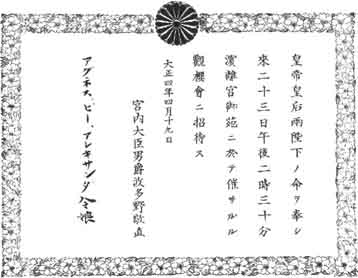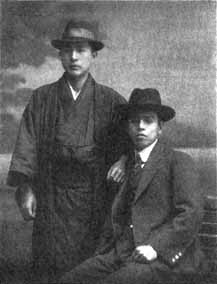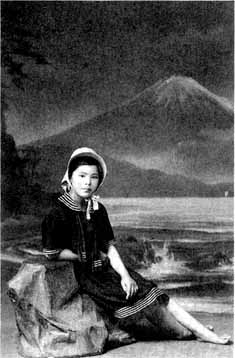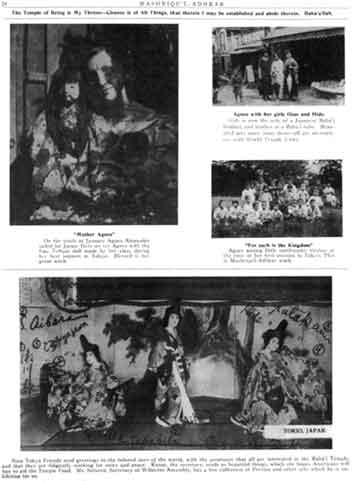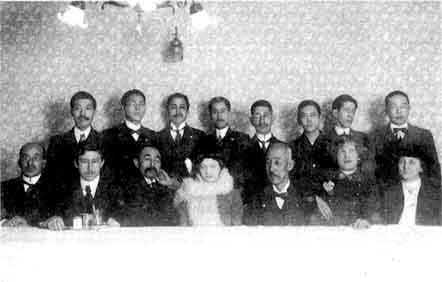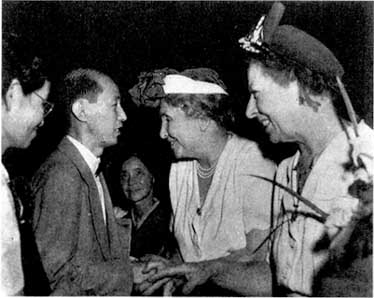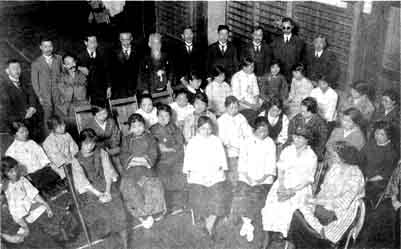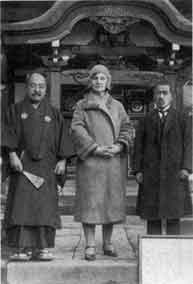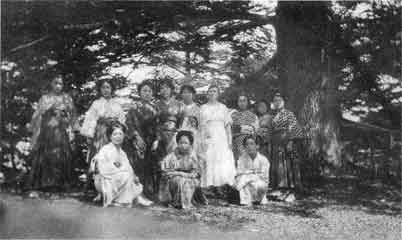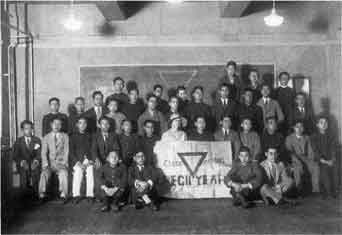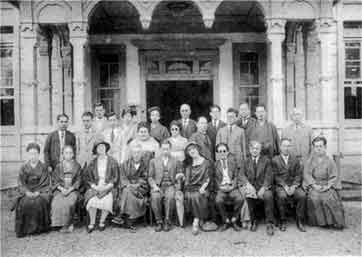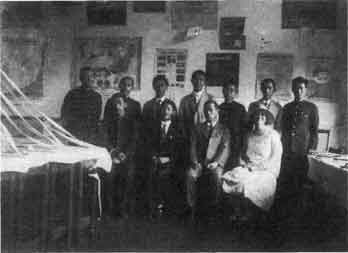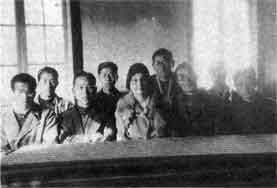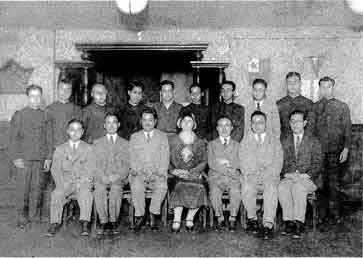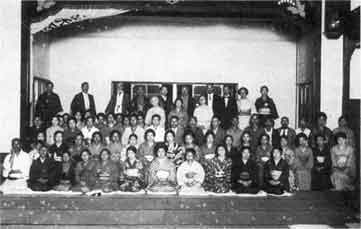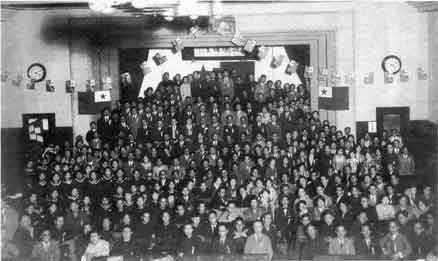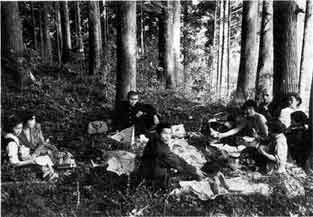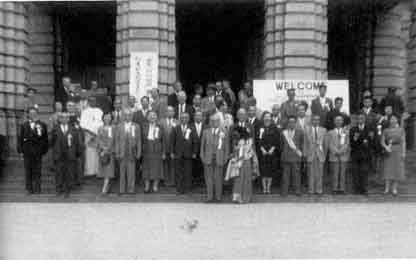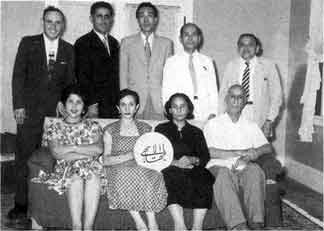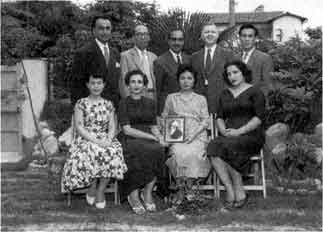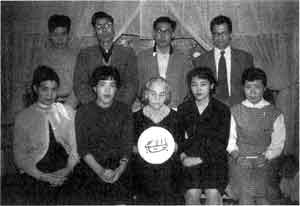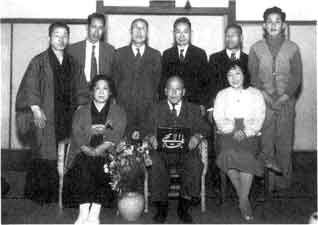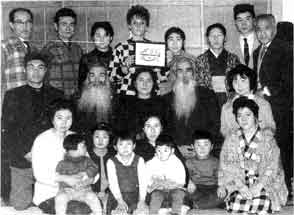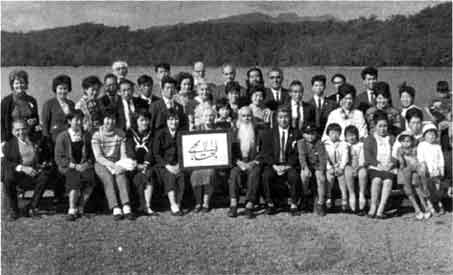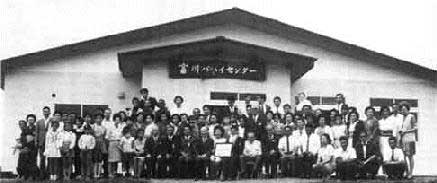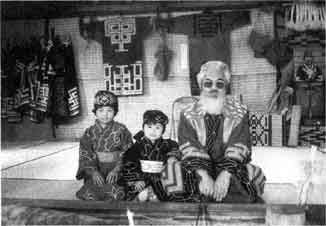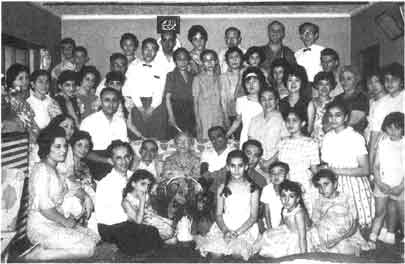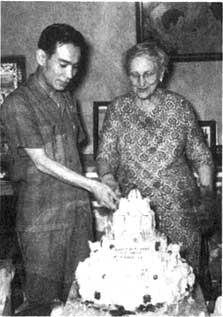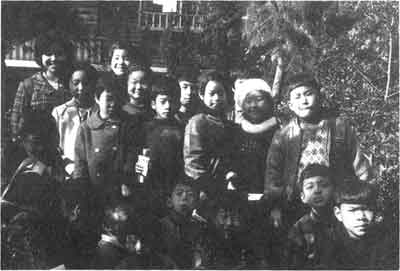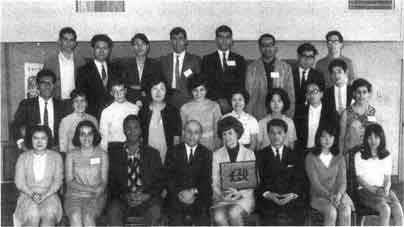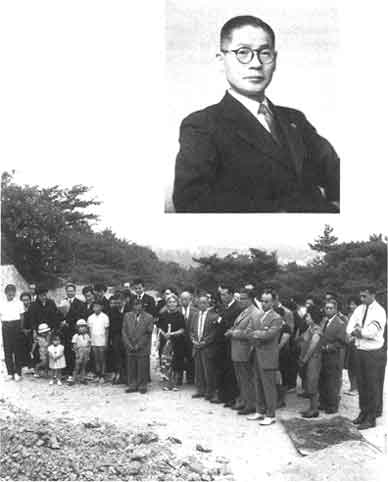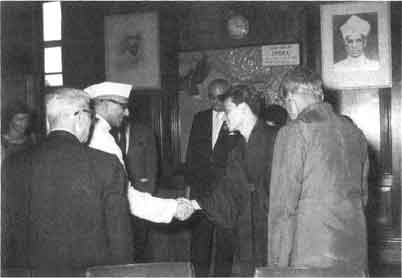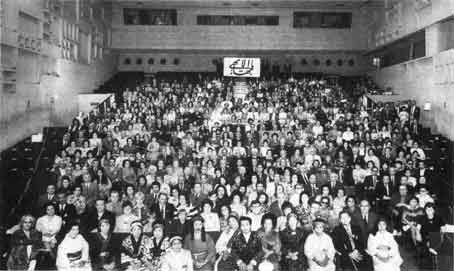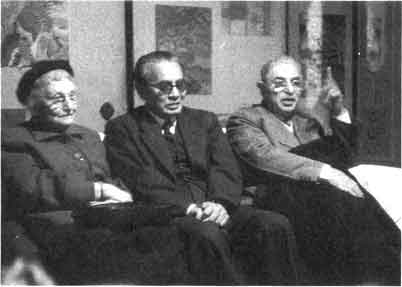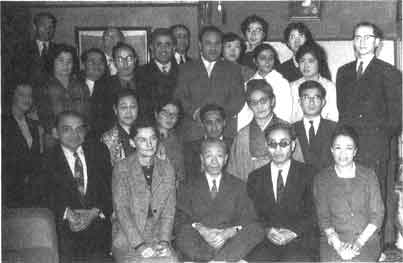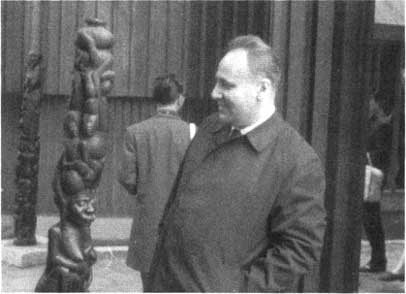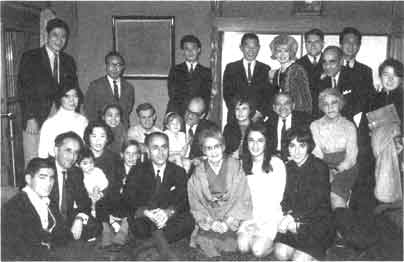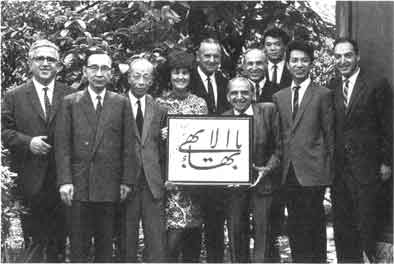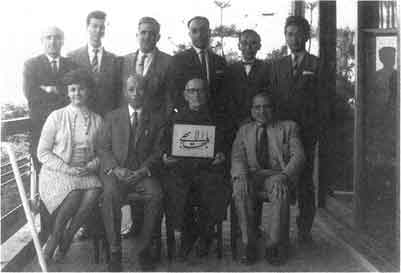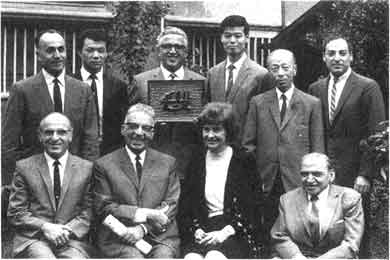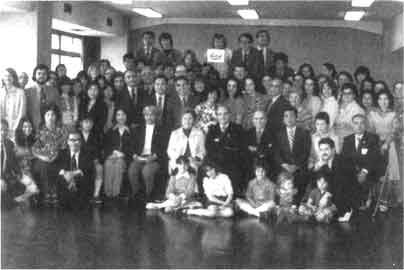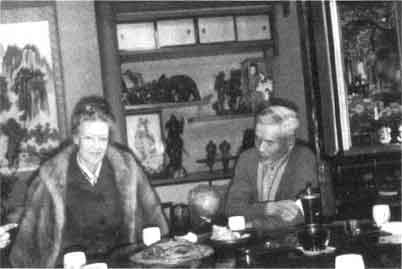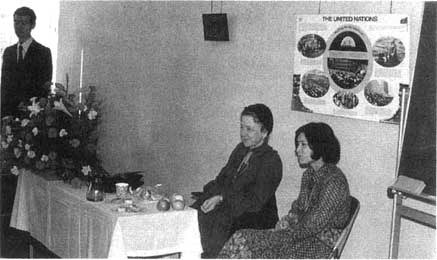
|
|
Abstract: Extensive history of Bahá'í events and personages in Japan, 1914-1983. Notes: See also Errata for Traces that Remain and Japan Will Turn Ablaze.
Proofread by S. Sims and updated August 2019. |
Traces That Remain:
A Pictorial History of the Early Days of the Bahá'í Faith among the Japanese
by Barbara R. Sims
edited by Sheridan SimsTokyo: Bahá'í Publishing Trust of Japan, 1989
| start page |
All chapters
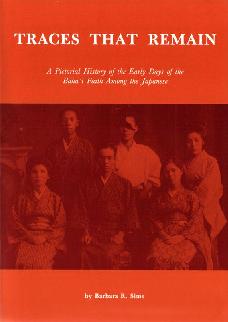 (click for larger) |
Copyright © Barbara R. Sims, 1989
Digital text (with minor revisions) © 2000 by Barbara R. Sims |
Contents
Frontispiece ..............................................................................i
Dedication ...............................................................................ii
Foreword ................................................................................iii
1. 'Abdu'l-Bahá in Oakland, California in 1912 ...............................................1
2. The First Bahá'í Group in the Pacific .....................................................8
3. The First Japanese Bahá'ís ...............................................................10
4. 'Abdu'l-Bahá's Prayer for Japan ..........................................................23
5. The First Public Meeting in Japan ........................................................24
6. Miss Agnes B. Alexander, Daughter of the Kingdom .........................................26
7. Dr. George Jacob Augur ...................................................................30
8. The First Photograph of a Bahá'í Meeting in Japan ........................................33
9. A Garden Party ...........................................................................34
10. A Gathering to Meet Tagore of India ......................................................35
11. Mr. Kikutaro Fukuta ......................................................................35
12. Miss Yuri (Yuriko) Mochizuki .............................................................37
13. A Bahá'í Girls' Class in Tokyo ...........................................................38
14. The Faith Spreads to Kobe in 1920 ........................................................40
15. A Christmas Party in Tokyo, 1920 .........................................................41
16. Mrs. May Bolles Maxwell ..................................................................42
17. Japanese Dolls to Sell for the House of Worship ..........................................43
18. Auntie Victoria ..........................................................................44
19. Mr. Tokujiro Torii .......................................................................47
20. Akira Torii ..............................................................................49
21. The Blind in Japan Receive the Light .....................................................51
22. Mr. Daiun Inouye and Mr. Sensui Saiki ....................................................54
23. Mrs. Ida Finch ...........................................................................56
24. The Faith Reaches Korea from Japan in 1921 ...............................................58
25. Viscount Eiichi Shibusawa ................................................................62
26. Confirmed Bahá'ís, 1922 ..................................................................64
27. Mr. Susumu Aibara ........................................................................65
28. The Kanto Earthquake .....................................................................67
29. China ....................................................................................72
30. Miss Martha Root and Mrs. Keith Ransom-Kehler ............................................75
31. The Emperor of Japan .....................................................................81
32. Japan Religious Conference ...............................................................82
33. A Meeting at a Buddhist Temple ...........................................................84
34. Beatrice Erskine Lane Suzuki .............................................................84
35. Two Persian Bahá'ís Visit Japan ..........................................................85
36. Miss Alexander Introduces the Faith in Hokkaido ..........................................88
37. Dr. Rokuichiro Masujima ..................................................................90
38. The First Local Spiritual Assembly in Japan ..............................................92
39. Kudan Ue .................................................................................93
40. Esperanto and English Clubs, and Other Organizations .....................................93
41. The Crossing ............................................................................110
42. A Tea Party .............................................................................111
43. Mr. Fujita's Mother .....................................................................112
44. A Japanese Scroll Hangs in the Holy Land ................................................113
45. In the Holy Land ........................................................................114
46. The Years Between and the Later Years ...................................................115
47. Naw-Rúz, 1948 ...........................................................................119
48. At Kudan ................................................................................120
49. In Tokyo ................................................................................121
50. Two Bahá'ís .............................................................................126
51. The First Persian Pioneer Families Settle in Japan, 1953 ................................126
52. The Faith Spreads to Other Areas ........................................................128
53. A Public Meeting in Osaka and Early Groups ..............................................130
54. The Tokyo Haziratu'l-Quds ...............................................................132
55. The First Asian Regional Teaching Conference and Further Expansion ......................136
56. The First Convention of the Bahá'ís of North East Asia, 1957 ............................145
57. Anthony Yuen Seto, 1890-1957 ............................................................148
58. Early Activities ........................................................................150
59. The First Bahá'í Marriage of Japanese Believers .........................................151
60. Participation in Conferences in the 1950s and 1960s, and One in 1970 ....................153
61. The First Summer School under the Guardian's Six Year Plan for Japan, Takarazuka, 1957 ..160
62. The Development of the Local Spiritual Assemblies in Japan ..............................161
63. Nagasaki, and the First Bahá'ís in Kyushu ...............................................172
64. Expansion in the Late 1950s .............................................................176
65. The Third Summer School .................................................................181
66. In Osaka ................................................................................182
67. Teaching in Hokkaido and the Development of the Faith Among the Ainu ....................183
68. A Bahá'í Children's Class ...............................................................197
69. Delegates to the 1962 National Convention ...............................................197
70. At the London Congress, 1963 ............................................................198
71. The Sixth National Spiritual Assembly of North East Asia.................................199
72. Two Birthday Parties ....................................................................200
73. Dr. Mizuno Speaks at Summer Schools .....................................................202
74. More Activities in the 1960s ............................................................203
75. Hand of the Cause Miss Alexander Spends Two Years in the Hospital in Tokyo ..............208
76. The Ashiya Bahá'í Cemetery ..............................................................211
77. Three Japanese Bahá'ís Abroad ...........................................................213
78. Bernard Leach, English Potter, Author, Artist, Poet, and Bahá'í .........................216
79. The Continental Board of Counsellors ....................................................219
80. Okinawa, Ryukyu Islands .................................................................223
81. The North Pacific Oceanic Conference, Sapporo, Hokkaido, September, 1971 ................227
82. Visits to Japan by Hands of the Cause and Other Special Bahá'ís .........................230
83. The Spiritual Axis Between Japan and Australia .........................................269
Afterword ...............................................................................273
Bibliography ............................................................................276
|
Chapter 1
 click here for larger image |
| (click
for larger picture) |
Miss Alexander first heard of the Bahá'í Faith in 1900 in Rome, where she was visiting relatives, from an American Bahá'í who was returning from her pilgrimage to the Holy Land. Miss Alexander accepted the Bahá'í Faith immediately as truth. The woman gave her Miss May Bolles' (Maxwell) address in Paris. Shortly after, Miss Alexander went to Paris and stayed for three months where she studied the Bahá'í Faith deeply, and from that time until her passing over seventy years later, she never for an instant faltered nor neglected her spiritual duty as she understood it, to tell the joyous news to every soul with whom she came into contact.An artist in Paris made this pencil sketch of the lovely 25-year-old Miss Alexander. It was reported that he said he wished he could have captured the spiritual look in her eyes.
Dedication
We of the later generations thank these two women for their spiritual gift to us.
Tokyo 1989
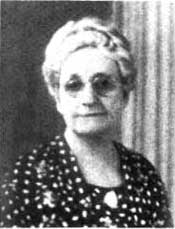 |
 |
| Mary S. Burland | Helen
B. Rutledge |
Foreword
In 1909 someone wrote to 'Abdu'l-Bahá asking if he should print his mother's (Margaret B. Peeke) memoirs.
'Abdu'l-Bahá answered, "Collect the traces of thy mother's pen that they may remain after her."
This book is an attempt, at least in part, to preserve some of the history of the development of the Faith in Japan through early photographs and explanations. It was principally written for present and future generations of Japanese Bahá'ís, that they might know something of the circumstances, and of the early Bahá'ís who laid the foundation of the Faith in their country. As the reader can observe, some of the photographs have faded, or darkened. Some are copies of copies. Nevertheless, they are infinitely precious as traces that remain of the endeavors of the early believers.
1. 'Abdu'l-Bahá in Oakland, California in 1912

click here for larger image
When 'Abdu'l-Bahá went to the United States, one of the places He visited was Oakland, California, which had a fair number of Bahá'ís. This photograph was taken at the home of Mrs. Helen Goodall, one of the early Bahá'ís of that city.The first two Japanese Bahá'ís can be seen in this historic photograph. Mr. Kanichi Yamamoto, front right, is holding his second son, Shinji. His first son, Hiroshi, is in the middle front. At that time Mr. Yamamoto lived with and worked for the Goodall family.
'Abdu'l-Bahá held the three Yamamoto children on His knees, and He gave them Persian names. Mr. Yamamoto arranged for the only talk 'Abdu'l-Bahá gave before a Japanese audience. It was at the Japanese Independent
Church in Oakland. His talk was given in Persian, translated into English, and then into Japanese.Mr. Saichiro Fujita is standing between trees at the top left. 'Abdu'l-Bahá allowed Mr. Fujita to travel with him in the United States, and several years later permitted him to go to the Holy Land to live.
'Abdu'l-Bahá met other Japanese and showed them love and attention. To Mr. Takeshi Kanno, a poet, and friend of the Bahá'ís (seen to the right of 'Abdu'l-Bahá) He gave a rosary.
A talk by 'Abdu'l-Bahá given to a Japanese audience at the Japanese Independent Church, Oakland, California, October 7, 1912
It is a great happiness to be here this evening especially for the reason that the members of this Association have come from the region of the Orient. For a long time I have entertained a desire to meet some of the Japanese friends. That nation has achieved extraordinary progress in a short space of time; a progress and development which have astonished the world. Inasmuch as they have advanced in material civilization they must assuredly possess the capacity for spiritual development. For this reason I have an excessive longing to meet them. Praise be to God! this pleasure is now afforded me, for here in this city I am face to face with a revered group of the Japanese. According to report the people of the Japanese nation are not prejudiced. They investigate reality. Wherever they find truth they prove to be its lovers. They are not attached tenaciously to blind imitations of ancient beliefs and dogmas. Therefore it is my great desire to discourse with them upon a subject in order that the unity and blending together of the nations of the east and the nations of the west may be furthered and accomplished. In this way religious, racial and political prejudice, partisan bias and sectarianism will be dispelled amongst men. Any kind of prejudice is destructive to the body-politic.
When we review history from the beginning of human existence to the present age in which we live, it is evident all war and conflict, bloodshed and battle, every form of sedition has been due to some form of prejudice, whether religious, racial or national, to partisan bias and selfish prejudice of some sort. Even today we witness an upheaval in the Balkans, a war of religious prejudice. Some years ago when I was living in Roumelia,
war broke out among the religious peoples. There was no attitude of justice or equity whatever amongst them. They pillaged the properties of each other, burning each other's homes and houses, slaughtering men, women and children, imagining that such warfare and bloodshed was the means of drawing near to God. This clearly proved that prejudice is a destroyer of the foundations of the world of humanity whereas religion was meant to be the cause of fellowship and agreement.
Religion must be the cause of love. Religion must be the cause of justice, for the wisdom of the Manifestations of God is directed toward the establishing of the bond of a love which is indissoluble. The bonds which hold together the body-politic are not sufficient. These bonds may be mentioned; for instance the bond of patriotism. This is evidently not a sufficient bond, for how often it happens that people of the same nation wage civil war amongst themselves. The bond of fellowship may be racial but history proves this is not sufficiently strong, for tremendous wars have broken out between peoples of the same racial lineage. Again the bond holding men together may be political. How often it happens that the diplomacy of nations makes a treaty of peace one day and on the morrow a declaration of war! It is historically evident and manifest that these bonds are not self-sufficient.
The real bond of integrity is religious in character, for religion indicates the oneness of the world of humanity. Religion serves the world of morality. Religion purifies the hearts. Religion impels men to achieve praiseworthy deeds. Religion becomes the cause of love in human hearts, for religion is a divine foundation, the foundation ever conducive to life. The teachings of God are the source of illumination to the people of the world. Religion is ever constructive not destructive.
The foundation of all the divine religions is one. All are based upon reality. Reality does not admit plurality, yet amongst mankind there have arisen differences concerning the Manifestations of God. Some have been Zoroastrians, some are Buddhists, some Jews, Christians, Muhammadans and so on. This has become a source of divergence whereas the teachings of the holy souls who founded the divine religions are one in essence and reality. All these have served the world of humanity. All have summoned souls to peace and accord. All have proclaimed the virtues of humanity. All have guided souls to the attainment
of perfections but among the nations certain imitations of ancestral forms of worship have arisen. These imitations are not the foundations and essence of the divine religions. Inasmuch as they differ from the reality and the essential teachings of the Manifestations of God dissensions have arisen and prejudice has developed. Religious prejudice thus becomes the cause of warfare and battle.
If we abandon these time-worn blind imitations and investigate reality all of us will be unified. No discord will remain; antagonism will disappear. All will associate in fellowship. All will enjoy the cordial bonds of friendship. The world of creation will then attain composure. The dark and gloomy clouds of blind imitations and dogmatic variances will be scattered and dispelled; the Sun of Reality will shine most gloriously.
Verily we should consider the divine prophets as the intermediaries, but mankind has made use of them as causes of dissension and pretexts for warfare and strife. In reality they were the intermediaries of love and reconciliation. If they were not sources of love and fellowship amongst men, then undoubtedly they were not true, for the divine wisdom and purpose in sending the prophets was the manifestation of love in human hearts. Therefore we must investigate reality. First of all let us determine whether these prophets were valid or not by using rational proofs and shining arguments, not simply quoting traditionary evidences, because traditions are divergent and the source of dissension.
Among the holy, divine Manifestations of God was His Holiness Moses. The sending of prophets has ever been for the training of humanity. They are the first educators and trainers. If Moses has developed the body-politic, there is no doubt that he was a true teacher and educator. This will be proof and evidence that he was a prophet. We shall consider how His Holiness was sent to the children of Israel when they were in the abyss of despair, in the lowest degree of ignorance and heedlessness, degraded and under conditions of bondage. His Holiness Moses rescued these degraded people of Israel from that state of bondage. He raised them from that condition of ignorance, saved them from barbarism and led them into the Holy Land. He educated them, endowed them with sagacious instincts, made them worthy and honorable. He civilized them, raised them to a higher plane of existence until they were enabled to establish a national
sovereignty, the great kingdom of Solomon. This proves that His Holiness Moses was a teacher and an educator. He had neither army nor dominion, neither did he possess wealth. It was only through an idealistic power that he cemented them together proving that he was a prophet of God, an educator and trainer.
Likewise must we set aside prejudice in considering other divine educators, by investigating reality. For instance, let us take His Holiness Christ. He achieved results greater than Moses. He educated the body-politic, trained mighty nations. There is no doubt whatever that such souls were prophets, for the mission of prophethood is education, and these wondrous souls trained and educated mankind.
His Holiness Christ was a unique personage, without helper or assistant. Single and solitary he arose to train great and mighty nations; the Romans, Greeks, Egyptians, Syrians, Chaldeans and Assyrians came under his influence. He was able to bind together many nations, melting them together as it were and pouring them into one mould, changing their enmity into love, war into peace. Under his influence satanic souls became veritable angels, tyrannical rulers became just, the human moral standard was raised. This proves that His Holiness Christ was an educator, a teacher and trainer of nations. If we deny this it is nought but injustice.
Blessed souls whether Moses, Jesus, Zoroaster, Krishna, Buddha, Confucius, or Muhammad were the cause of the illumination of the world of humanity. How can we deny such irrefutable proof? How can we be blind to such light? How can we dispute the validity of His Holiness Christ? This is injustice. This is denial of reality. Man must be just. We must set aside bias and prejudice. We must abandon the imitations of ancestors and forefathers. We ourselves must investigate reality and be fair in judgment.
The old nation of Persia denied all these facts, harboring the utmost hatred and enmity toward other religious beliefs besides their own. We have investigated reality and found that these holy souls were all sent of God. All of them have sacrificed life, endured ordeals and tribulations in order that they might educate us. How can such love be forgotten? The light of Christ is evident. The candle of Buddha is shining. The star of Moses is sparkling. The flame ignited by Zoroaster is still burning. How
can we deny them? It is injustice. It is a denial of complete evidence. If we forsake imitations all become united and no differences will remain to separate us.
We entertain no prejudice against Muhammad. Outwardly the Arabian nation was instrumental in overthrowing the Parsee dominion, the sovereignty of Persia. Therefore the old Parsee nation manifested the utmost contempt toward the Arabs. But we deal justly and will never abandon the standard of fairness. The Arabians were in the utmost state of degradation. They were bloodthirsty and barbarous, so savage and degraded that the Arabian father often buried his own daughter alive. Consider, could any barbarian be lower than this? The nation consisted of warring, hostile tribal peoples inhabiting the vast Arabian peninsula, and their business consisted in fighting and pillaging each other, making captive women and children, killing each other. Muhammad appeared among such a people. He educated and unified these barbarous tribes, put an end to their shedding of blood. Through his education they reached such a degree of civilization that they subdued and governed continents and nations. What a great civilization was established in Spain by the Muhammadans! What a marvelous civilization was founded in Morocco by the Moors! What a powerful caliphate or successorship was set up in Baghdad! How much Islam served and furthered the cause of science! Why then should we deny Muhammad? If we deny him we awaken enmity and hatred. By our prejudice we become the cause of war and bloodshed; for prejudice was the cause of the tremendous storm which swept through human history for thirteen hundred years and still continues. Even now in the Balkans a commotion is apparent, reflecting it.
The Christian people number nearly three hundred millions and the Muhammadans about the same. It is no small task to do away with such numbers. And furthermore why should they be obliterated? For these are all servants of the one God. Let us strive to establish peace between Christians and Muhammadans. Is it not better? What is the benefit of war? What is its fruitage? For thirteen hundred years there has been warfare and hostility. What good result has been forthcoming? Is it not folly? Is God pleased with it? Is His Holiness Christ pleased? Is Muhammad? It is evident that they are not. The prophets have extolled each other to the utmost. His Holiness Muhammad
declares Christ to be the Spirit of God. This is an explicit text of the Koran. He declares Christ to be the Word of God. He has eulogized the disciples of Christ to the utmost. He has bestowed upon Her Grace Mary, the Mother of Christ, the highest praise. Likewise His Holiness Christ has extolled Moses. He spread broadcast the old testament, the Torah, and caused the name of Moses to reach unto the east and west. The purpose is this; — that the prophets themselves have manifested the utmost love toward each other but the nations who believe and follow them are hostile and antagonistic among themselves.
The world was in this condition of darkness when His Holiness Bahá'u'lláh appeared upon the Persian horizon. He hoisted the banner of the oneness of the world of humanity. He proclaimed International Peace. He admonished the Persian nation to investigate reality, announced that religion must be the cause of unity and love, that it must be the means of binding hearts together, the cause of life and illumination. If religion becomes the cause of enmity and bloodshed, then irreligion is to be preferred, for religion is the remedy for every ailment, and if a remedy should become the cause of ailment and difficulty, it is better to abandon it. Today in Persia you will see Muhammadans, Christians, Zoroastrians, Buddhists assembled together in the same meeting, living in accordance with the teachings of Bahá'u'lláh, manifesting utmost love and accord. Rancor, hatred, antagonism and violence have disappeared; they live as one family.
And ye who are the people of the Orient — the Orient which has ever been the dawning-point of lights — from whence the Sun of Reality has ever shone forth casting its effulgence upon the West — ye therefore must become the manifestations of lights. Ye must become brilliant lamps. Ye must shine as stars radiating the light of love toward all mankind. May you be the cause of love amongst the nations. Thus may the world become witness that the Orient has ever been the dawning-point of illuminations, the source of love and reconciliation. Make peace with all the world. Love everybody; serve everybody. All are servants of God. God has created all. He provideth for all. He is kind to all. Therefore must we be kind to all.
I am greatly pleased with this meeting. I am joyous and happy, for here in these western regions I find Orientals seeking education, and who are free from prejudice. May God assist you!
Chapter 2
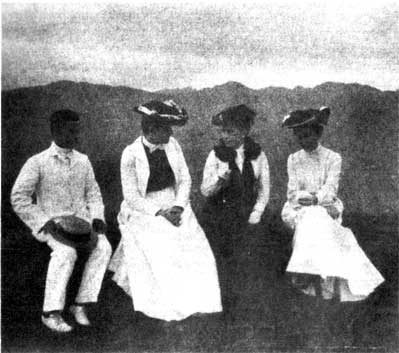
Miss Agnes Alexander wrote of the early days of the Faith in Hawaii, "As there was no home where the group could meet, Miss Muther, Clarence Smith and I would go on Saturday afternoons by trolley car to Pacific Heights. There on the hilltop, surrounded by nature, we would read together the Bahá'í prayers and Tablets which illumined our hearts and minds. Thus began the first Bahá'í meetings in Hawaii."On this day in April 1903, the first photograph of a Bahá'í meeting in the Pacific was taken. Mr. Yamamoto is on the left. Next is Mrs. Anna Bailey, a Bahá'í from Oakland, California, who joined the group that day. Next are Miss Elizabeth Muther and Miss Alexander, who was the first Bahá'í in the Pacific. Mr. Clarence Smith, Hawaii's second believer took the photograph.
Hawaii, 1909. This photograph shows five Bahá'ís who responded to 'Abdu'l-Bahá's wish to take the Faith to Japan. Mr. Howard Struven (far left) and C.M. Remey (middle rear) were on an around-the-world teaching trip, the first ever made by Bahá'ís. They then crossed the Pacific Ocean, stopped in Tokyo and spoke at the YMCA, then to Yokohama, Kyoto, Nagasaki and on to China, Burma, India and other countries.Dr. George Augur (far right) arrived in Japan in 1914. His wife Ruth, (front, far left) joined him on a later trip. They were in Japan off and on until 1919.
Miss Alexander (sitting next to Mrs. Augur) arrived in Japan in 1914 several months after Dr. Augur. Between 1914 and 1967, when Miss Alexander left for the last time, she spent a total of about thirty-one years teaching the Faith in Japan. In 1957 the Guardian appointed her a Hand of the Cause and called her "an exemplary pioneer."
Chapter 3
Mr. Kanichi Yamamoto has the distinction of being the first Japanese Bahá'í. He was born in Tosaki, Yamaguchi Prefecture, in 1879. In the very early 1900s he immigrated to Hawaii, which was then a territory of the United States. He found work in the home of Mr. and Mrs. William Smith in Honolulu. The Smiths' son, Clarence, had learned of and accepted the Faith through Miss Agnes Alexander. In the Smiths' home lived Miss Elizabeth Muther. After Miss Muther became a Bahá'í she longed to tell Mr. Yamamoto of the Faith.
Mr. Yamamoto was raised as a Buddhist but he had become a Christian and was trying to live a Christian life. He told Miss Muther that it was lonely because he was the only Christian among his Japanese friends.
Mr. Yamamoto accepted the Faith almost immediately. His English at the time was limited but he said he knew it was the Truth in his heart.
It was 1902 and he was just 23. Two years later Mr. Yamamoto went to Oakland, California to work in the home of Mrs. Goodall. Four years later he was married to a young woman, Ima, who had come to California from Japan to marry him. There is no record that Ima became a Bahá'í, but she was part of the community, a pretty, sweet woman whom everyone liked.
Most of the meetings in that area were held in the Goodall home and the Yamamotos helped to take care of the guests and made everyone feel welcome.
The Yamamoto family eventually moved to Berkeley, California. The children attended Bahá'í children's classes given by Mrs. Kathryn Frankland. It was she who first taught Mr. Saichiro Fujita, who was the second Japanese to embrace the Teachings of Bahá'u'lláh.
When Mr. Yamamoto first became a Bahá'í he wrote to 'Abdu'l-Bahá of his acceptance of Bahá'u'lláh as the Manifestation
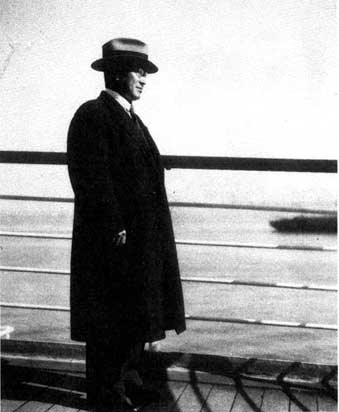
Mr. Kanichi Yamamoto. "0 thou ... unique one of the extreme Orient!" ('Abdu'l-Bahá, 1904) This photograph was taken about 1939.
for this day. He felt that his English was so poor that he could not write his letter in that language so he wrote it in Japanese. Of course, no one in the Holy Land could read Japanese. It is recorded by 'Abdu'l-Bahá's secretary that 'Abdu'l-Bahá said He would turn to Bahá'u'lláh to be guided to answer.
The Master's answers to Yamamoto's letters, as he apparently wrote several times, were full of significance. He advised Yamamoto to bear every difficulty and hardship. 'Abdu'l-Bahá Himself taught Yamamoto. In the early days of the Faith very little was translated from the Writings of Bahá'u'lláh. 'Abdu'l-Bahá wrote many letters to the believers. These letters, because of their precious nature are called Tablets. People would write asking questions, or often they just wanted to express their love for Him. 'Abdu'l-Bahá would answer telling them how fortunate
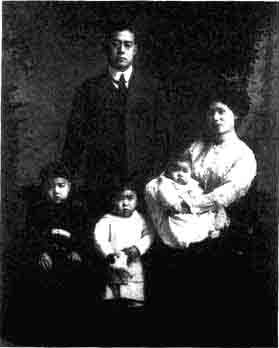
click here for larger image
Mr. Kanichi Yamamoto and his family in 1913. Hiroshi is to the left, then Shinji. Mrs. Ima Yamamoto is holding Masao.
For example, 'Abdu'l-Bahá wrote to Mr. Yamamoto, "All the sects and people ... create a God in their own minds and acknowledge him to be the creator of all things." "The Essence of the Divine Entity . . . is holy above imagination and beyond thought. Consciousness doth not reach It. ... it is a different world; from which there is no information; arrival thereat is impossible; attainment thereto is prohibited and inaccessible. This much is known. It exists...
'Abdu'l-Bahá called Mr. Yamamoto "unique". Not only was
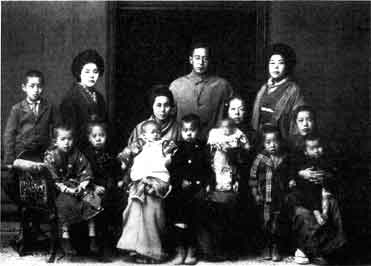
click here for larger image
This family photograph was taken in 1919 on the eve of Mr. Yamamoto's departure from Yamaguchi Prefecture to go back to the United States with four of his sons. In the back row are Hiroshi, Yamamoto's younger sister. Mr. Yamamoto and his second sister. In the front row a cousin, then Shinji (who gave us this picture), Yamamoto's oldest sister holding a baby (unidentified). Masao, Mr. Yamamoto's mother holding Fumiko, Michiaki and a relative holding Goro.
'Abdu'l-Bahá asked Mr. Yamamoto and Mr. Fujita to become the cause of the spiritual development in Japan, and He said unless man makes spiritual progress he cannot realize true material progress.
Mr. Yamamoto was indeed a cause of the spiritual development, not only of Japanese, but others as well, because now over eighty years later we are reading and pondering the answers of 'Abdu'l-Bahá to Mr. Yamamoto.
The Yamamoto line of Bahá'ís is now in the fourth generation with the birth of Michael Kanichi Yamamoto in 1979, named after his esteemed great-grandfather. The Japanese community owes thanks and gratitude to Mr. Kanichi Yamamoto — the first of his race to arise for Bahá'u'lláh in this day.

click here for larger image
This photograph was taken in 1937 and shows Yamamoto with his wife, Tame. In the back row are the children by his first wife, Ima, who died after the birth of Fumiko. From the top left are Masao, Shinji, Hiroshi, Michiaki, Goro and Fumiko.
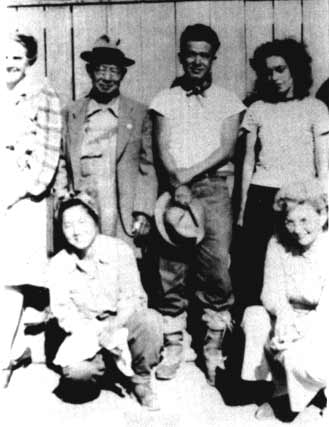
May 1942, Parlier, California, near an Assembly Center established by the U.S. military to process Japanese-Americans forcibly evacuated from the Pacific coast at the outset of WWII. The Yamamoto family had been obliged to relocate to Parlier, and later in 1942 most of the family were sent to a Relocation Center, or permanent internment camp, at Gila River, Arizona, where they stayed for the duration of the war. Ironically, one son, Masao, served in the U.S. armed forces during that time.To the left is Mrs. Ramona Allen Bray (later Brown), and to the right Mrs. Marzieh Gail, both renowned Bahá'í writers. Mr. Kanichi Yamamoto is standing with his son Goro, and daughter Fumiko is kneeling. Kneeling on the right is Mrs. Margaret Cavanaugh, sister of the compiler.
Mrs. Bray, Mrs. Gail, Mrs. Cavanaugh and Mr. Robert Gulick (who took the picture), stopped by to see the Yamamotos on their way back to Berkeley, California after attending the National Convention in Chicago. The Yamamotos were also from Berkeley.
At Parlier they had to work in the fields. Mrs. Cavanaugh recalls how Fumiko's hands were cracked and red from the heavy work which she was unaccustomed to doing.
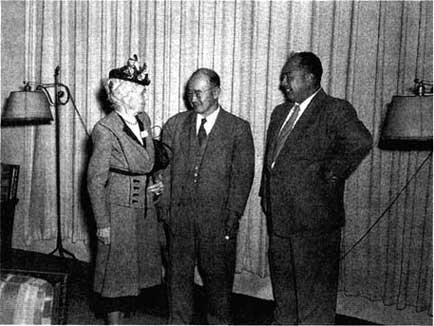
Mrs. Kathryn Frankland greets her dear old friends, Mr. Kanichi Yamamoto and his oldest son Hiroshi, at the American National Bahá'í Convention in 1948.
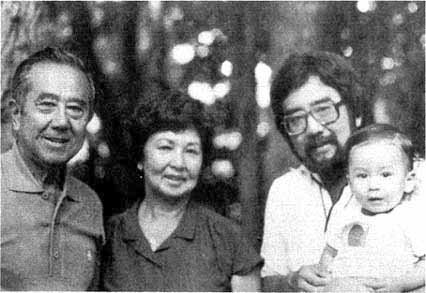
Three generations of Bahá'ís. Mr. Shinji Yamamoto and his wife Hifumi. Their son, Dr. Stephen Yamamoto is holding little Michael Kanichi. This was taken in the United States in 1980.
Mr. Saichiro Fujita, 1886-1976
Mr. Fujita went to the United States when he was just a teenager as he wanted to complete his education there. While he was in school, he went to work in the home of Mrs. Kathryn Frankland. She had a great love and affinity for the Japanese and had also helped to teach Mr. Yamamoto and his children.
Mr. Fujita accepted the Faith in 1905. The American Bahá'ís had trouble pronouncing Fujita's name so while there he took the first name, Harriston, but that was eventually dropped and
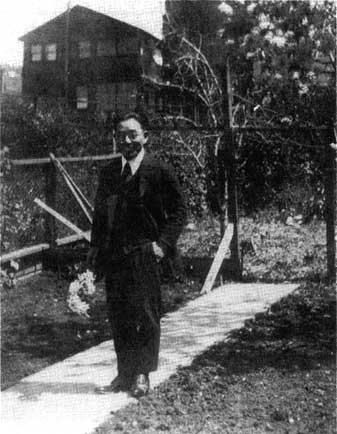
17
When 'Abdu'l-Bahá made His trip to America, Fujita met Him in Cleveland, where he was staying with some Bahá'ís. 'Abdu'l-Bahá invited Fujita to travel with Him, so Fujita joined the group. Fujita expressed the desire to return to the Holy Land with 'Abdu'l-Bahá, and spend the rest of his life serving Him.
'Abdu'l-Bahá accepted Fujita's offer but for the next seven years guided Fujita's studies in the United States for the special services that he would do in the Holy Land. In 1919 Fujita left for the Holy Land and stayed until 1938. He helped in many ways; he maintained 'Abdu'l-Bahá's car; he installed some of the electric wiring; he assisted in making the gardens beautiful; he took good care of the pilgrims.
Perhaps one of his greatest services was at the saddest time in his life, just after the passing of 'Abdu'l-Bahá in 1921. 'Abdu'l-Bahá's sister, Bahiyyih Khanum, known as the Greatest Holy Leaf, took over the affairs of the Faith until Shoghi Effendi returned to Haifa to assume his duties as Guardian of the Faith. As Fujita's English was fluent, he wrote letters at the direction of the Greatest Holy Leaf. It was Fujita who informed the Japanese Bahá'ís of events at that critical time. Some of those letters written by Fujita on behalf of the Greatest Holy Leaf are
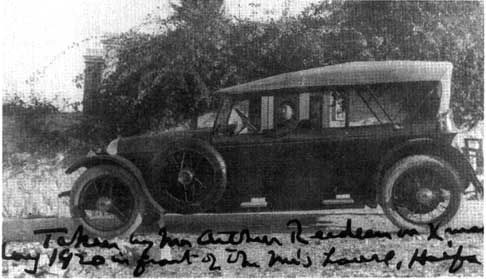
1920. Fujita sitting at the wheel of 'Abdu'l-Bahá's automobile. He accompanied this automobile from the United States to the Holy Land in 1919.
After the passing of 'Abdu'l-Bahá, Fujita served the Guardian with the same love and zeal as he had 'Abdu'l-Bahá. The Guardian was concerned about the safety of Fujita as the clouds of World War II loomed, and arranged for him to return to Japan in 1938 to live with his family in Yamaguchi Prefecture.
In 1955 the Guardian permitted him to return to the Holy Land. Fujita received the good news via the Tokyo Local Spiritual Assembly. He wrote to the Tokyo Assembly that it was the greatest joy and happiness of his life to be able to return to the Holy Land. Shortly after his participation at the Nikko Conference he left Japan.
His loving and humorous nature was the cause of delight of numerous pilgrims. Some of us met him in the Holy Land in the later years where he was actively serving the Universal House of Justice. He said he was sometimes lonesome but we understood that he was not lonesome for Japan, but for the Master and for the Guardian.
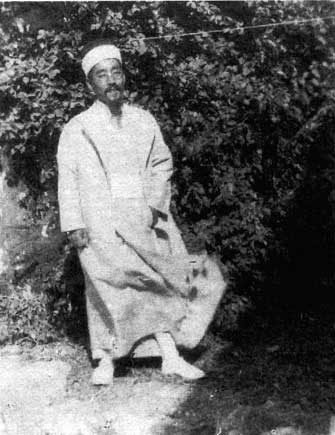
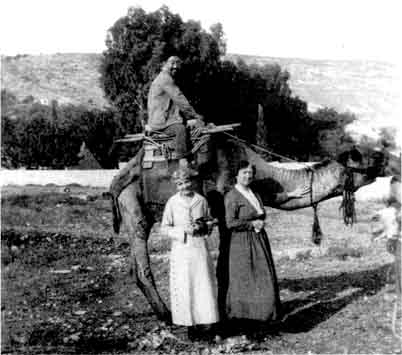
click here for larger image
Riding a camel in front of the Pilgrim House in Haifa. The ladies were unidentified but the one on the left looks like Mrs. Frankland.

click here for larger image

1968. Fujita was happy to see National Spiritual Assembly members from Japan during the 1968 International Convention in the Holy Land, when this photograph was taken.
Mr. Torikai received one Tablet from 'Abdu'l-Bahá who urged him to illumine his own land (Japan). Only that much is known of the Tablet as no copy remains. Mr. Torikai visited Japan in 1916/17, met Miss Alexander and Mr. Torii, and formed a friendship with them. During that trip he wrote the first original
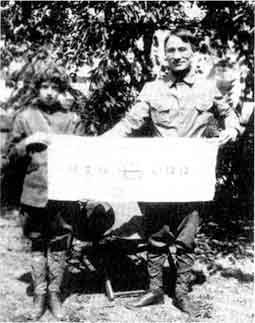
click here for larger image
The above photograph of Mr. Torikai was taken the summer of 1917 when he returned to Seattle after a visit to Japan. He sent it to the Bahá'ís in Japan. The banner says "Bahá'í Shin Bunmei" (Bahá'í New Civilization).
pamphlet in Japanese. Previous ones were translations. It was called "Sekai Shin Bunmei" (New World Civilization). This pamphlet was spread about Japan.
Mr. Torii transcribed part of the pamphlet into Japanese Braille, combining it with other material and used it as a text for Braille classes which he taught. It was called "Motomeyo Saraba Ataeraren" (Seek and It Shall Be Given You). It was the first Japanese Braille Bahá'í pamphlet.
Mrs. Torii recalls that Mr. Torikai travelled from Tohoku to Kyushu speaking of the Faith. He would wear a headband on which was written "Jinrui Goitsu" (Oneness of Mankind) in Japanese. He also carried a banner which he would spread out.
Mr. Torikai went to Peru to live in the 1920s and as there was no Bahá'í activity there in those early days, he lost track of the Bahá'ís. Eventually he came back to Japan, where he died. We were able to find some of his relatives. His cordial wife, Yoshie, who was considerably younger than her husband, said if he had been able to see any Bahá'ís in Japan in the later years it would have made him very happy.
Chapter 4
Miss Alexander had contact for many years with Japan Women's University. She knew that the founder and first president, Mr. Jinzo Naruse had met 'Abdu'l-Bahá in London in 1912.
After she arrived in Japan in 1914, she contacted Mr. Naruse. He asked her to speak in the university chapel. She spoke there at least one other time at the invitation of the second president, Mr. Aso. Mrs. Keith Ransom-Kehler also spoke in the chapel in 1931.
Miss Alexander was acquainted with the first four presidents of the university. The third was Viscount Eiichi Shibusawa, the friend who gave her introductions to prominent people in Korea (see Ch. 24). The fourth president was Mrs. M.H. Inouye, who wrote an interesting article for the Bahá'í World Vol. V.
Mr. Jinzo Naruse, Viscount Shibusawa, and Dr. Masaharu Anesaki, all famous names in Japanese history, started a peace movement called "Concordia." Mr. Naruse, founder of the first

click here for larger image
'Abdu'l-Bahá's prayer for Japan
Chapter 5
The first Bahá'í public meeting in Japan was held in 1909 at the Tokyo YMCA building, one of the largest buildings in Tokyo at that time. Mr. Howard Struven and Mr. C.M. Remey were on their round-the-world teaching trip and Japan was their first stop after Hawaii. About seventy-five people came to the meeting, Japanese, Hindus, Americans and an English lady.
After traveling through and teaching in several countries the two men eventually arrived in the Holy Land, and in the Presence of 'Abdu'l-Bahá. Some years later Mr. Struven wrote
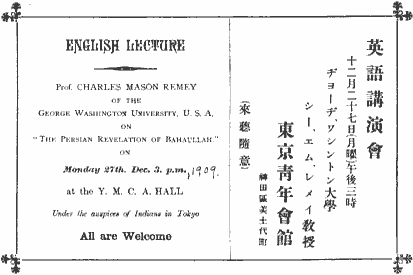
click here for larger image
The invitation to the first Bahá'í meeting in Japan. The year was not printed and Miss Alexander wrote it in later in this copy, the only one we know of in existence.

The original YMCA building in Tokyo.
25
The original YMCA building was destroyed during the 1923 Kanto earthquake. Until that time many Bahá'í meetings had been held there. Another building was constructed on the same site in 1928 and continued to be used periodically for Bahá'í meetings. Dr. Augur, Miss Martha Root and Mrs. Keith Ransom-Kehler all spoke at the "Y." Miss Alexander had English classes there during which she taught the Faith. She wrote of those times, "So many opportunities were given to me to speak of the Cause until I felt the stones of the building must vibrate with God's Message."
Chapter 6
The single person who has had the most profound influence upon the spiritual destiny of the Japanese people has been Miss

click here for larger image
Miss Alexander with her mother and father in their comfortable home in Hawaii in the early 1900s.
Agnes Alexander. The Guardian wrote to her (1933), "Your name will forever remain associated with the rise of the Faith and its establishment in Japan and the record of your incessant and splendid endeavors will shed on its annals a lustre that time can never dim."
Miss Alexander was raised in the late 1800s in Hawaii in a prosperous family. Her grandfather was one of the first Christian missionaries to Hawaii and she was a devout Christian in those early years.

click here for larger image
Hand of the Cause Miss Agnes B. Alexander, 1875-1971. Miss Alexander as she looked in 1900 about the time she accepted the Faith. She received over a dozen Tablets from 'Abdu'l-Bahá. He called her the Herald of Truth in Japan and said she would be confirmed, assisted and exalted. He wrote, "...the doors of the Kingdom of God are open..." "...In such a time patience and tranquility are not allowable."

| Miss Alexander enjoys the garden of the Imperial Hotel in Tokyo, 1919. | In the Japanese kimono. |

In the front room of her house in Sakura, Tokyo, Christmas 1930.
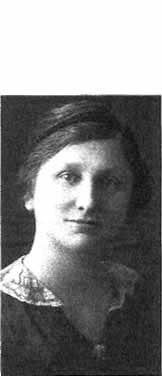 |

|
| Daughter of the Kingdom! | Miss Alexander liked cats. |
In 1900, when she was twenty-five years old she heard of the Faith in Italy, where she had gone to visit a relative. She went to Paris afterward and stayed several months studying the newly accepted Faith with some of the very early Bahá'ís, among them Miss May Bolles (later Mrs. Maxwell.)
Miss Alexander then returned to her home in Honolulu, Hawaii. She was the first Bahá'í in the Pacific area. She taught her friends, and a firm foundation was soon laid for the Faith in that land.
Miss Alexander said even in those days she had an interest in Japan. In the early 1900s she attended a lecture in Honolulu given by Mrs. Ume Tsuda, founder of Tsuda College in Tokyo, a famous private school for women. She took notes on the interesting lecture and from then on wanted to visit far-off Japan.
After she became a Bahá'í, Miss Alexander wrote occasionally to 'Abdu'l-Bahá. He favored her with several Tablets. In two of them He suggested that she go to Japan but wrote that she was free to decide. She had such deep faith that she felt she must do as 'Abdu'l-Bahá wished. It was in 1914 that she finally
Another American Bahá'í had arrived in Tokyo a few months before, Dr. George Augur. He and Miss Alexander started discussion groups. Their efforts were to have far-reaching effects. As Miss Alexander gradually made Japanese friends, she would encourage those who were attracted to the Faith to write to 'Abdu'l-Bahá. He always answered. It is a blessing forever for the Japanese people that because of Miss Alexander's efforts we have copies of eighteen Tablets from 'Abdu'l-Bahá written to the Japanese, and one to Koreans. Korea was under Japanese rule at that time.
Chapter 7
Dr. Augur was a homeopathic physician who accepted the Faith while living in Hawaii. He was favored with six Tablets from 'Abdu'l-Bahá. He had visited Japan and had become so attracted to the country that he wished to return to teach the Faith. When he wrote of his desire, 'Abdu'l-Bahá answered ".... Travel thou to Japan and lay there the foundation of the Cause
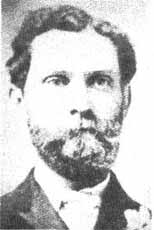
Disciple of 'Abdu'l-Bahá, Dr. George Jacob Augur (1853-1927)
30

Dr. Augur and his wife Ruth.
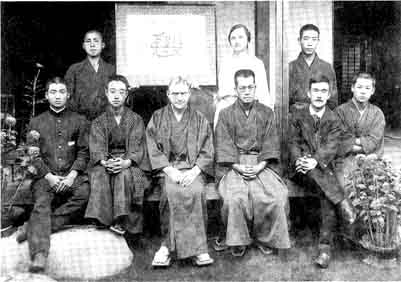
click here for larger image
Tokyo, October 1916. At the top left is Mr. Kikutaro Fukuta, the first Japanese living in Japan to declare his Faith. Next is Miss Alexander, then Mr. Ishida. Bottom row: Mr. Yoshio Tanaka, who became a Bahá'í, and Mr. Masaru Mizutani, Dr. Augur, Mr. Yuzuru Kawai, then the famous writer Mr. Ujaku Akita and Mr. Morishita. Morishita, Ishida and Kawai were Waseda University students who were friends of Akita. All attended Bahá'í meetings held by Miss Alexander and Dr. Augur.Mr. Tanaka recalls that he met Dr. Augur in a public bath. Dr. Augur was already wearing the Japanese dress, the kimono. Although they didn't have much communication at that time, Dr. Augur recommended that Mr. Tanaka visit Miss Alexander.
In 1914, a few months before Miss Alexander arrived, Dr. Augur came to Tokyo to stay. He wrote one of the early pamphlets in Japan quoting part of one of his Tablets from 'Abdu'l-Bahá.
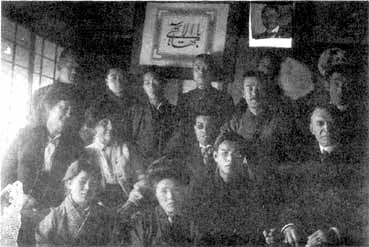
click here for larger image
This photograph from Mr. Torii's album was designated as a farewell party for the Augurs. It was probably taken in 1919.In the front row is Miss Mochizuki, Mrs. Torii, Mr. Torii and Dr. Augur. In the second row is Mrs. Augur. Sitting next to her is thought to be a friend, Mrs. Hodgson. Some of the others in the photo were attracted to the Faith and continued to come to meetings. Among those, Mr. Akita (with mustache under the inset), did much service for the Faith as he translated and wrote articles about the Faith which were published. However, in later years he became politically motivated and lost his connection with the Faith.
Chapter 8
8. The First Photograph of a Bahá'í Meeting in Japan
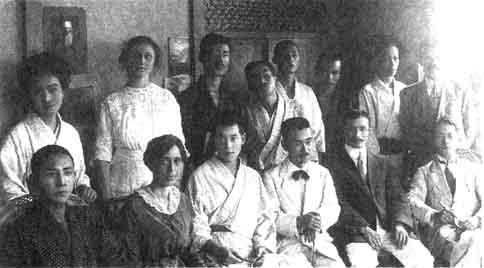
click here for larger image
This photograph was taken in Tokyo, July 18, 1915. Miss Alexander wrote that it was the first picture of a Bahá'í meeting in Japan. It was taken on the occasion of Miss Martha Root's visit to Japan. Of course, Bahá'í meetings were being held regularly but on this occasion Miss Alexander called in a photographer to record the meeting with Miss Root. It should be remembered that in those days, personal cameras were rather rare, and the very early photographs which Miss Alexander had in her possession were usually taken by professional photographers.In the front, far left, is Mr. Fukuta, the first person to accept the Faith in Japan, just two months before. Next to him is Miss Root. Fourth from the left is Mr. Akita. Mr. Kenichi Takao is next to him on the right. In this group, aside from Miss Alexander and Miss Root, only Mr. Fukuta became a Bahá'í although many were good friends. Miss Alexander is behind Miss Root. Standing to the left is Miss Ichi Kamichika, who helped Miss Alexander translate some pamphlets. She wrote for a newspaper at the time and had 'Abdu'l-Bahá's picture published in it, the first time His picture was published in Japan. Miss Kamichika became famous in Japanese politics many years later as one of the first women to be elected to the Japanese Diet (Parliament). She was also one of the early leaders of the women's rights movement in Japan.
Years later, in 1977, the compiler was able to meet and interview her.
She was then eighty-eight but still possessed considerable charm. She could barely recall Miss Alexander but thought they lived in the same building. She helped Miss Alexander by translating, and Miss Alexander helped her with her English.
Miss Kamichika (right) in 1977, in the library of her home, being interviewed by Mrs. Sims.
Chapter 9
9. A Garden Party
click here for larger imageMiss Alexander received an invitation to a cherry-blossom viewing party given by the Emperor on April 23, 1915.
Chapter 10
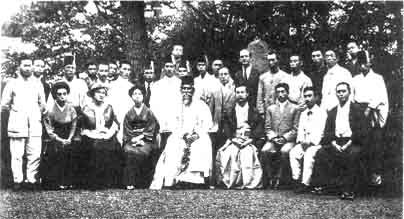
click here for larger image
The Indian poet, educator, dramatist and Nobel Prize Winner, Rabindranath Tagore visited Japan three times. He is in the middle, first row. Miss Alexander is sitting between two women, who were identified by Mrs. Furukawa as being teachers of Japan Women's College. She also thought the picture was taken in Dr. Masujima's garden. Professor Nakagiri of Waseda University is sitting to the right of Tagore. Miss Alexander's friend, Ujaku Akita, is sitting second from the right. This photograph was undated but was probably taken in 1916 during Tagore's first visit. Tagore was aware of the Faith. He had met 'Abdu'l-Bahá in Chicago, and when he met Miss Root in Hong Kong in 1924 he asked her how the Faith was progressing.
Chapter 11
(1887-1959)
In 1915 a Japanese schoolteacher in Tokyo, Mr. Naito, was instructing Dr. Augur in the Japanese language. Mr. Naito told his students that there was an American lady in Tokyo who was teaching a new religion. Four students came with him to see Miss Alexander, among them, Mr. Fukuta, who was eighteen years old. Mr. Fukuta said later he immediately felt that what Miss
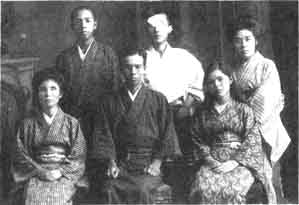
click here for larger image
There is no date for this damaged, but interesting photograph. It was probably taken in 1917. It shows the first three Japanese to become Bahá'ís in Japan. Miss Yuri Mochizuki (later Mrs. Furukawa), right, sitting, Mr. Tokujiro Torii is sitting in the middle. Mr. Fukuta is behind him. Mrs. Torii, who became a Bahá'í in later years is standing. Mr. Torii's brother is standing on the left. Miss Asa Kosugi, who was a friend, is sitting on the left. Miss Kosugi, like Mr. Torii, was blind. She was the first blind woman to attend a university, and later became a prominent educator.
This charming photo of Mr. Fukuta and Mr. Torii was taken in Kyoto in 1917. Mr. Fukuta was twenty and Mr. Torii twenty-three. Mr. Torii is dressed in the Western style; Mr. Fukuta is wearing the Japanese kimono with a modern touch, a Western-style hat. These two, the first men in Japan to embrace the Faith, brought together by the Faith, remained close friends all their lives.
Chapter 12
Miss Mochizuki as a lovely girl of seventeen. It was taken in a professional photographer's studio at Ejiri.
37
Miss Alexander wrote that each morning before Miss Mochizuki went to work they read a verse from "The Hidden Words of Bahá'u'lláh" so that she could understand the meaning. In this way she translated the small book into Japanese. She has updated the style somewhat but her basic translation is still being used.
'Abdu'l-Bahá favored this young woman with three Tablets. He wrote to her, "Japan is like unto a farm whose soil is untouched. Such a soil as this has great capacity. One seed produces a hundredfold."
In 1920 Miss Mochizuki and Miss Alexander decided to publish a Bahá'í journal, which they called the "Star of the East" (Higashi no Hoshi). The first issue was dated October 19, 1920.
It was edited by Miss Mochizuki with the help of Mr. Ono. As Tablets from 'Abdu'l-Bahá to the Japanese were received, they were put into the journal.
When 'Abdu'l-Bahá was notified of the journal He wrote to Miss Mochizuki, "At present thou has started a journal. It is my hope that this journal will shine as a Star of the East." He wrote a long Tablet advising Miss Mochizuki what to put in the journal. (See "Japan Will Turn Ablaze!" for the complete Tablet.)
After editing, proofreading and sending out the "Star of the East" for one year, Miss Mochizuki left Japan to go to France. Mr. Kenji Fukuda, who had been a Christian minister before he found the Faith offered to edit the magazine. With the assistance of Miss Mikae Komatsu it continued for one more year.
Chapter 13

click here for larger image
In 1920, on the Anniversary of the Declaration of the Báb, these girls who were in Miss Alexander's Bahá'í class, wrote a message to 'Abdu'l-Bahá. They wrote in Japanese which Mr. Fujita, who was serving in
38 'Abdu'l-Bahá's home in Haifa, could translate. 'Abdu'l-Bahá lovingly responded, "...Through the Bounties of the Supreme Lord, do I hope that these daughters of the Kingdom will, day by day, progress so that they may, like unto a magnet, attract the Divine Confirmations."
A photographer took this picture of the girls with their Tablet placed on the table. The photograph was then sent to 'Abdu'l-Bahá and He replied with another Tablet calling them daughters of the Kingdom and He expressed the hope that ". . . each one of you will shine like unto a brilliant star from the horizon of the supreme Guidance, thus proving to be the cause of guidance unto others, giving sight unto their eyes, hearing power unto their ears and quickening unto their hearts."
Miss Mochizuki (far right) remained an active Bahá'í through the succeeding years. Miss Otoe Murakami (far left), assisted Miss Alexander in 1923 caring for the earthquake orphans. She is also mentioned as being on the first Local Spiritual Assembly of Tokyo in 1932. Miss Haruko Mori (standing right), wrote a supplication in Japanese to 'Abdu'l-Bahá. He answered, "Praised be unto God, that through the Guidance of Miss Alexander thou couldst hear the Call of God. Then strive as far as thou art able to spread the Divine Teachings, so that thou mayest become distinguished with this great Bestowal among the women of the world." She was one of three Japanese women to receive a personal Tablet from 'Abdu'l-Bahá.
Miss Mori and Miss Murakami were among those who spoke at the memorial of the Ascension of 'Abdu'l-Bahá in December 1921. There were thirty-six people present, only six of them women. In those days for women to speak up publicly before men was rare. Miss Alexander wrote
that their speeches touched the hearts.Miss Mori (Mrs. Shibaya) was located sixty years later in Tokyo. She said she recalled those early days very well and enjoyed the meetings. But Miss Alexander left Japan and the meetings were discontinued. She said she was then married and raised a family, and she lost contact with the others. She recalled that Miss Alexander visited her in the 1930s when she came back to Japan. Miss Mori's Tablet was among her personal possessions which were lost during the war.
Chapter 14

click here for larger image
This was a Bahá'í meeting in a coffee shop in Kobe in 1920. It was arranged by Mr. Sanzo Misawa, one of the early believers, on the occasion of a visit from a friend, the writer Ujaku Akita. Fourteen people came in all, including a newsman who wrote it up for his newspaper. The paper hanging from the table says, "Bahá'í gathering, enter." Notice the picture of 'Abdu'l-Bahá on the table.
Chapter 15
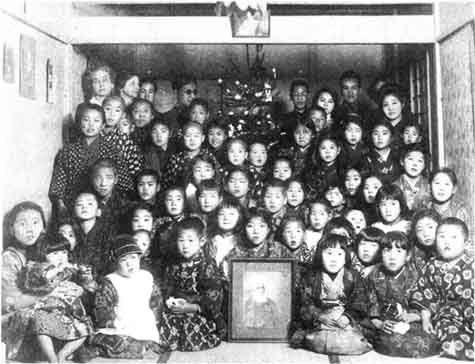
click here for larger image
Shortly before Christmas Miss Alexander had an inspiration to invite the children of the shopkeepers on the street where she lived to a party. Mrs. Finch also attended. The blind Bahá'ís Mr. Tomonaga Noto and Mr. Kenjiro Ono sang for the children, and Miss Mochizuki told them Bahá'í stories. Fifty-eight children attended. The next year at the Christmas party there were seventy-seven and in 1922 more than ninety, including some mothers. The year after, 1923, Miss Alexander was in China on Christmas Day. She wrote that a wave of homesickness came over her to be with the children again.Mrs. Finch and Miss Alexander are at the top, left corner. Mr. Noto (with glasses) is near them. At the top, second right from the tree is Miss Mochizuki. Next to her is Mr. Futakami. In the right corner is Mrs. Futakami. Behind her, almost obscured is Mr. Ono.
Chapter 16
Miss Alexander heard of the Faith in Rome, Italy, Nov. 26, 1900. She knew it to be true and accepted it immediately, but it wasn't until three months later in Paris, that she met Miss May Bolles and learned deeply of this new religion she had embraced.
Miss Alexander wrote of her friendship, "The first meeting with the beloved May Bolles is one of the precious memories of my life. From that day she became my spiritual mother and through all the years her tender mother love has been a guiding star in my life.''
Among her belongings, Miss Alexander had kept two pictures of Mrs. Maxwell and a letter she had written from her home in Canada to the Japanese Bahá'ís dated Nov. 26, 1919, exactly 19 years after Miss Alexander accepted the Faith. Mrs. Maxwell wrote to the Japanese Bahá'ís (in part), "Beloved spiritual children of Agnes! ... How wonderful is our nearness and oneness to Him. For although you are in Japan and we are in Canada,
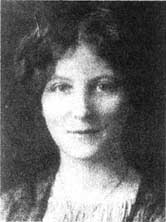
"Beloved May"
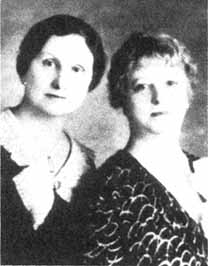
Miss Alexander and Mrs. Maxwell in 1934.
Chapter 17
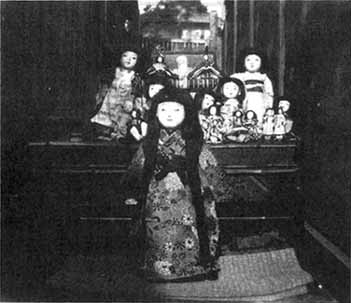
Some of the Japanese doll family, dressed by the Tokyo Bahá'ís and sent for sale to the American Bahá'í community. The proceeds went to the American Mashriqu'l-Adhkar fund.
Japanese dolls and asked the girls to make kimono for them. She felt the dolls could be sold in America and the proceeds given to the Temple Fund. Many people became interested in this worthy project and eventually over one hundred beautifully dressed dolls were sent to be sold.
Chapter 18
She and Miss Alexander met in Montclair, New Jersey, in

click here for larger image
Miss Alexander and Auntie Victoria Bedikian in Montclair, New Jersey, 1918.
A page on Japan from one of the early publications, the "Mashriqu'l-Adhkar." The date of this issue was about 1928.
She especially loved children and in 1922 started a "Mashriqu'l-Adhkar" magazine directed toward children —sending it world-wide. It discussed details of the Temple being built in Wilmette, Illinois, and published letters and pictures of groups from different countries. She started a Temple Fund that Bahá'ís could contribute to.
She also started an organization for "destitute" and helpless children. Both 'Abdu'l-Bahá and the Guardian encouraged her efforts on behalf of children. At one time she cared for forty children in her own home.
Auntie Victoria was one of the Bahá'ís who received and sold the Japanese dolls that the Bahá'í class of Tokyo made; Mrs. Kathryn Frankland was another. The proceeds were sent to the Temple Fund. Auntie Victoria often sent small donations, or things like beads, to different countries which she exchanged for decorations native to the countries. She then sold those decorations for the Temple Fund. In addition to dolls, Miss Alexander also sent her Japanese paper, parasols and picture post cards of Japan. The Tokyo Bahá'í class enthusiastically joined in the effort.
Auntie Victoria had a large set of printed deepening sheets for children which she sent out regularly. All the groups, whether in the United States or in foreign countries, which she corresponded with were given names such as "Song Birds," "Violets," "Rose Garden,". and "Divine Pearls." Tokyo was appropriately called "Cherry Garden." Her "gardens" and fellowship groups sent articles and pictures to some of the early magazines. There were one hundred and twenty-nine of her groups in the United States and around the world, and she was always looking for more Bahá'ís to write to. Her extensive and continuing correspondence went a long way in giving the early Bahá'ís a glimpse of the vastness and international aspects of the Faith. Her letters themselves were a deepening, and the recipients felt her love.
Chapter 19
(1894-1970)
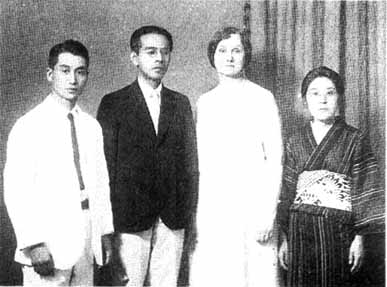
Miss Alexander wrote, "When I first met this blind brother I felt his spirit was reaching for the Light." He accepted the Faith almost immediately upon hearing of it. He wrote to 'Abdu'l-Bahá twice — first in Esperanto and later in English, which he had been studying. 'Abdu'l-Bahá favored him with two Tablets, in one addressing him "0 thou possessor of a seeing heart!" He told Mr. Torii, "Bodily sight is subject to a thousand maladies and ultimately and assuredly will be obscured... But the sight of the heart is illumined . . . everlasting and eternal."
Mr. Torii did vast service for the Faith through the years and translated many of the Writings into Japanese Braille. Much later as president of the Blind Association, he often referred to or wrote about the Faith. In 1966 at the age of seventy-two, Mr. Torii received the nation's highest honor, an Imperial Citation, the Medal of the Third Order, for his work on behalf of the blind.

48
Chapter 20
1918-1935
Akira was extremely fond of Miss Alexander, whom he called "obasan" (aunt). He diligently studied English so he could write to her. He was his father's helper and companion, and it was a tragic time when the boy sickened and died at age seventeen.
Miss Alexander was in Hawaii when she heard of Akira's death. She immediately wrote to Mr. and Mrs. Torii, "... our blessed Akira is now in His Heavenly Realm, and although we cannot see him with our human eyes, yet he is not far from those who loved him, and still love him, and by our prayers we may know that there is a meeting and that we can help him as well as he help us. That is the blessing." She also sent them words
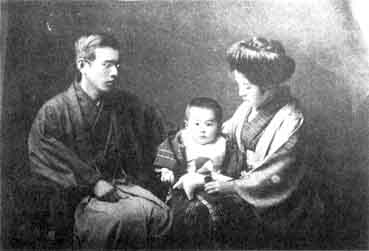
click here for larger image
Akira Torii with his parents in 1919.
Mr. Torii wrote and had printed a book in memory of his only child. The name of the book was "Eien no Reimei" (Eternal Dawn). In the frontispiece was a copy of the original Tablet (in Persian) of 'Abdu'l-Bahá to Mr. Torii with the English translation which mentions Akira. At the end of the book was quoted, "0 thou who art the Lord of all men! Grant then, 0 my God, that Thy servant may consort with Thy chosen ones, Thy saints and Thy Messengers in heavenly places that the pen cannot tell nor the tongue recount." (from a prayer by Bahá'u'lláh)
"Bahá'u'lláh and the New Era" had been translated into Japanese by Mr. Daiun Inouye some years earlier. Mr. Torii transcribed it into Japanese Braille in 1936 as a memorial to his son. The book, seven hundred and seventy pages in three volumes, was sent to the libraries of various schools for the blind and was given to blind persons thereby bringing Light to those in Japan who could not see.
One set of the Japanese Braille edition of "Bahá'u'lláh and the New Era" was sent to the Guardian. He expressed "grateful appreciation and thanks" to Mr. Torii for his service and wrote that the books were to be placed in the Mansion of Bahá'u'lláh at Bahji.

Akira ("whose name may be ever blessed') at age eleven wearing his schoolboy uniform.
50
Chapter 21
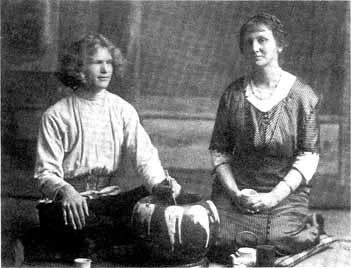
click here for larger image
Miss Alexander and Vasily Eroshenko, a blind Russian Esperantist, who lived for a time in Tokyo. He did the first translation of the "Hidden Words of Bahá'u'lláh" (Arabic section), into Esperanto in 1916. He helped Miss Alexander learn both English and Esperanto Braille, and he introduced her to many people, including Mr. Torii. Mr. Eroshenko was greatly attracted to the Faith at the time. Later he left Japan and returned to Russia, and, according to Miss Alexander, he lost the inspiration he had received through the Bahá'í Teachings. This photograph was taken in 1915.
Mr. Torii, Mr. Kenjiro Ono and Mr. Tomonaga Noto all wrote to 'Abdu'l-Bahá. The blind were shown great love by Him. Five of His eighteen Tablets to Japanese were addressed to the blind; two to Mr. Torii, two to Mr. Ono and one to Mr. Noto.
Miss Alexander continued to have many opportunities through the years to meet the blind and attend their meetings.

Miss Alexander and Mr. Kenjiro Ono. He was the first blind man to study in a university in Japan (1914). He was greatly attracted to the Faith, and he helped Miss Mochizuki start the first Bahá'í magazine in Japanese, "Higashi no Hoshi," but he did not commit himself to the Faith.'Abdu'l-Bahá wrote to him, "Verily, verily thou hast suffered much in thy life time. Praise be unto God, that thy insight is keen. Do not thou lament over thy poverty, for the Treasury of the Kingdom is thine...".
'Abdu'l-Bahá offered him great confirmations, "Rest assured that thou wilt be confirmed to give sight to the blind and hearing power to the deaf and even thou wilt give life to the dead!"
However, Mr. Ono soon left Japan to join Eroshenko in China and Russia, and he died abroad. The man on the right is thought to be Mr. Sanzo Misawa, one of the early Bahá'ís. This photograph was taken about 1916.
This photograph was dated March 31, 1915. Miss Alexander is sitting at the far right, and Mr. Eroshenko next to her. It is apparently an Esperanto group.
Mr. Keiji Sawada, who was blind, is shown being greeted by Miss Helen Keller when she came to Japan in 1937. Mr. Sawada was listed as being on the first Local Spiritual Assembly of Tokyo in 1932. He and his wife were close friends of Miss Alexander, and he associated with Bahá'ís when he went to the United States for study. He did not identify himself as a Bahá'í in later years although he and his wife can be seen in photographs taken at Bahá'í activities in the years after the war.

click here for larger image
Mr. Torii is speaking before the Blind Association, on the occasion of Miss Keller's visit to Japan. She is sitting second from the right. Miss Keller was well aware of the Faith and wrote appreciatively of it.Miss Keller was born blind and deaf. Her life, overcoming all difficulties and rising to eminence in the world, has been an inspiration to all, not only similarly affected people. She was given much publicity when she came to Japan. The first time happened to be during one of Martha Root's trips, but apparently they did not meet. Miss Root, always the journalist, circulated to the Japanese newspapers Miss Keller's words about the Bahá'í Faith, "The philosophy of Bahá'u'lláh deserves the best thought we can give it ... what nobler theme than the 'good of the world and the happiness of the nations' can occupy our lives? ..." Miss Keller came again to Japan in 1955 and met Mr. Torii and Mr. Sawada at the schools for the blind where they were teaching.
Chapter 22
He did much service in those early days as he began translating Bahá'í publications into Japanese. His most notable service was some years later, in 1932, when he translated "Bahá'u'lláh and the New Era" into Japanese as a memorial to his daughter,
Mr. Inouye spent some time with Martha Root when she visited Japan in 1937. He resigned from the priesthood and wrote that he would be free to spend his time propagating the Faith.
Not long after, World War II broke out and the Bahá'í community was scattered with no activity for several years.
The first American Bahá'ís to come to Japan after the war, in the late 1940s, located some of the Bahá'ís, including Mr. Inouye but unfortunately he did not arise to his former activity.
'Abdu'l-Bahá had mentioned the names of Mr. Inouye and Mr. Saiki together, in 1918 and in 1920. He told Miss Alexander to convey His love to them.
Mr. Inouye's name was on the list of confirmed Bahá'ís Miss Alexander sent to the Guardian in 1922. However, there is no record that Mr. Saiki was considered as a Bahá'í. At one time he had been a Christian evangelist. He was a writer and mentioned the Faith in one of his books. Apparently he wrote to

We do not have photographs of Mr. Inouye or Mr. Saiki in the early years. This was taken in 1948. It shows Mr. Robert Imagire, American pioneer to Japan, Mr. Torii and Mr. Inouye. The man behind is unidentified.
'Abdu'l-Bahá answered, praising his efforts, but He advised Mr. Saiki to concentrate all his energy in spreading the Faith.
Chapter 23

This photograph taken in 1923, shows Mrs. Finch with Miss Mikae Komatsu (later Mrs. Tadako Arakawa), who was one of three Japanese women to receive a Tablet from 'Abdu'l-Bahá. Miss Komatsu married and moved to Kobe. Miss Alexander kept in touch with her until 1937, when, due to the rise of the militarists Miss Alexander was advised to leave Japan.Mrs. Arakawa was located again in Tokyo in the 1960s and she became an active member of the community and can be seen in group pictures in that later era. She gave this photograph to the compiler in the late 1970s.
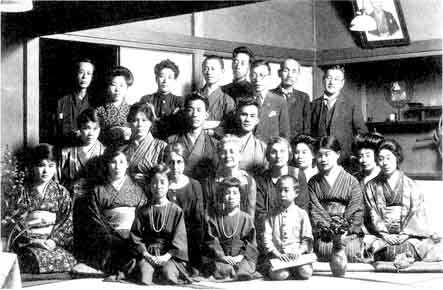
click here for larger image
This photograph was found among Miss Alexander's effects. Nothing indicated the occasion, but it was probably taken about 1922. Mrs. Finch is in the middle and Miss Alexander to the right of her. Mr. Futakami is behind them. Mrs. Takeshita, who was a close friend of Mrs. Finch, is sitting second from the left. Miss Tanaka is sitting second from the right.
This was taken in April 1923 at the home of one of the early Bahá'ís, Mrs. Kanae Takeshita, during Miss Martha Root's second visit to Japan. Top, Mrs. Finch, Miss Alexander and Mr. Kenkichi Futakami. Bottom, Miss Root and Mrs. Takeshita. Mr. Futakami had been a student/helper of Mrs. Finch. 'Abdu'l-Bahá addressed two Tablets to him in 1921, advising him to "rise above worldly attachments and restricted thought to the realm of the Kingdom..." Mr. Futakami married Miss Hide Tanaka one of the girls who actively attended Bahá'í meetings of that era and helped with the homeless children at the time of the earthquake.
click here for larger image
Chapter 24
In Tokyo Miss Alexander had become acquainted with some Korean students, especially Mr. Oh Sang Sun. After Mr. Oh returned to his native Korea, she felt it was time to take the Faith to that land, that had not yet had a Bahá'í visit. At the time Korea was under Japanese rule. There was police surveillance
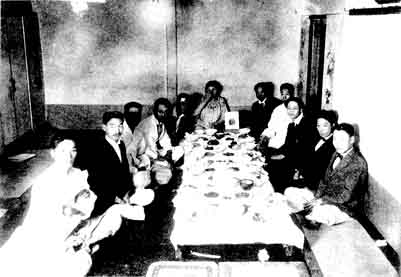
click here for larger image
The first Bahá'í Feast in Korea. This photograph was taken September 9, 1921. Miss Alexander and Mr. Oh are at the end of the table.
To prepare for the trip she first visited Viscount Eiichi Shibusawa, who was a friend of her cousin. He was then eighty-three years old, a great financier and philanthropist. He had started the first modern bank in Japan and later in Korea.
Viscount Shibusawa was friendly and sympathetic to the Bahá'í
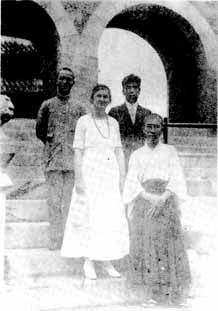
This photograph was taken at the Chosen Hotel in Seoul at the request of Mr. Kurita, top right. He was a young Christian Japanese who was teaching the Korean mute. He had been born deaf but could do lip reading in English. Miss Alexander wrote that he was so skillful that she was not aware of his deafness until he once asked her if they might change their seats to a place with more light as he was reading her lips. Mr. Kurita had heard of the Faith in Japan but had not yet met Miss Alexander. Mr. Torii cabled him of Miss Alexander's coming to Korea. Mr. Kurita greatly assisted Miss Alexander while she was there. She wrote that he was the first among the deaf in Japan to become interested in the Faith. She considered him a remarkable young man. He later went to England to study and died while there. The other two young men in the photo were friends of Mr. Kurita.
When she arrived in Korea she was eager to locate her old friend Mr. Oh, but had no address for him. One day she was riding a streetcar with Mr. Kurita and his friends when her hand was suddenly grasped. She looked up and saw it was Mr. Oh. She wrote, "It was a joyful meeting." Mr. Oh was a great help to her, taking her around and translating for her.
On September 1, 1921, the first Bahá'í public meeting was held in Seoul. It was announced in the newspaper with only a day's notice. When Miss Alexander arrived at the hall that night, to her great surprise she saw about nine hundred Korean men

click here for larger image
Buddhist college students who attended a Bahá'í talk given by Miss Alexander, in Seoul, 1923, during her second trip to Korea. It was at a school in the suburbs of Seoul at which Mr. Oh taught. Miss Alexander wrote that she left at the college a framed photograph of 'Abdu'l-Bahá and a painting of the "Greatest Name" done by Auntie Victoria.
sitting cross-legged on the matted floor, almost all in their white linen costumes. There were also some women sitting separately. Miss Alexander said she showed a photograph of 'Abdu'l-Bahá and spoke of the Center of the Covenant and of the Teachings.
Miss Alexander wanted to have a Bahá'í Feast on September 8, the Feast day. Mr. Oh arranged a meeting at the YMCA and invited some of his friends. The next night some of the men reciprocated and they had another Feast. Miss Alexander had the young men write messages to 'Abdu'l-Bahá on cards that were passed around. Three weeks before His Ascension, 'Abdu'l-Bahá answered with the only Tablet addressed to Koreans. He wrote in part: "Praise be to God, that celestial light guided and led you to the Sun of Reality, bestowed everlasting life and granted heavenly illumination. Ye are like seedlings which have been planted by the hand of bestowal in His Spiritual Rose-Garden. It is my hope that through the warmth of the Sun of Reality, the pouring down of the showers of mercy and the wafting of the breezes of bestowal, ye may progress day by day, so that each one may become a blessed tree, full of leaves and flowers

click here for larger image
Miss Alexander later wrote of her trip to Korea, "Was it not a sign of the times that a western woman and Christian by birth, should tell of the Message for a new day to Buddhist students in an old Buddhist temple in that far away land!"
There was no contact with Mr. Oh for many years, then in 1954 he was located by pioneers to Korea. By that time he had become an eminent poet, famous in Korea. He considered himself a Bahá'í and he and Miss Alexander had a joyful reunion in 1955 when she went there on a visit.
Chapter 25

click here for larger image
Viscount Shibusawa's letter of introduction to the head of the Daiichi Bank in Pusan.In explaining the Faith to Viscount Shibusawa, Miss Alexander showed him 'Abdu'l-Bahá's Words to Miss Fanny Knoblock who was to go to South Africa to teach the Faith. 'Abdu'l-Bahá advised her to say that Bahá'ís do not involve in politics and that religious, racial, political, and national prejudices are destructive to the world of humanity. Viscount Shibusawa was delighted with those words and gladly gave Miss Alexander three introductions to his good friends in Korea. The above scroll-letter (reduced in size) is addressed to Mr. Moriichi Matsumura. It says,
Dear Sir: Tokyo, August 17 ,1921
"Congratulations on your good health! This American lady who takes my letter to you is Miss Agnes B. Alexander. She is a cousin of my close friend, Mr. Wallace Alexander, President of the Chamber of Commerce of San Francisco. She is an earnest believer of the Bahá'í religion.
"As I have been interested in the teachings of this religion, I invited her to my home the other day and listened to her talk on the teachings. I know that her faith is very profound and that her life in Tokyo is very simple. She is really a lady who has a very respectable personality. She is now planning to travel to Korea and I am writing this letter of introduction to you. The Bahá'í religion has nothing to do with politics. Her trip is only for visiting so I hope you will please receive her and give her every help in her journey.Respectfully yours, Eiichi Shibusawa"
As Miss Alexander did not go to Pusan, this letter remained in her possession. The letters to the governor of Korea and to the head of the Daiichi Bank in Seoul were, of course, given to them.
Viscount Shibusawa was already an old man of eighty-three. He is photographed here with two samurai swords tucked in his belt, but his watch chain added a (then) modern note.
Chapter 26
Miss Alexander listed the following four as being friends of the Faith, Mr. Handa (a student), Miss Hide Tanaka, (Mrs. Futakami), Mr. Kobayashi ("a boy of twelve who loves 'Abdu'l-Bahá"), and Mr. Yoshida, a young business man.
She mentioned others such as Mr. Sensui Saiki, Mr. Tomonaga Noto, Mr. Kenjiro Ono, Mr. Jiso Iwami, Mr. Kenkichi Futakami and Mr. Nasu, who had all received communications from 'Abdu'l-Bahá, either personal Tablets or in Tablets of a general nature.
Miss Alexander carefully copied the Tablets of the first five people mentioned above as they were sent through her, but the originals were given to the recipients. The other Tablets addressed to Bahá'ís were also copied by her. She had all of them printed a few years later, with the help of Mr. Horace Holley. In much later years a search for original Tablets to the Japanese located only those addressed to Mr. Torii, and the prayer written by 'Abdu'l-Bahá in the note book of Mr. Naruse, president of Japan Women's College.
In those days enrollment as a member of the Bahá'í Faith did not have the specific procedure it did in later years. Apparently Noto and Ono had been considered as Bahá'ís in earlier years but not in 1922.
Miss Alexander's friends, (and the Bahá'ís) were from a variety of backgrounds. They were teachers, businessmen, schoolgirls, men students, writers, a Christian minister and even one Buddhist priest.
Of the Japanese friends mentioned above, Miss Alexander stayed in touch with Mr. Torii and Miss Mochizuki throughout the years. She sometimes saw Mrs. Arakawa, Mr. Tanaka, and Mr. Fukuta. As to the others, some were lost track of, and perhaps some died, but all had a part, even though perhaps a small part, in establishing the Faith in Japan in those very early times.
Chapter 27
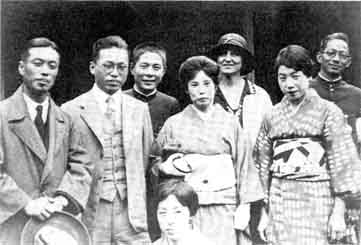
click here for larger image
Mr. Aibara, second from the left, the young Bahá'í whose brilliant career was cut short at age thirty-two. He is seen here with Miss Alexander (rear). Mrs. Takeshita is standing next to Mr. Aibara. This photograph was taken at an Esperanto meeting in 1929.
After this young man's graduation he went to work for the Tokyo Branch of the League of Nations, where he showed leadership qualities.
Mr. Aibara died suddenly a few years later, leaving a wife and baby girl. Miss Alexander was shocked at the sudden passing of her good friend, but was consoled when the Guardian wrote (through his secretary) that Mr. Aibara was now "in a higher spiritual realm enjoying a blissful being far beyond our powers to appreciate."
Many years later Mrs. Aibara accidentally came into contact with a Bahá'í. She was so happy to meet Bahá'ís again that she quickly enrolled as a member of the Japan Bahá'í community.
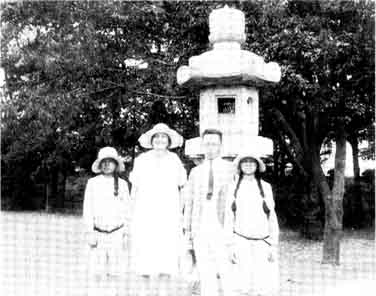
click here for larger image
This photograph was taken near Yasukuni Shrine in 1929. It shows Miss Alexander, Mr. Aibara and two friends of theirs, twin sisters, ardent Esperantists. Miss Alexander sent the picture to be published in the American Star of the West, as an example of young Japanese women. They were among the first women in Japan to enter a medical school.
Chapter 28
Miss Alexander and Mrs. Finch were in their little house when it happened. They managed to get outside in time to see the front wall of the house fall out. However, they could still use the house.
Many survivors were left homeless; especially pitiful were the lost children. The small group of Bahá'ís started an orphanage and joined with others to care for the children. Mrs. Finch, who had left Tokyo for her home in Seattle shortly after the earthquake, started to collect clothing and money from the Americans which she sent to Miss Alexander for the children. The Guardian, Shoghi Effendi, and other members of the Holy
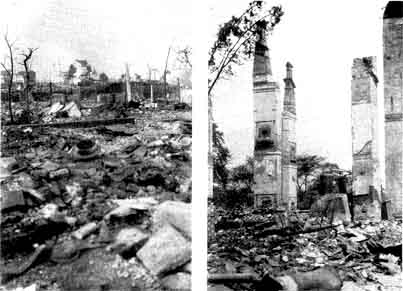
click here for larger image
Besides the efforts made by Miss Alexander and Mrs. Finch, worthy of note were those made by three other Bahá'í women, Miss Murakami, Mrs. Takeshita, and Miss Hide Tanaka.
Miss Murakami and Mrs. Takeshita are mentioned again in 1932 and 1933 as being members of the first Local Spiritual Assembly of Tokyo.
Miss Alexander wrote an account of the great Kanto earthquake to the Bahá'ís of India. She often wrote to Bahá'ís of other countries because the Guardian had encouraged such communication. This letter, printed in the Bahá'í News of India, is perhaps more revealing about that dear soul, Miss Alexander.
Most beloved friends of 'Abdu'l-Bahá, September 26, 1923
Many days have passed since the great catastrophe of September 1st. That day our beloved Lord protected His servants in these parts. A week before, Mrs. Ida Finch had come from Peking on her way to America and was with this servant in the little Bahá'í home. When the earth began suddenly to shake, we two were sitting in the parlour, which His Love had blessed so many times and where peace can be found. The little house is back from the street in Ukyomachi. This servant had been

click here for larger image
68
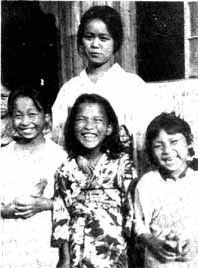
69
along the coast.
Evening came and we laid ourselves down to rest in the little parlour to escape, if necessary. Beside His portrait this servant found a place to rest. During the night we were called to escape, as the fire was drawing near, but it proved not to be necessary. The next two days we remained by the house, as safety was not assured when the earth continued to shake. On the morning of the third, the fire had ceased to burn. The glare no longer was seen in the sky. For days after the great quake and fire, masses of humanity passed along the broad roadway into which Ukyomachi leads, coming from the burned districts where they had been driven out by fire. Oh, that mass of humanity!
When this servant went to the street, she was dazed, it was too overwhelming to comprehend. Along the roadway there was scarcely anything to be found. Everything had suddenly come to a standstill, but with tremendous energy the government took hold and food was brought in from outer provinces. From the moment of the earthquake everything had stopped. The trains and trams were stopped, similarly gas, electric lights, telephones, etc. On the fourth day, with the help of a kind student friend, I found my way to what had been the American Embassy, but only a few pillars remained. The only center remaining in Tokyo was the new Imperial Hotel. It seemed to be the only place to

click here for larger image
Miss Alexander surrounded by the homeless children.
70
On the tenth Mrs. Finch left Tokyo to be taken by the U.S. government on a steamer going to Seattle ... The afternoon of her departure, the way opened for me to have a boy and his mother who had lost everything in the fire, come to stay with me. They are very happy to find a home.
In the district of Fukagawa, one of our Bahá'í brothers had his home and also a dear young sister, Otoe Murakami, worked there in an office, but they were protected by His Love. Miss Murakami escaped with two young friends dodging the fire, here and there, seeing the terrible sights until she reached her home in the suburbs. Mr. Tanaka, our dear brother had started that morning with his little boy of nine years to travel. He said he thought to spread the Bahá'í spirit that way, but they were caught

click here for larger image
BAHÁ'Í ORPHANAGE AT TOKYO (EARTHQUAKE ORPHANS). NO ONE CAN STUDY THESE EARNEST AND STRONG FACES OF JAPANESE CHILDREN WITHOUT REALIZING THE MARVELOUS FUTURE THAT AWAITS THIS GIFTED RACE.
Miss Alexander sent this photograph to be published in the "Star of the West." It is seen here with the original caption [typed in because font on card too small to scan. -J.W.]. It was taken in front of Mrs. Takeshita's house. She is in the last row holding the baby.
Many little children have lost their parents and families in the catastrophe. This servant has sought out these little ones which are being cared for by kind people. In one group there are 110.
To all the friends of God, this servant sends her heart's love, and now she trusts in His Guidance and knows prayers are being uttered on her behalf that she may serve as He wills.
Agnes B. Alexander
Chapter 29
This photograph was taken in Tokyo, May 1922, at a dinner given by a Japanese newspaper for nineteen Chinese women from Peking Women's
Teachers College. They were the first Chinese women to be sent to Japan to inspect the school system. When Miss Alexander read that they were to be honored that evening she went to the newspaper and asked if she might attend the dinner. Of course, she received an invitation. One of the women invited Miss Alexander to speak at her school if she should come to China. She did this a year and a half later.Shown here are the nineteen Chinese women, their Japanese hosts and Miss Alexander (far right in striped dress).
In the early 1920s a group of Chinese newspaper men and several groups of Chinese students visited Japan. Most of the students were training to become teachers. Miss Alexander sought out all groups of Chinese when she read that they had come to Tokyo, becoming friendly with them and telling them of the Message of Bahá'u'lláh. She subsequently corresponded with several of them after they returned to China. These connections had far-reaching results. One of the newsmen published in Chinese the Words of Bahá'u'lláh and 'Abdu'l-Bahá, in twenty-five editions of the widely circulated "Canton Times."

click here for larger image
1923. A school for army officers' children. Every child was given a Bahá'í pamphlet in Chinese to take home. Miss Root's hat can be seen near the top right.
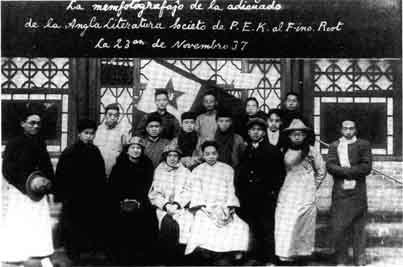
click here for larger image
Before her trip to China Miss Root wrote to Miss Alexander asking if she could have a Bahá'í booklet called "9" translated into Chinese. Miss Alexander asked Mr. Waung to do it. When Miss Root and Miss Alexander visited China in 1923 they were invited to speak at many schools partly because of Miss Alexander's earlier connections with the teachers, and they now had the new pamphlet in Chinese to give out. This pamphlet was reprinted in several editions and thousands of copies were distributed throughout China.
Chapter 30
They were among the first women to cast off the limitations of their time and circumstances, to step forth boldly to proclaim the Faith of Bahá'u'lláh in many parts of the world. They were cultured, educated, and received the respect of the people they talked to.

click here for larger image
This photograph was taken in Kyoto during Miss Root's final visit to Japan in 1937. Mr. Torii is sitting next to her. Behind them are Mr. Kikutaro Fukuta, who was visiting the Toriis, Miss Adachi (Mrs. Torii's sister) and Mrs. Torii.
There have been the questions, "What remains of the efforts of these great Bahá'ís? Where is the sprouting of the seeds that were sown?"
Future historians will no doubt recognize that the travels and teaching in the early days of women such as the above three mentioned went far beyond the service of the time, because during their travels they helped shape and influence the thinking of countless people, young and old, who were eager to listen to such women, coming from so far, with such new ideas.
In those days the audiences in Japan, which often were extremely large, were mostly composed of what we now call leaders, or future leaders of thought. There were news media people, representatives of various aspects of the government, academics, people eminent in many different types of professions. There were many thousands of them, as well as countless and numberless students, citizens of the future.
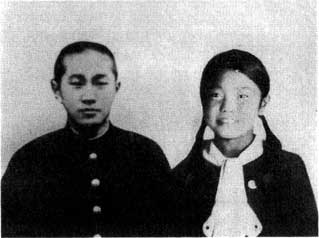
The picture Miss Root is holding (previous page), is that of Akira Torii and Miss Sumi Kinukawa, the fifteen-year-old daughter of a friend of the Toriis. Both young people died within a few months of each other. The two had not met but they both liked music and had similar tastes so the parents decided to make a composite picture of them.Miss Alexander took this photograph to Haifa when she made her pilgrimage in 1937. Knowing it would make him happy, she wrote to Mr. Torii that when she showed the picture to the Guardian he asked to keep it saying he did not have many photographs of Japanese.
Posterity will continue to pay homage to these remarkable women. Here we can only refer to isolated incidents in their lives.
Miss Root visited Japan four times, staying from two weeks to two months. The first visit, of two weeks, was in 1915. Miss Alexander had not been in Japan long herself but she had started activities. She arranged as many meetings as she could and introduced Miss Root to a newspaper reporter resulting in a long article about Miss Root's travels, and about the Faith.

Mrs. Ransom-Kehler spoke on the Faith at a Buddhist Temple, 1931. She is on the left and Miss Alexander on the right. Standing on the right is the Buddhist priest Mr. Morii.
During her first visit she encouraged Miss Alexander to write for the Faith. Miss Alexander started writing and continued all her life. For a person who did not consider herself a writer, Miss Alexander left a considerable amount of written material, articles, many of which were published and written talks which she could hand out for proper translation as she had seen Martha do. She wrote for Bahá'í magazines, sending her letters around the world. She also wrote short memorials when some of her friends passed away, Mr. Fukuta, Mrs. Maxwell and Mrs. Lua Getsinger. At the encouragement of Shoghi Effendi she wrote two books, one on the history of the Faith in Hawaii and the other a history of the Faith in Japan.
Miss Alexander felt she owed a great deal to Miss Root. She wrote of her friend, "Martha, who never sought rest, was continually my inspiration."
Miss Root's second and third visits were even more productive than her first. Miss Alexander had been living in Japan longer and had many contacts. Her second visit of two weeks
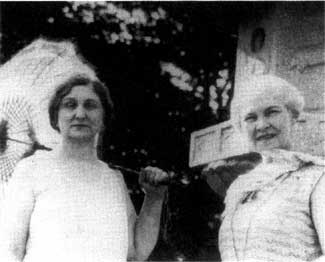
Miss Alexander and Mrs. Ransom-Kehler. Miss Alexander liked to take her friends to nearby Kudan Shrine as a background for photographs.
was full from the day she arrived. She spoke at various organizations, English clubs, the YMCA, Esperanto societies and informal groups at Miss Alexander's home.
Her third visit of two months was in 1930. At this time she attempted to meet the Emperor. This was not permitted. However, she was able to send some gifts along with a cable from Shoghi Effendi (see Ch. 31).
The high point of Miss Root's third visit was the first mention of the Faith on radio. Her subject was "The progress of the Faith on five continents." She read her talk in English and it was translated into Japanese. Later it was published in the daily newspaper, The Japan Times.
It was during this visit that she met Mr. Torii for the first time. When she left she gave him a small wooden and silver-inlaid box which had been given her by relatives of the Báb in Shiraz, Persia. He greatly treasured the box. Some fifty years
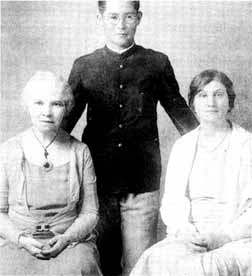
click here for larger image
Keio University law student K. Sudo asked Miss Alexander and Mrs. Ransom-Kehler to pose for this photograph. Miss Alexander and Miss Root had both spoken to the students so Miss Alexander was happy to have their efforts reinforced. She sent a copy of this to the Guardian. It was also published in a "Star of the West" volume.
later Mrs. Torii gave the box to the National Archives in Tokyo.
Miss Root's fourth and final visit to Japan was in 1937. She was the last Bahá'í to visit Japan for many years. This time she could not see her friend, Miss Alexander, who was on her pilgrimage to the Holy Land. Miss Root stayed three weeks during this visit, speaking in various cities, meeting Esperantists and other groups. She made an effort to meet all the Bahá'ís in Japan and had one last photograph taken with the Bahá'ís in Kyoto.
During her four visits Miss Root reached thousands of people, meeting many of them personally, speaking to large groups, by a radio broadcast and having articles published.
Mrs. Ransom-Kehler was a teacher of Bahá'í administration and she did much to deepen the group of Bahá'ís.
From Japan, Mrs. Ransom-Kehler went on to visit other countries. She was sent to Persia (Iran) by Shoghi Effendi to accomplish an important mission, but while she was there she was suddenly taken ill with small pox and passed away. The Guardian designated her as the first American martyr in his cable November 1933:
"Keith's precious life offered up in sacrifice to beloved Cause in Bahá'u'lláh's native land. On Persian soil for Persia's sake she encountered, challenged and fought the forces of darkness with high distinction, indomitable will, unswerving loyalty ... American believers grateful and proud of memory of their first and distinguished martyr ..."
Shortly before she became ill she wrote to Miss Alexander, "I still like Japan better than any country that I have visited and I often think with love and longing of the precious friends there ..."
Miss Alexander summed up her feelings about Keith when she wrote, "I am grateful to God that she came into my life."
Chapter 31
At the time of the Emperor's coronation in 1928 seven specially bound volumes of Bahá'í books were prepared to be presented to the Emperor as a gift from some American Bahá'ís. Shoghi Effendi was asked to write something to accompany the books. He wrote:
"May the perusal of Bahá'í literature enable Your Imperial Majesty to appreciate the sublimity and penetrative power of Bahá'u'lláh's Revelation and inspire you on this auspicious occasion to arise for its worldwide recognition and triumph."
The books arrived after the coronation ceremonies so the presentation was delayed. On May 22, the following year, Dr. Masujima received a letter from the Minister of the Imperial
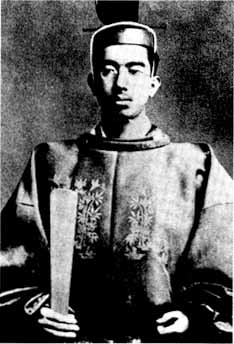
Emperor Hirohito of Japan about the time of his coronation, 1928.
81
Household stating that the seven books, which were named, had been presented to the Emperor that day. Dr. Masujima wrote later, "The Bahá'í publications now form part of His Majesty's library ..."
In November 1930 the great Bahá'í teacher Miss Martha Root applied for an appointment to offer the Emperor a memento accompanied by a good-will message from Shoghi Effendi. The Imperial Household did not permit an interview but did accept the gifts which were presented to the Emperor, a small Persian rug and some Holy Writings in Persian script in the form of a beautiful bird. Accompanying the gifts was a cable from Shoghi Effendi:
"Martha Root care American Embassy Tokyo. Kindly transmit His Imperial Majesty, Tokyo, Japan, on behalf of myself and Bahá'ís world over, expression of our deepest love as well as assurance of heartfelt prayers for his well-being and prosperity of his ancient realm."
Japan, after recovery from the devastation of World War II, shows exactly that — great prosperity, and the Emperor, active and healthy until his final year had the longest reign (December 25, 1926 to January 7,1989) of any sovereign in Japan.
Chapter 32
Greetings were sent from the conference to religious associations throughout the world. In reply to his greeting, Shoghi Effendi expressed his keen interest in the work of the Association and the assurance of his hope for its success.
The presiding officer, Rev. Kozaki spoke of the Parliament of Religions which he had attended in Chicago, Illinois, in 1893. It was at that Parliament of Religions that the Bahá'í Faith was
first mentioned publicly in America.
After the conference, the organizers printed a book with all the speeches. A search in later years found one of the organizers, Rev. Nobuichiro Imaoka, a gentleman of over one hundred years, who remembered Miss Alexander quite well, and who provided copies of the book for the Japan Bahá'í archives. Unfortunately the letter from the Guardian, along with other material, was not preserved.
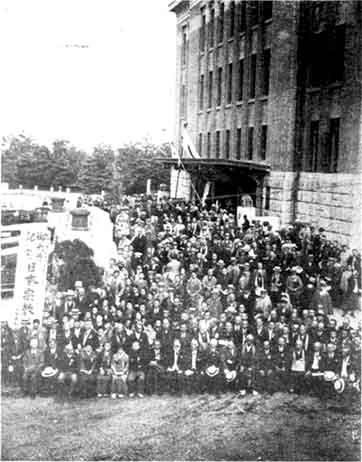
click here for larger image
Delegates to the Japan Religious Conference, 1928.
83
Chapter 33
In 1931 Miss Alexander was asked to represent the Bahá'í Faith in a meeting at a Buddhist Temple. At the left is Buddhist priest Mr. J. Mori, and at the right is Rev. Sempo Ito who represented the Christians.Miss Alexander wrote that Rev. Ito accepted the Faith and he is listed as being a member of the first Local Spiritual Assembly of Tokyo in 1932.
Mrs. Keith Ransom-Kehler spoke at the same Temple.
Chapter 34
In 1911 she came to Japan and they were married in Yokohama. Through the years Dr. Suzuki produced over one hundred translations and works in both English and Japanese on Buddhism. He did much to introduce Zen Buddhism to the West. His wife Beatrice was also credited with being somewhat of an authority on certain aspects of Buddhism. She died in 1939 and he many years later.
Although there are scarcely any records of Mrs. Suzuki in the early days of the Faith in Japan, we know that she and Miss Alexander were acquainted. Dr. Suzuki in later years mentioned to his good friend, the famous British potter Mr. Bernard Leach, that his wife was a Bahá'í.

Dr. Daisetz Suzuki and his Bahá'í wife Beatrice, with their adopted son Victor. This photograph was taken about 1925.
Chapter 35
of 'Abdu'l-Bahá.
During the fall of 1935 Mr. Husayn Uskuli also from Shanghai, visited Japan and attended several Bahá'í gatherings.
Mr. Uskuli's daughter and son-in-law, Mr. and Mrs. S.A. Suleimani, were also living in Shanghai. Conditions worsened considerably in China after World War II so in 1953 Mr. and Mrs. Suleimani pioneered to Taiwan and established the Faith there. Mr. Uskuli remained in Shanghai, the only known Bahá'í in China at that time. He died in Shanghai in 1956.

click here for larger image
Miss Alexander with Mr. H. Touty at Kamakura in 1932.
86
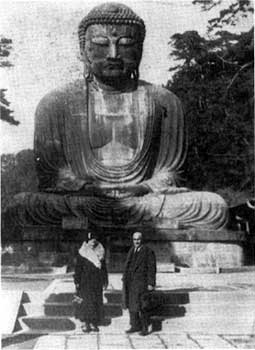
Three years later Miss Alexander accompanied Mr. Husayn Uskuli to see the Daibutsu in Kamakura.
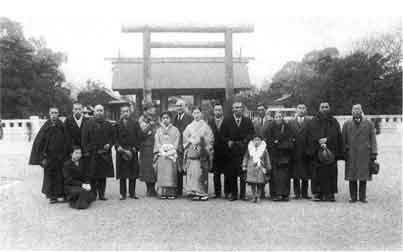
click here for larger image
This photograph was not explained by Miss Alexander. She and Mr. Uskuli can be seen in the background. Apparently they joined a tour group that day. Not so different from modern times except for the more traditional clothing. The young woman kneeling is probably the tour guide.
Chapter 36
He started two mimeographed monthly papers in Esperanto. In one of them, his personal publication, he introduced material from "Paris Talks of 'Abdu'l-Bahá".
At the welcome meeting in Tomakomai Miss Alexander spoke about the Faith in Esperanto, which Mr. Watanabe translated into Japanese.
From Tomakomai Miss Alexander and Mr. Watanabe attended an Esperanto Congress in Yamabe. At that meeting she spoke of the Bahá'í Teachings and Esperanto. They visited two newspapers in Asahigawa, and then went on to Sapporo. The editor of the Hokkai Times was about to print an article about
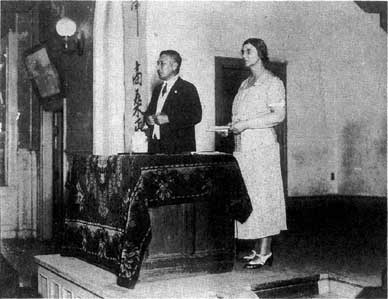
The first mention of the Faith in Hokkaido, 1932. Miss Alexander is speaking at an Esperanto meeting in Tomakomai.
the Esperanto Congress and he added something on the Bahá'í Teachings.
In Hakodate the editor of the Hakodate Shimbun (newspaper) arranged a public talk in the Town Hall for Miss Alexander.
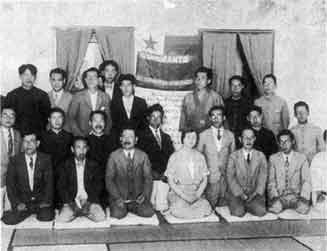
click here for larger image
Mr. Watanabe, who organized the meeting is in the first row, far left. The mayor of Tomakomai is sitting left of Miss Alexander.
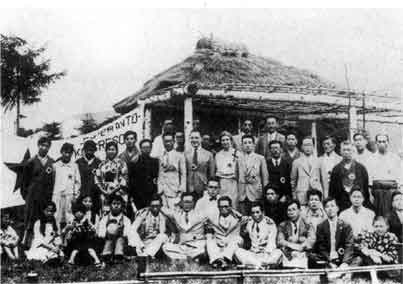
click here for larger image
There were several articles in newspapers about the Faith and Miss Alexander. One had pictures of 'Abdu'l-Bahá and the Bahá'í Temple in the United States.
Miss Alexander wrote that she felt the introduction of the Faith in Hokkaido was accomplished through the Bahá'í principle of having an auxiliary language.
Chapter 37
For three years in the early 1930s, the Bahá'í Naw-Rúz party was held in his garden. Although he never actually became a Bahá'í, he thought the Faith would interest the Japanese and that it would penetrate the Japanese race. He assisted the Bahá'ís in various ways.

click here for larger image
Naw-Rúz party in Dr. Masujima's garden, 1931. He is in the center and Miss Alexander is to his left. Mrs. Takeshita, an early Bahá'í, is to the left of Miss Alexander.

Dr. Rokuichiro Masujima
Naw-Rúz party in Dr. Masujima's garden, 1932. He is in the middle with Miss Alexander to his right. Miss Mochizuki is seated second from the far right. To the left of Dr. Masujima are Mrs. Naganuma and her daughter, then Mrs. Kanae Takeshita. Standing, from the left, Mr. Keiji Sawada; Mr. Sempo Ito; Mr. Fujisawa, an Esperantist; Mr. Moriiuchi, an Esperantist; Mr. Sugimoto, an Esperantist who had associated with Bahá'ís in the United States; Mr. Yamaguchi; Mr. Hidehiko Matsuda; Mr. Ayabe and Mr. Miyamoto, both Buddhists.
Chapter 38
The Bahá'ís on that first assembly were Rev. Sempo Ito, Miss Yuri Mochizuki (later Mrs. Furukawa), Miss Otoe Murakami, Mrs. Kanae Takeshita, Mr. Keiji Sawada, Miss Alexander, Mrs. Antoinette Naganuma, Mr. Nakanishi and Mr. H. Matsuda. The assembly was formed again in 1933 with one change; Mr. Kenji Ogawa taking the place of Mr. Keiji Sawada. That year Miss Alexander left Japan to return to Hawaii for two years.
The assembly was not formed again until many years later, in 1948, by an entirely different group of Bahá'ís who were taught by Mr. Robert Imagire.
In the 1950s only Miss Alexander and Mrs. Furukawa remained of the original group. At that time Miss Alexander was in touch with Mrs. Naganuma and Mr. Sawada but they did not consider themselves as Bahá'ís. We do not know what happened to the others; some were not young even then...
Seven of the first local spiritual assembly members (Miss Alexander, Mrs. Naganuma, Mr. Ito, Mr. Sawada, Mrs. Takeshita, Mr. Matsuda, and Miss Mochizuki) can be seen in the photograph taken in Dr. Masujima's garden in 1932. A picture of Miss Murakami can be seen in Ch. 28. Pictures of Mr. Nakanishi, and Mr. Ogawa, on the 1933 assembly, were not found.
Such a pleasure it is to gaze upon the faces of those forerunners of the builders of the administration in Japan.
Chapter 39
Miss Alexander at the entrance to her home at Kudan Ue, Tokyo, 1936. Her friends were not identified. Miss Alexander's first home when she arrived in Japan in 1914 was also in Kudan Ue. It was there that the first regular Bahá'í meetings were conducted by herself and Dr. Augur. Kudan Ue means "above the nine steps."
Chapter 40
Esperanto and English societies abounded during that time and Miss Alexander found many opportunities to teach, speak before, and participate in the activities of both groups. Her talks before them and her discussions with the participants were always on some aspect of the Bahá'í Faith.
Miss Alexander can be seen in all the following photographs, usually the only foreigner present.

click here for larger image
Miss Alexander and Miss Root meet with Keio University students, 1923. It was during Miss Root's second visit to Japan.
Miss Alexander with Nagoya Esperantists, 1923. This picture appeared in the Nagoya Shimbun (newspaper) under the heading "Apostle of Peace", and it reported that Miss Alexander went to Nagoya under the auspices of the Nagoya Esperanto Society to give a lecture on "Esperanto and Bahá'í". The article also said that she gave a Bahá'í lecture on the Shimin Jiyu Daigaku (Free Citizens University).
Miss Alexander with women students. The photograph was undated but it probably was taken in the early 1920s.
click here for larger image
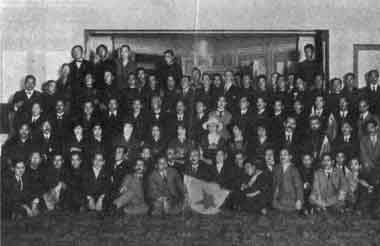
click here for larger image

click here for larger image
Miss Alexander was invited to attend the Third Conference of the Institute of Pacific Relations, in Kyoto, 1929. Delegates and observers from many countries participated. Miss Alexander (fourth row, middle left) was not on the program, nevertheless she was pleased to take part in the conference.

click here for larger image
On her way back to Tokyo from the Conference of the Institute of Pacific Relations, Miss Alexander stopped at the city of Tsu to see her good friends, Mr. and Mrs. Torii. Mr. Torii (left of Miss Alexander) invited some Esperantists from nearby towns to hear of the Faith. Akira Torii who was then twelve can be seen between Miss Alexander and Mr. Torii.
At the Tokyo YMCA, 1930. Miss Alexander spoke to them in Esperanto about the Bahá'í Teachings. One of the members of the class translated into Japanese.
click here for larger image

click here for larger image
On her way back to Japan from China in 1930, Miss Alexander's ship stopped one day in Nagasaki. A group of Esperantists gathered to meet her. Miss Alexander wrote that whenever she met with Esperantists a brotherly spirit was felt. She took every opportunity to lead Esperantists closer to the Faith, using the need for an international language as a point from which to talk. In the early days many Esperantists came into the Faith.

click here for larger image
100

click here for larger image
This photograph was not identified but shows Miss Alexander with one of the many student groups with which she had contact. She went to some of them weekly but as they kept changing membership she continually reached new students. Her willingness to speak before and associate with student groups afforded her the chance to teach the Faith to literally thousands of young people through the years.
Miss Alexander (sitting third from the left), spoke before the Tokyo School for the Blind. This photograph was dated 1930. She often had opportunities to speak of the Faith to the blind. She wrote, "God's Bounty to me was the love He put into my heart for these blind friends, and my greatest joy was in sharing with them His blessings to me."
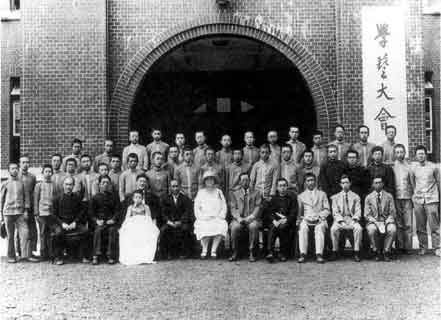
click here for larger image
This undated photograph shows Miss Alexander with university students, probably either an Esperanto group or an English club, about 1930. In those days there were few personal cameras. Consequently there were few impromptu pictures. Most were carefully posed.
Nineteenth Esperanto Congress, Kyoto, 1931. Of this Congress, Miss Alexander wrote, "I was, as usual, the only foreigner present, but felt as though I was among brothers."
Keio University Esperanto Club, 1931. Miss Alexander's friend Mr. Aibara is seated second from the right.
Miss Keith Ransom-Kehler spoke at this Buddhist Temple — the same place Miss Alexander had spoken earlier in the year, 1931. Mr. Ito who was a Bahá'í, third from the left, translated for her. Both Miss Ransom-Kehler and Miss Alexander are seated second from the top row.
click here for larger image
The Twentieth Esperanto Congress, in Tokyo, 1932. Miss Alexander seems to be the only foreigner, as usual. Can you find her?

click here for larger image
Miss Alexander with teachers and students of the Sakurai Jogakko (Sakurai Women's School), in 1932.
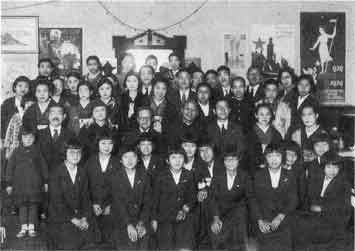
click here for larger image
108
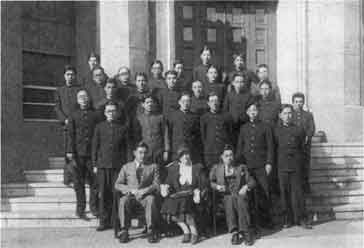
click here for larger image
Miss Alexander often met with the Meiji University English Conversation Club. She was invited this evening, January 22, 1937, to a farewell dinner for four members who were graduating. She wrote that every meeting gave her a chance to speak on the Faith.
Chapter 41
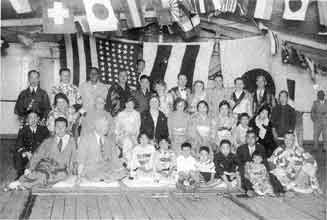
click here for larger image
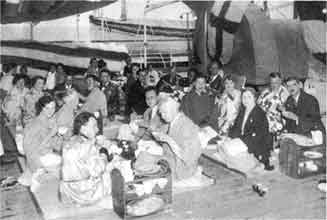
click here for larger image
Miss Alexander kept these two photographs as souvenirs of her trip from Japan to her home in Hawaii in 1933. She can be seen among the multi-national passengers wearing a black "haori". It was on the Japanese ship the S.S. Taiyo Maru.
Chapter 42

click here for larger image

Seikei School tea party. The doll was presented to her in appreciation of the many favors she had done for the school.
After the meeting the school gave a tea party in appreciation and presented her with a Japanese dancing doll in a glass case. When she left Japan the following spring to go to Haifa for her pilgrimage, she took the doll in its case packed in a box, and presented it to the Guardian and his bride.
Chapter 43

click here for larger image
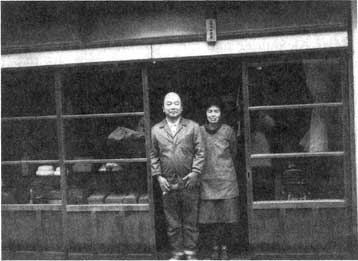
Many years later, in 1980, Hideo Fujita's photograph was taken with his wife in front of the original Fujita family's rice shop.
Chapter 44
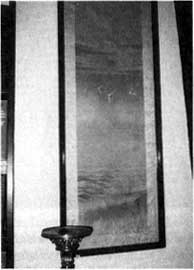
113
To take the place of the stolen scroll, she bought a typical Japanese scroll. When she left Japan to make her pilgrimage in 1937 she took it with her to give to Shoghi Effendi.
When he accepted it she was deeply touched, considering it an honor for Japan.
This scroll of three storks in flight over the ocean, with the rising sun casting a glow, can still be seen hanging on the wall of the House of Abbud in Akka where the Guardian placed it.
Chapter 45

This photograph of Mr. Fujita, Miss Adelaide Sharp and Miss Alexander was taken by Mr. W. S. Maxwell in Haifa in 1937. Miss Alexander and Miss Sharp were there on pilgrimage. Miss Alexander had waited many years for the privilege of being received by the Guardian of the Bahá'í Faith in the Holy Land.
Chapter 46
Miss Martha Root was the last Bahá'í from abroad to visit Japan. This time, Miss Alexander had already gone, and the two good friends could not meet. However, Miss Root endeavored to meet every Bahá'í in Japan.
The political situation in Japan continued to disfavor many of the religious groups and even the Bahá'ís were suspect. The country was taken over by the militarists, and devastating World War II broke out.
The small Bahá'í community was rather scattered and, as the years went by, the few remaining Bahá'ís could not meet and the community became nonfunctional, not to come to life again until after the war.
In 1937 when Miss Alexander was in the Holy Land on pilgrimage, Shoghi Effendi told her, "The immediate future in Japan is very dark. Japan is going to suffer. The time is not now for great headway. The Pacific will become a great storm center in the coming war, great suffering." Indeed, the Guardian' s words were soon to become truth.
Japan emerged subdued and defeated. The rise of Japan as a first-world country and a powerful economic nation was a number of years off.
In the late 1940s the first Bahá'ís from abroad came to Japan, Americans with the American Occupation Forces. Names we can recall from the days immediately after the war are Mr. Michael Jamir, Mrs. Lorraine Wright and Mr. Robert Imagire. They managed to find some of the scattered Bahá'ís. Mr. Jamir wrote of his successful trips to find Mr. Torii and Mr. Fujita. Mrs. Wright was the wife of an Army officer. One of the early Japanese Bahá'ís, Mr. Yoshio Tanaka, fondly saved pictures of the Wrights which he put in an album and eventually gave to the National Archives.
Mr. Robert Imagire came to Japan in 1947 at the Guardian's encouragement and spent about eight years in the country. He found work with the U.S. Forces which enabled him to stay. He started regular meetings with the early Bahá'ís that he could find, and newly interested people. A new foundation was being laid.
Miss Alexander, who was still in the United States, had asked Mr. Imagire to locate her Bahá'í books, which she had left in the care of her old friend, Dr. Masujima. The address Miss Alexander had given to Mr. Imagire was in an area in Tokyo that was completely bombed out. But he went anyway, and found only one building standing. Miss Alexander's books were in the basement of that building unharmed. There were two hundred copies of "Bahá'u'lláh and the New Era" in Japanese, which were desperately needed as there was nothing in Japanese to use to teach and deepen.
In 1948 the first post-war local spiritual assembly was elected in Tokyo. When the Guardian was informed of it, a letter written on his behalf stated that it was "a historic and wonderful achievement." The members were: Mr. Goro Horioka (chairman), Mrs. Masako Urushi (vice-chairman), Mr. Shozo Kadota (recording secretary), Miss Fumiko Kondo (corresponding secretary), Miss Minori Inagaki (treasurer), Mr. Daiun Inoue, Mr. Sempo Ito, and two others (likely Miss Fusae Ichige and Miss Shigeko Nakanishi, who served on succeeding assemblies, as did Robert Imagire).
Most of the members were new Bahá'ís and within a few years became disassociated with the Faith for various reasons, mostly because they moved and lost contact, or married, or their working condition changed. Still the foundation was solid and survived, with ever-increasing new adherents, new believers in the Faith of Bahá'u'lláh. The Local Spiritual Assembly of the Bahá'ís of Tokyo has continued
At that time, Mr. Imagire corresponded directly with the Guardian regarding the progress of the Faith in Japan. The Guardian told him not to be discouraged; he gave criteria for membership in the Faith; he suggested ways and means to deepen the Bahá'ís; he also gave guidance regarding what to translate, and other suggestions.
Shoghi Effendi wrote to Miss Alexander encouraging her to return to Japan. She was able to do so in 1950 after being sponsored by Lt. J.C. Davenport (USAF), to obtain the difficult visa as Japan was still under the Allied Occupation. Miss Alexander stayed in the Tokyo area until 1952, when she moved to Kyoto.
By 1951 four American pioneers were elected to the Tokyo Local Spiritual Assembly. The membership then was Miss Ichige, Mr. Kadota, Mr. Horioka, Miss Nakanishi and Mr. Yoshino. The Americans were Miss Alexander, Mr. Lane Skelton, Mrs. Barbara Davenport and Mr. Imagire.
Sometime during 1952 the membership changed to Mr. Imagire, Lt. Col. John McHenry, Mr. Goro Horioka, Mr. Tameo Hongo, Miss Ichige, Mr. Skelton, Dr. and Mrs. David Earl, and Mr. Donald Witzel. The Japanese friends in their deep affection and appreciation for the American Bahá'ís tended to elect them to the local spiritual assembly.
There are old records of 1952 and 53 which show the activity of Tokyo, Mr. John McHenry and Mrs. Joy Earl spoke at the YMCA on different occasions. There was publicity in the newspapers for various events. When Hand of the Cause Mr. Khadem came to Japan for the first time in 1953, the Tokyo Assembly arranged a public meeting for him.
In 1952 there was an Asian World Federation Congress in Hiroshima with fourteen Asian countries represented. Miss Alexander attended and spoke on the Bahá'í Plan for World Order. It was there she met Mr. Yan Kee Leong.
In 1952 there was only one local spiritual assembly in Japan, in Tokyo, six isolated believers, but no organized groups. The Bahá'í community totaled about 35 believers; of these, twelve were Americans, eight being attached to the U.S. Armed Forces; the rest were Japanese. There were no resident Persians yet, although that year Mr. Y.A. Rafaat had made a trip to Japan to look over the possibilities, but he returned to Iran, not to transfer to Japan permanently until the summer of 1953.
However, in September 1953, the Bahá'í Geppo (News) was started by the Tokyo Local Spiritual Assembly and it continued for many years.
In 1952 the Local Spiritual Assembly of Tokyo reported that it had extension teaching goals: Yokohama (there is a record of the first meeting there at which Mrs. Joy Earl spoke with Mr. Imagire translating), Sendai, Osaka, Hiroshima and Kofu. When the Guardian received this report, an answer written on his behalf indicated he was happy that extension teaching was being done and he mentioned that Tokyo, as the mother assembly, had great responsibility.
It was the same letter (October 30, 1952) that said that the Guardian was particularly glad to hear of the teaching being done in Hiroshima where the people had a special right to hear of Bahá'u'lláh's Message.
That year the Local Spiritual Assembly of Tokyo ambitiously appointed eight committees and they all seem to have been working. One of the responsibilities of Tokyo was to accept enrollments from all over Japan.
In 1953 the Translation Committee of the Local Spiritual Assembly of Tokyo compiled and printed an English-Japanese glossary of Bahá'í terms. This made the translation work go smoother. The first introductory pamphlet written in Japanese, the "Bahá'í Shinkyo no Tebiki," was printed. Two years later Mr. Torii transcribed this into a Japanese Braille pamphlet.
A major achievement in Tokyo was the revision of "Baháu'lláh and the New Era." The original translation had been printed in 1932 as a result of Miss Alexander's endeavors. It not only needed reprinting but parts needed retranslation. Mr. Tameo Hongo and Dr. David Earl worked on this important project.
In 1953 the first permanent Persian pioneers arrived. The American Bahá' is, except for Miss Alexander, who by this time was living in Kyoto, were all of necessity in the Tokyo area. But when the Persians came in 1953 and 1954, with the exception of Mr. Rafaat, (Tokyo), and Mr. and Mrs. Mohtadi, (Nagoya), they went to the Kansai area around Osaka. The Faith
In the Guardian's Message to the 45th Annual Convention of the Bahá'ís of the United States (1953), he listed many tasks to be accomplished during the Ten Year Plan (also known as the Ten Year Spiritual Crusade) 1953-1963. He wrote that this Plan was the third and final epoch of 'Abdu'l-Bahá's Master (Teaching) Plan. The American Bahá'í community was given most of the responsibility to accomplish the goals. Japan was listed as a consolidation goal; a National Spiritual Assembly in Japan was to be established during those years; to be incorporated; an endowment was to be purchased somewhere in Japan, and a Haziratu'l-Quds was to be acquired in Tokyo.
The American National Spiritual Assembly appointed the Asia Teaching Committee, whose secretary was Miss Charlotte Linfoot, to be the liaison between that assembly and the various Asian countries they were to help. Both the Asia Teaching Committee and the national assembly itself, whose secretary was Mr. Horace Holley, did everything they could to assist the Japanese community. There are dozens of letters in the Japan National Archives attesting to this. The Local Spiritual Assembly in Tokyo also corresponded directly with the Guardian.
Chapter 47

click here for larger image
Urushi. Thirteen people assembled for the Naw-Rúz celebration in Tokyo in 1948. It was the first Naw-Rúz party in Japan in many years. The program consisted of prayers and music. Mr. Imagire is standing at the left. Miss Alexander's old friend, Mr. Inouye, is sitting second from the left. Mrs. Urushi was a relative of Mr. Inouye by marriage.Mr. Imagire gathered the early Bahá'ís that he could find, and newly interested people and tried very hard to deepen them.
Chapter 48
48. At Kudan This was one of the first photographs of Miss Alexander after she returned to Japan following World War II. It was taken May 23, 1950 and shows Mr. Robert Imagire, who came to Japan in 1947 at the Guardian's request, Mr. Saichiro Fujita and Miss Alexander. Miss Alexander sent this to the Guardian. She wrote on the back that it was taken at Kudan (which means nine steps), the area in Tokyo where the Faith was first established in Japan.
click here for larger image
Chapter 49
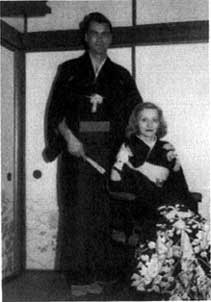
Early pioneers to Japan, Lt. and Mrs. J. C. Davenport, Tokyo, 1950.
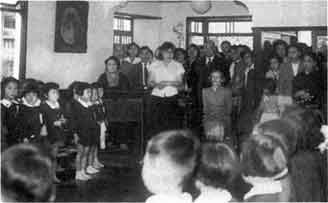
click here for larger image
Mrs. Davenport (seated) is entertained by children singing in English, in her honor, at a private school in Tokyo in 1950. She gave a talk on Bahá'í education to the teachers and parents.

click here for larger image

click here for larger image
These two photographs were taken at the house, which, a few months later would be purchased by the Local Spiritual Assembly of Tokyo, to become the second Haziratu'l-Quds in Japan. Most of the meetings in Tokyo had been held there since the fall of 1953.Tokyo always had interested people and good activities. Six people in the lower photo were to become members of the national spiritual assembly several years later.

click here for larger image
Tokyo, 1953. This is a meeting at the home of Mr. and Mrs. Donald Witzel, seated in the rear. Mr. Witzel was then attached to the U.S. Army in Tokyo.Miss Kotoko Mochizuki, second from the left, worked for the Witzels, attended their meetings and became a Bahá'í. Now, over thirty years later, she still remembers how kind and loving they were. Two other friends of the Witzels, who are now long-time Bahá'ís, are Mr. Yuzo Yamaguchi (with glasses), and Mrs. Hisae Matsuo, woman on the right side.
The Witzels left Japan that fall. In 1968. Mr. Witzel was appointed by the Universal House of Justice to the Continental Board of Counsellors in South America.
The Mottahedehs Visit Japan
This is a meeting in Tokyo, 1954. Mrs. Mildred Mottahedeh (left) and her husband Mr. Rafi Mottahedeh (third from the right) visited Japan occasionally through the years, the first time in 1953. In 1961 dynamic Mrs. Mottahedeh was elected as a member of the International Council, the institution which was the predecessor to the Universal House of Justice.
1954. The Tokyo community has a picnic. Mr. Rafaat can be seen far right. Leaning against the tree on the right is Miss Kotoko Mochizuki (Honma.)
1955. The Tokyo Bahá'í community has a pot-luck dinner at the Bahá'í Center. From left to right, Mr. Yuzo Yamaguchi, Miss Lecile Webster, Mr. Tameo Hongo, Mrs. Sims and Mrs. Virginia Hamilton.
click here for larger image
Chapter 50

Two small men, with mighty spirits. Mr. Philip Marangella, who had arrived in Japan to pioneer in 1953, and Mr. Saichiro Fujita. This was taken in Hiroshima, December 21, 1954, where the two had gone for teaching.
Chapter 51
There had been Persian Bahá'í visitors to Japan previously, notably Mr. Y.A. Rafaat, who was the first Persian Bahá'í to visit Japan in the post-war period. He intended to return to pioneer
but could not do so until the summer of 1953, when the Teheran Local Spiritual Assembly transferred him.
The Moghbel family and the Katirai family arrived with proper visas, with the intention of staying.
At that time there were no direct flights from Iran to Japan, and no Japanese Embassy in Iran to issue visas.
First they went to Pakistan to get plane tickets, and commercial visas as they intended to do business in Japan. The United States Occupation had ended the year before and Japan was opening up somewhat.
The National Spiritual Assembly of Pakistan sent a cable to the Local Spiritual Assembly of Tokyo that the two Persian families would be arriving.
After an exhausting flight by propeller plane they landed at Haneda Airport near Tokyo, March 21, 1953. They were met by assembly members Mr. Witzel and Mr. Kadota, and taken to a hotel in Tokyo where there was a Naw-Rúz party of forty people. The two families recall how happy and elated they were, and what a joyous beginning of their pioneer effort it was.
Later that year and during subsequent years several other Persian families settled in Japan.

click here for larger image
Naw-Rúz, 1953, in Tokyo. The first Persian families arrive. From the left: Mrs. Mahin Moghbel, holding Zafar; Mr. Ataullah Moghbel; Mrs. Rezvanieh Katirai and Mr. Abbas Katirai with Foad. Farzad Katirai, who was an infant, was sleeping nearby.
Chapter 52
As it was a goal of the Ten Year Crusade, the Tokyo Local Spiritual Assembly began working on achieving an incorporation in 1954. It was granted the following year. According to Japanese law, the Faith itself was incorporated with the local spiritual assembly members listed as corporate members. After the first national spiritual assembly was elected, the same incorporation was changed to apply to that assembly and the various local assemblies listed as branches.
Gradually the pioneers spread out. Most of the Persians were in different cities in the Kansai area, near Osaka, Dr. and Mrs. Earl went to Yamaguchi Prefecture, and Mr. Marangella, who was working for the United States government, transferred to Nishinomiya.
Extension teaching was being done in Hiroshima, Yamanashi Prefecture and Kanagawa Prefecture. Under the Tokyo Local Spiritual Assembly regular meetings were established in Yokohama. Virtually all the pioneers in the years to follow made trips around Japan for the purpose of spreading the Faith. The earliest Japanese believers, most of whom became Bahá'ís through close association with pioneers, often went on teaching trips to translate for them. The new Japanese Bahá'ís became deepened in this way, and in the late 1950s and 1960s some of them arose in turn to take the Faith to their fellow countrymen.
Because the Bahá'í teachers in those early days were mainly American and Persian pioneers, the early Japanese Bahá'ís came from a segment of the population who were internationally minded, who could accept foreign friends in what had always been considered a closed society. They were the ones who had taken the trouble to learn enough English to communicate. Among
The Japanese already had many spiritual qualities, some of which 'Abdu'l-Bahá had mentioned: "great capacity," "intelligent, sagacious and have the power of rapid assimilation," "bright and noble minded." He even said, "Japan with (another country) will take the lead in the spiritual re-awakening of the peoples and nation..." In the letters from the Guardian in the 1950s he also referred to the qualities of the Japanese: "great vision and spirituality," "sensitive to every form of beauty, both spiritual and material."
It is interesting that Japan was the first nation whose constitution outlawed war.
In 1954 Miss Alexander was seventy-nine years of age, but as active as ever. There are reports of her joining Mr. and Mrs. Torii at a meeting of the Blind Association in Ishikawa Prefecture that year. Mr. Imagire recalls going with Miss Alexander and Mr. Torii to a meeting of the deaf and mute about that time. Miss Alexander spoke in English; Mr. Imagire translated it into Japanese; Mr. Torii (who was blind) translated it into sign language.
Miss Alexander continued to attend as many Blind Association meetings and Esperanto meetings as she could, just as she had done when she first came to Japan some forty years earlier. She made many acquaintances and contacts during these meetings, some of whom became Bahá'ís and many of them life-long friends. That year she and Mr. Zenimoto made a teaching trip to his hometown of Saijyo, Hiroshima Prefecture, with the result that his mother became a Bahá'í.
Mr. Michitoshi Zenimoto, who many years later was to become the second Japanese counsellor, was a student at Doshisha University in Kyoto in 1952. There were a number of blind students there and Mr. Zenimoto was helping to organize an English class for five of them. Searching for a teacher, he was referred to Mr. Torii, who, he was told, spoke English and perhaps knew of a teacher. Mr. Torii suggested asking Miss Alexander. Of course, she accepted and started a class at the school using Bahá'í books.
Through the months, the other students gradually quit the class, but Mr. Zenimoto, by this time, was quite interested in the Faith and he told Miss Alexander that he wished to continue
Chapter 53
This was the first public meeting to be held in Osaka. It was in May 1954, commemorating the Declaration of the Báb. It was sponsored by the Hyogo Prefecture Local Spiritual Assembly, and held at the New Osaka Hotel. Seventy people attended.Mr. Moghbel is speaking. On the left side are Mr. Imagire and Mr. Marangella. To the right of Mr. Moghbel are Miss Alexander, Mr. Zenimoto and Mr. Gian Datwani.
Two very early groups in front of the Amagasaki Bahá'í Center. All identified people are Bahá'ís.
June 1954. (From left), children in front: Zafar Moghbel, Foad Katirai and Abbas Mumtazi. First row. Mr. Ataullah Moghbel, Mr. Robert Imagire, Mr. Gian Datwani. Middle row: Rezvanieh Katirai (with arm

click here for larger image
around Farzad), Mrs. Mahin Moghbel, Mrs. Nehzat Imagire, Mrs. Joy Earl, Mrs. Lachmi Datwani, Miss Agnes Alexander, Mrs. Behjat Mumtazi, Mrs. Pouran Mumtazi holding Vedad. Standing. Mr. Abbas Katirai, Mrs. Mildred Mottahedeh (who was visiting Japan), Mr. Michitoshi Zenimoto, Mr. Parvis Mumtazi, Mr. Jahangir Mumtazi, unidentified, Mr. Noureddin Mumtazi, Mr. Yadollah Rafaat, Mr. Philip Marangella standing in front of Mr. Rafi Mottahedeh, Mr. Takeshi Ishii, Dr. David Earl and Mr. Roy MacDonald.
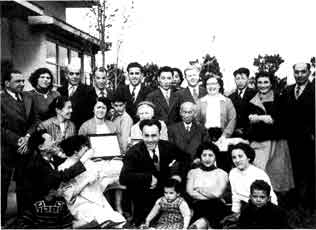
click here for larger image
1955. Children in front: Foad Katirai, Vedad Mumtazi and Farzad
131
Katirai. Front row: Mr. Robert Imagire, Mrs. Nehzat Imagire, Mr. Ataullah Moghbel, Mrs. Pouran Mumtazi, Mrs. Revzanieh Katirai. Middle row: Miss Yoshiko Morita, Mrs. Behjat Mumtazi, Abbas Mumtazi, Miss Agnes Alexander, Mr. Eichu Kim. Standing. Mr. Philip Marangella, Mrs. Frouz Mohtadi, Mr. Yadollah Rafaat, Mr. Parvis Mumtazi, Mr. Abbas Katirai, unidentified, Miss Lecile Webster, Dr. David Earl, Mrs. Virginia Hamilton, unidentified, Mrs. Mahin Moghbel and Mr. Aziz Mohtadi.
Chapter 54
The Guardian knew that it was difficult for the small but expanding
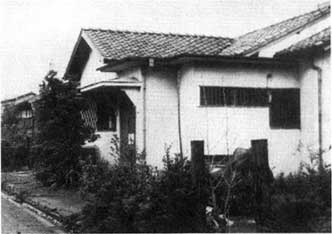
The Tokyo Haziratu'l-Quds at the time it was purchased by the Local Spiritual Assembly of the Bahá'ís of Tokyo, 1954. It was enlarged and improved through the years.
In 1954 the Guardian wrote to the Local Spiritual Assembly of Tokyo that the matter was urgent and should be accomplished that year. He sent a large personal contribution for this purpose. Hand of the Cause Mrs. Amelia Collins also contributed, as she did for all the Haziratu'l-Quds' which needed to be purchased during the Ten Year Crusade. The National Spiritual Assembly of the Bahá'ís of the United States made a sizeable contribution, as that body had been given responsibility for the development of the Faith in Japan in those early years of the Ten Year Crusade. Of course, all the Bahá'ís in Japan were invited to participate by contributing and according to early records, many were glad to do so. Enough money was raised.
When a search by the Local Spiritual Assembly of Tokyo failed to find a suitable building, a member of the assembly, Mr. Rafaat, offered to sell his modest house to the Tokyo Assembly

click here for larger image
A Bahá'í group in front of the entrance to the Tokyo Haziratu'l-Quds, about 1958. Standing are Mr. Rafaat, Mr. Marangella, Mrs. Hazel Mori (who was visiting Japan), and Mrs. Joy Earl. Kneeling are Mr. Haruo Nekomoto and Mr. Kiyoshi Hashimoto.
A cable was sent to the Guardian after the transaction was completed Dec. 18, 1954. He replied by cable, "Delighted Loving Prayers."
It was the second Haziratu'l-Quds in Japan, and in the Orient. The first was in Amagasaki, Japan, donated by Mr. Noureddin Mumtazi in 1953. The third Haziratu'l-Quds in Japan was in Osaka. In 1958 Mr. Hassan Naderi donated his residence. Through the years the value of the land escalated so greatly that a little over twenty years later, the national assembly found that by selling the original Osaka property, there were enough funds to buy another much needed Haziratu'l-Quds in Osaka, and also build a new Bahá'í Center for Tokyo.
The Tokyo Bahá'í Center, as it was called, had served the Bahá'ís well for twenty-eight years. It had played host to fourteen

The new Tokyo National Haziratu'l-Quds built in 1982 to accommodate the ever-growing Bahá'í community. It was built on the same land as the old Center.
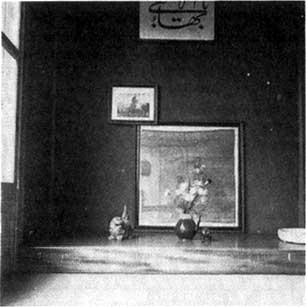
A precious brocade from the Shrine of Bahá'u'lláh hangs in the National Haziratu'l-Quds in Tokyo.The Guardian encouraged the institutions of the Faith to develop their archives. Even as early as 1937 he gave Miss Alexander a photograph of 'Abdu'l-Bahá which he said was for the archives in Japan.
When Mr. Hiroyasu Takano made his pilgrimage in 1954 the Guardian gave him a brocade to take back to Tokyo, a sacred and precious relic which he said had rested immediately over the Remains of Bahá'u'lláh in His Shrine. The Guardian said it should eventually be hung in the Haziratu'l-Quds of the national assembly. As there was no national assembly at the time, the Tokyo Local Spiritual Assembly had it framed and it has been displayed in the Tokyo Hazira ever since.
One time years ago, in 1960, Miss Alexander stayed six weeks in the Tokyo Hazira. We can remember her saying that she felt the brocade had such significance that she loved looking at it and saying her prayers near it. She said, to her, it was the holiest spot in the Orient.
Although the brocade appears to be the whole piece, Mr. Takano recalls the Guardian dividing it into two pieces, one of which went to another country.
In 1982 it was torn down and a handsome three-story building erected on the same land, using the funds from the sale of the Osaka property and special donations from dedicated Bahá'ís.
Chapter 55
The Asia Teaching Committee of the National Spiritual Assembly of the United States informed the Tokyo Local Spiritual Assembly that the first Asian Teaching Conference would be held in Japan. The Tokyo Local Spiritual Assembly selected the date, the location, and made all the arrangements for the conference, which became known thereafter as the "Nikko Conference."
In the Guardian's Message to the twelve national conventions that year, 1955, he reviewed some of the accomplishments of the Ten Year Crusade, and he announced that in 1957, thirteen new national assemblies were to be elected, among these would be one in Japan. It was to be a regional assembly with its seat in Tokyo. He assigned Hand of the Cause Jalal Khazeh to act as his representative at that future national convention.
There were only two local spiritual assemblies in Japan in 1955. Six more would be needed to form the basis for the national spiritual assembly. They would have to be formed by Ridván 1956 in order to elect delegates to the national convention. In addition to Japan, the regional area would consist of Korea, Taiwan, Hong Kong and Macau, so there also needed to be
In September 1955, at the close of the Nikko Conference, it seemed almost impossible to form so many more local assemblies in so short a time, but by determined teaching efforts, confirmations, even miracles, it was accomplished by April 21, 1956. Eight local spiritual assemblies were formed either by election or by joint-declaration in Japan and four other assemblies, Kwangju and Seoul in Korea, Tainan in Taiwan, and Hong Kong, were elected to make a total of twelve. All the assemblies had pioneers as members, but the majority of the Bahá'ís on the assemblies were native people of the various countries.
To go back to 1955, that year Mr. Noureddin Mumtazi
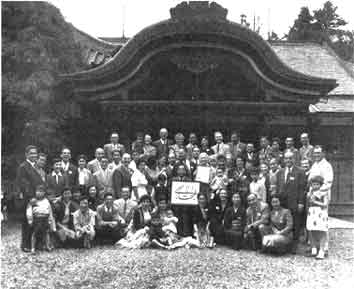
click here for larger image
In 1955 there was the first mention of the Faith in Nagasaki since the time Miss Alexander visited there in the 1930s. Miss Inatsuka of Tokyo had gone there to visit family members. Dr. and Mrs. Earl went to Nagasaki from Yamaguchi, where they were living, and joined Miss Inatsuka. She had arranged for them to meet some people to discuss the Faith. But it was not until several years later that there were enrollments in the city.
In 1955 Miss Alexander, with Mr. and Mrs. Torii, attended an Esperanto meeting in Tokushima, Shikoku Island. They then
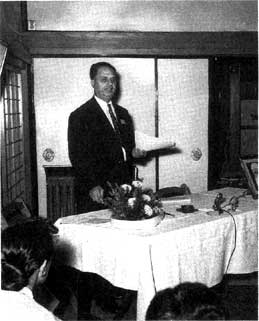
Hand of the Cause Mr. Zikrullah Khadem, the Guardian's representative at the Nikko Conference speaking to the friends.
The same year the three of them went to Ichikawa and Fukui Prefectures for meetings of the Blind Association. Miss Alexander said her association with Esperantists and with the Blind Association offered many opportunities to speak of the Faith, often to very large groups.
In 1955 Mr. and Mrs. Aziz Mohtadi settled in Nagoya and succeeded in establishing a community which could form a local spiritual assembly the next year.
In 1956, with the needed number of local spiritual assemblies formed, and the proper number of delegates elected, the Bahá'ís looked forward to the formation of the first National Spiritual Assembly of North East Asia.

Miss Agnes Alexander at the Nikko Conference. She sent this photograph to the Guardian with these words written on the back, "Agnes roars the Cause of God!" Miss Linfoot, chairman of the conference is sitting at the table.
Mr. and Mrs. Katirai visited Awaji island, and also made several trips to the island of Shikoku, resulting in the declaration of the first Bahá'í in Takamatsu, in October 1957, an eighteen-year-old student, Teruyoshi Ando. He is not to be found today. As had happened in other places, often the early believers did not really understand the greatness of the Teachings of Bahá'u'lláh, and although they were sincere at the time, they would move, leaving no address, or simply cease activity. But then, by contrast, there were those who, knowing little, declared themselves, and through the years gained and deepened in knowledge of the Faith and remained steadfast and loyal adherents.
In the late 1950s Dr. Earl visited Sendai and other goal cities for some extension teaching.
Mr. Mumtazi, who was living in Kobe, during 1956 and 1957, went to several islands and towns; Uno Island, Te Island, Nao Island, Himeji, Okayama, Itami, Akashi and other places.
It was not easy in those days. Mr. Mumtazi wrote of his experience teaching in Akashi. He went alone, knowing no one, speaking no Japanese. He could not find any place to have meetings. He happened to meet the manager of a Buddhist Temple, Mr. Tadasu Miyazawa (see Ch. 69), who allowed him to have meetings in one of their rooms. After a year of regular meetings, several people became Bahá'ís, including Mr. Miyazawa. In 1958 an all-Japanese local spiritual assembly was formed there. It was the second all-Japanese one. Nagoya was the first, in the Ridvan 1957 election. Mr. Miyazawa remained a faithful Bahá'í until his death in 1971.
The first Japanese believer in Kobe, Mr. Rihei Sako and Mr. Mitsuteru Oka, another Kobe Bahá'í, accompanied Mr. Mumtazi on several teaching trips.
Mr. Hassan Naderi moved with his family to Osaka, in April 1956. After settling there, he became greatly discouraged as he couldn't communicate and he had no business. He bought a house in Osaka for himself and his family where all the meetings were held. Then in 1958 he donated his house to the national spiritual assembly. As is described elsewhere, that donation
In 1957 Mr. William Maxwell, the national spiritual assembly chairman, who was pioneering in Korea, made a circuit teaching trip visiting Tokyo, Akashi, Osaka, Nishinomiya,

click here for larger image
Seventeen of the nineteen Japanese Bahá'ís who attended the Nikko Conference in 1955. From the left: Miss Sadae Takeuchi, Miss Yoshiko Morita, Mrs. Suna Mori, Mr. Haruo Nekomoto, Miss Yoko Majima, Mr. Yuzo Yamaguchi, Miss Isao Sakamoto (Zenimoto), Mrs. Katsuko Ishii, Mr. Saichiro Fujita, Mrs. Kaneko Zenimoto, Mr. Takeshi Ishii, Mrs. Yuriko Furukawa, Miss Yukiko Inatsuka (Hosoda), Mr. Michitoshi Zenimoto, Miss Sumiko Nonaka, Mr. Hiroyasu Takano, Miss Kotoko Mochizuki (Honma). Missing from the photograph, but attending the conference, were Mr. Gekie Nakajima and Mr. Takeo Hasegawa.
In 1957 the Bahá'ís in Hiroshima had extension teaching activities in Kure, Iwakuni and Atsuyama.
By 1958 Mr. Labib had extended his activities to Fukuoka and Sasebo in Kyushu Island.
In those early days the Faith was spread largely through the efforts of the pioneers. As mentioned before, virtually all the Persians and Americans made periodic teaching trips to other islands or to nearby towns which were goals of the national assembly or local assemblies.
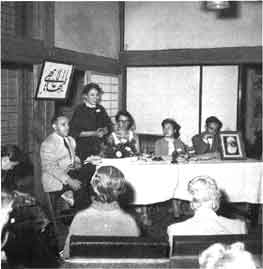
click here for larger image
Mrs. Joy Earl, early American pioneer to Japan, speaking to the conference. Seated from the left: Mr. Rouhollah Mumtazi, Miss Virginia Breaks (pioneer to the Caroline Islands), Miss Yukiko Inatsuka and Mr. Michitoshi Zenimoto.
Mr. Gekie Nakajima, an Osaka Bahá'í, also went on teaching trips; probably the most memorable was to Hokkaido in 1957 with Mr. Rouhollah Mumtazi, (see Ch. 67).
Due to the teaching efforts during the late 1950s, by 1960 there were Bahá'ís in thirty-three localities twice as many as there were in 1956.
By 1959 there were about a dozen publications in Japanese which included the revised edition of "The Hidden Words of Bahá'u'lláh" and "Bahá'u'lláh and the New Era." There was also a prayer book and several pamphlets.
A great achievement in 1959 was the purchase of a site for a future Mashriqu'l-Adkar near Tokyo. The new national spiritual assembly spent much time consulting on how to achieve the goals which had been given by the Guardian just four months before he passed away.
Hand of the Cause Zikrullah Khadem was the Guardian's representative. Miss Alexander attended in her capacity as
As it was a regional conference, Bahá'ís from the Pacific and other Far East areas were invited. About sixty adults and several children of pioneers attended. Most attendants came from Japan of course, but also as far away as Guam, Taiwan, Korea, Hong Kong, Macau, Iran and the Caroline Islands. Miss Charlotte Linfoot represented the National Spiritual Assembly of the United States, and was the conference chairman.
The conference had a two-fold purpose; first, to expedite teaching plans that would bring into existence a sufficient number of new assemblies to ensure the election of the new National Spiritual Assembly of North East Asia. The other purpose was to give impetus to the teaching in all the nearby countries.
There were many speakers at the conference. Mr. Khadem spoke on the Will and Testament and the Guardianship; Mrs. Mamie Seto on the Covenant. Miss Linfoot spoke on the goals of the Ten Year World Crusade, which was then in its second year. Mr. Hiroyasu Takano told of his pilgrimage during which the Guardian unfolded his hopes and goals for Japan. A highlight was having Mr. Saichiro Fujita tell of his years with 'Abdu'l-Bahá. Fujita was soon to leave Japan for the Holy Land at the Guardian's invitation. He stayed there, not to return to Japan again.
In September that year, there were sixty-three Bahá'ís in Japan, of whom thirty-nine were Japanese. The rest were Americans and Persians who had responded to the Guardian's call for pioneers. Special efforts were made to assist all Japanese to attend the conference. Of the thirty-nine, nineteen attended.
It was a "first" for many of the Bahá'ís attending. They had had no experience of being surrounded by Bahá'ís and living in a Bahá'í atmosphere. The loving spirit of Bahá'í brotherhood which prevailed touched the hearts.
The conference sent a greeting cable to the Guardian and received a reply before the last session. "Deeply appreciate sentiments fervently praying unprecedented victories. Deepest love, Shoghi."
The conference, and the prayer of the Guardian, did indeed bring about "unprecedented victories" and it marked a turning point for the Faith, not only in Japan, but in all of North East Asia.
Chapter 56
One of the goals of the Guardian's Ten Year Crusade was to form a national spiritual assembly in Japan. At the time the Crusade was launched in 1953, there was only one local spiritual assembly in the northern Asia area. However, just four years later the National Spiritual Assembly of North East Asia was elected. Its seat was to be in Tokyo and its scope was Japan, Korea, Taiwan, Hong Kong and Macau. The islands of Hainan, off the coast of China, and Sakhalin, north of Japan, were included in the original jurisdiction. Later Hainan Island was assigned elsewhere and Sakhalin Island remains one of the areas for the National Spiritual Assembly of Japan to open.
The year before, 1956, a total of eight local spiritual assemblies were elected or formed by joint declaration in Japan. Four additional assemblies were elected in Korea, Taiwan and Hong Kong. With twelve local spiritual assemblies participating, the National Spiritual Assembly of North East Asia was elected by the delegates.
Hand of the Cause Mr. Jalal Khazeh, as the Guardian's representative to the convention, presented the Guardian's message (in part here): "With feelings of exultation, joy and pride I hail the convocation of this history-making Convention of the Bahá'ís of North East Asia, paving the way for the emergence of a Regional Spiritual Assembly with an area of jurisdiction embracing Japan, Korea, Formosa, Macao, Hong Kong, Hainan Island and Sakhalin Island.
"This auspicious event, which posterity will regard as the culmination of a process initiated, half a century ago, in the capital city of Japan, under the watchful care and through the direct inspiration of the Centre of the Covenant of Bahá'u'lláh, marks the opening of the second chapter in the history of the evolution of His Faith in the North Pacific area. Such a consummation cannot fail to lend a tremendous impetus to its onward march in the entire Pacific Ocean.
Elected to the first National Spiritual Assembly of North East Asia were two Japanese, three Persians and four Americans, one of whom was Miss Agnes Alexander, who just the month before,

click here for larger image
The First Annual Convention of the Bahá'ís of North East Asia, held at Gakushi Kaikan in Tokyo, Japan, 1957. Hands of the Cause Miss Alexander and Mr. Khazeh are holding the frame containing the "Greatest Name."
A new era in the development of the Faith in the North East Pacific area had begun.

click here for larger image
The first National Spiritual Assembly of the Bahá'ís of North East Asia, 1957. Seated: Mr. Noureddin Mumtazi, Hand of the Cause Miss Agnes Alexander, Mrs. Barbara R. Sims and Mr. Hiroyasu Takano. Standing: Mr. Ataullah Moghbel, Mr. Michitoshi Zenimoto, Mr. Philip Marangella, Mr. Yadollah Rafaat and Mr. William Maxwell.
Chapter 57
Mr. Seto was the first Chinese-American Bahá'í. His parents came from Canton, China and settled in Hawaii, where he was born. He became a successful attorney and an astute businessman. He married Miss Mamie O'Connor, a bright-eyed woman of Irish background. Together in 1916 they accepted the Faith and served it until the end of their days. In 1920 'Abdu'l-Bahá wrote in a Tablet to them "The East and the West have embraced each other."
Mrs. Seto was a fine speaker, deepener, and an administrator,

click here for larger image
This classic photograph was taken during the Nikko Conference in 1955. Mr. Fujita (left), the second Japanese to become a Bahá'í, and Mr. Seto, the first Chinese-American Bahá'í.
having served on the National Spiritual Assembly of the United States.
After Mr. Seto retired from his law practice, he and his wife answered the Guardian's call for pioneers during the Ten Year Crusade. It was 1954 when they landed in Hong Kong, among the first pioneers to settle there to establish the Faith.
When the first Convention of the Bahá'ís of North East Asia, which included Hong Kong, was held in Tokyo in 1957, Mr. and Mrs. Seto attended. He was the only Bahá'í of Chinese background at the convention. A few days after the convention, as he and his wife were boarding the plane to return to Hong Kong, Mr. Seto was stricken with a heart attack and died. He is buried in the Yamate-machi Foreign Cemetery on the bluff in Yokohama.
Shortly after Mr. Seto's passing the Guardian wrote to the newly-elected National Spiritual Assembly of North East Asia these words about Mr. Seto, whose destiny laid him to rest in Japan.
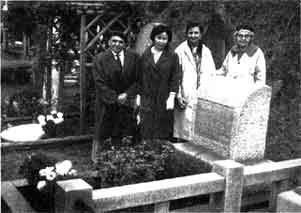
click here for larger image
Mrs. Mamie Seto (far right) visits her husband's grave in Yokohama about 1961. On the left is Mr. Philip Marangella, next Mrs. Akiko Schreiber (her husband Eugene was the photographer), and Mrs. Sims.
"...Even the death of the devoted pioneer, Mr. Anthony Seto, has added a blessing to the work in that region, for he served in spite of failing health and remained at his post to rest in a distant land, his very dust testifying to the greatness of the love and nature of the ideals Bahá'u'lláh has inspired in His servants."
Although her husband's death was a crushing blow, Mrs. Mamie Seto remained at her pioneer post in Hong Kong until the end of the Ten Year Crusade.
Chapter 58
Among the early teaching conferences in Japan was this one in Kyoto in September 1956. Fifty-eight adults and fifteen children attended. A greeting was sent to the Guardian, Shoghi Effendi. His answering cable was: "Deeply appreciate message. Welcome renewed dedication. Fervently supplicating great victories."About half of the attendants were Japanese, the rest were American and Persian pioneers. Most of the children were Persian.
Miss Alexander is sitting in the second row, second from the left, between Mrs. Torii and Mrs. MacDonald.
The first regular Bahá'í meetings in Osaka were held in a hotel such as this. This meeting was either in 1956 or 1957. There are about twelve Persians in the photo. They were working very hard to establish the Faith in the Kansai area. Mr. Marangella is sitting third from the right, middle. He was often the speaker at such gatherings.
Chapter 59
Miss Alexander was a prominent guest at the wedding as Mr. Zenimoto considered her to be his spiritual mother. Mr. Zenimoto recalls, "Miss Alexander was elated during the wedding. She insisted that I must have a daughter and call her Mary, and she went on to tell me that her dearest friend and spiritual mother,
"I protested to Miss Alexander that I had only just married, but that I appreciated her sentiment. Ten years later a daughter was born to my wife and me. There was no question as to her name, Mari, the Japanese version of Mary.
"When Amatu'l-Bahá Ruhiyyih Khanum (the original Mary) blessed our home with her presence in 1979, she was very interested when we told her the story, because from her early childhood she had known and loved Miss Alexander."
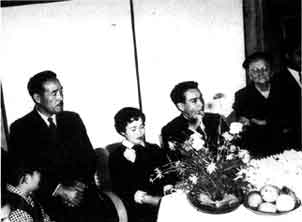
click here for larger image
At the wedding party of Mr. and Mrs. Michitoshi Zenimoto, at the Amagasaki Bahá'í Center, January 1956. To the left is Mr. Zenimoto's father. To the right is Miss Alexander.
Chapter 60
One of the earliest conferences after World War II was a three day religious conference held in Tokyo, September 1848. Mr. Goro Horioka, a Tokyo Bahá'í, spoke on the Faith during the last day of the conference.
After Miss Alexander returned to Japan, 1950, she continued to seek out opportunities to teach the Faith. In January 1952 she spoke at a meeting in Tokyo celebrating the third Annual World Religion Day. The meeting, which was sponsored by the Tokyo Local Spiritual Assembly was held at the YMCA. Announcements were put in both English and Japanese papers and information about the meeting was broadcast over NHK (the national radio network.) Mr. Horioka was chairman and Mr.

click here for larger image
World Religion Day meeting in Tokyo, 1952. About thirty people attended. Miss Alexander is speaking with Mr. Hongo translating.
Another conference in 1952 was the World Federalist Conference in Hiroshima. Miss Alexander officially represented the Bahá'í Faith. She said it was the Plan of God that she was seated next to a Chinese-Malaysian man who had come to Japan to attend the conference. Mr. Yan Kee Leong had heard of the Faith from Mrs. Shirin Fozdar in Malaysia, then called Malaya. He was greatly attracted to Miss Alexander and he felt she had the Truth. Shortly after he returned to Malaya he became a Bahá'í; the first Malayan Bahá'í. He was also the first Bahá'í of Chinese ancestry to be appointed as counsellor by the Universal House of Justice, some years later. He always felt a kinship with Japan and visited several times in subsequent years.
Miss Alexander spoke several times at the Japanese Unitarian church in Tokyo through her connections made years earlier.
In 1955 a Conference of World Religionists was held in Tokyo with some sessions in other cities. Dr. David Earl was the official Bahá'í representative. Three Bahá'ís attended every day, including Miss Alexander and Mr. Marangella. The Faith was brought to the attention of some two hundred religious leaders

click here for larger image
Conference of World Religionists, August 1955. Three Bahá'ís attending various sessions are seen in this newspaper clipping. Mr. Marangella is in the middle, Dr. Earl, seen in profile, and Miss Alexander.
International Congress of World Fellowship of Faiths, Tokyo, October 1956. Miss Alexander is in the first row a little to the left. Several other Bahá'ís can be seen also. The photograph was taken after the second session.This building, fashioned after the Palace of Versailles, was later closed to general public gatherings and reserved for Heads of State.
A meeting of the International Congress of World Fellowship of Faiths was held in Tokyo, October 1956. According to a booklet issued after the Congress, it was the tenth in a series of conferences, the first of which was the Parliament of Religions, Chicago, 1893, where the Bahá'í Faith was first mentioned publicly
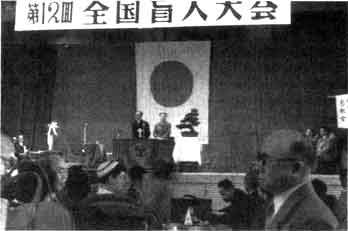
click here for larger image
The 12th National Conference for the Blind, Matsue, 1959. Miss Alexander is speaking with Mr. Torii translating.Regarding that particular trip to Matsue, Miss Alexander wrote, "In Matsue City, the 12th Annual Conference of the Blind Association was held. Through our brother, Mr. Tokujiro Torii, who is president of the Blind Association, I was given the privilege of speaking at the close of the conference for three minutes. It was translated into Japanese. Four hundred representatives from forty-six prefectures were present.
"The time was short but after every translation there was tremendous applause."
Miss Alexander stated that she had known Mr. Torii for forty years; that she was a Bahá'í; that the sight of the eyes was not the most important, but the sight of the heart was the all important; that everyone longed for peace but it could only come through the spiritual unity of all people.
While she was speaking she noticed that a man holding bright lights was standing in front of them. It was NHK (Nihon Hoso Kyokai) Television Network. Miss Alexander stated, "This was shown throughout Japan giving prominence to the Faith."
It was the second time the Faith was mentioned on television.
The Congress in Tokyo was opened by the Vice President of India, Dr. S. Radhakrishnan. Bahá'ís had been invited to participate and were represented on the program by Mr. Philip Marangella and Lt. Lawrence Hamilton. Miss Alexander and some twelve other Bahá'ís attended various sessions. Twenty-one different countries were listed as being represented, with three hundred and fifty people attending the first day.
In 1959, the Ladies Society for Aid to the Blind held a concert in Tokyo, which was recorded for later radio broadcast. A
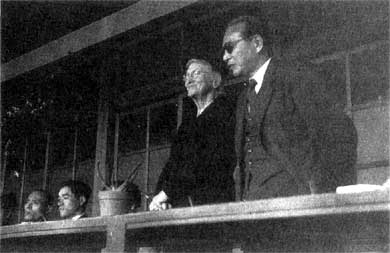
This photograph was in Miss Alexander's effects. She did not label it, so we do not know the occasion. However, it seems rather typical. Miss Alexander often accompanied Mr. and Mrs. Torii to both Esperanto and Blind Association conferences.In both types of events she was usually able to speak publicly, in English or Esperanto, with Mr. Torii translating. This photograph was taken during one such conference, probably one of the Blind Association in the late 1950s or early 1960s. In those early days foreigners were somewhat of a novelty in Japan and Miss Alexander often attracted attention and people listened to what she had to say.

click here for larger image
Esperanto Congress in Nagoya, May 1965. In the top photograph Miss Alexander is seen sitting among the participants. In the bottom one she is speaking to the Congress. An old friend, Mr. Kataoka is translating.Miss Alexander stayed as active as possible in Esperanto activities even through the later years. She felt that Esperantists were particularly receptive to the Faith.
This was the last Esperanto Congress she was able to attend. She came to Tokyo two months later to attend another one but before it opened she fell and broke her hip. She was hospitalized from then on.
In 1963 there was a conference of World Federalists in Tokyo. Mr. Finley Hollinger from the United States represented the Bahá'ís.
The World Conference on Religion and Peace, October 1970, in Kyoto was an important one. Mr. Glenford Mitchell, secretary of the National Spiritual Assembly of the Bahá'ís of the United States, was a delegate. Mrs. Shirin Fozdar was the Bahá'í delegate from Thailand. Dr. Toshio Suzuki, secretary of the National Spiritual Assembly of the Bahá'ís of North East Asia, was listed as an official observer from Japan. Three hundred delegates from more than one hundred and twenty-five countries attended. The three Bahá'ís mentioned had their photographs and biographies, in both English and Japanese, printed in the brochure which was distributed to all attendants.

click here for larger image
World Conference on Religion and Peace, Kyoto, October 1970. This photograph shows the Bahá'í representatives at the conference: Mrs. Shirin Fozdar, Mr. Glenford Mitchell, Dr. Toshio Suzuki and Mr. Rouhollah Mumtazi.
Chapter 61

click here for larger image
The cable sent to the Guardian from the Summer School reported that there were one hundred attendants in all, representing sixteen cities. The Guardian answered by cable: "Congratulate attendants historic summer school fervently praying expansion valued activities, love, Shoghi"Hand of the Cause Miss Alexander is sitting under the banner. Mr. Carl Scherer, Auxiliary Board Member from Macau is standing, back row, middle of the right side. In this photograph we can see thirty-six Japanese, twenty-four Persians, including one youth, seven Americans, including one youth and twenty-one children, Persian and Japanese.
Chapter 62
The Guardian stressed the great importance of establishing functioning local spiritual assemblies. The administration which was described and amplified by Shoghi Effendi is part of the Divine Revelation. When viewed in this light, the establishing of local assemblies, which in turn provide support for the national assemblies, are, as the smallest administrative unit, vital to the development and spread of the Faith.
For several years there was only one in Japan; the Local Spiritual Assembly of the Bahá'ís of Tokyo. Then in 1954 the Local Spiritual Assembly of Hyogo Prefecture was elected. It was composed entirely of foreigners, who, at that time could speak little Japanese but it started functioning in accordance with administration. In 1956 it was dissolved and three local assemblies were formed in cities within that prefecture.
In 1956 there were eight assemblies in Japan, one in Taiwan,

click here for larger image
Local Spiritual Assemblies were elected in Tokyo in 1948 and 1949 but left no photos that could be found. This particular photograph was taken in 1950. Seated are Miss Fusae Ichige, Mr. Goro Horioka and Miss Shigeko Nakanishi. Standing are Mr. Robert Imagire, Mr. Kinya Saito, Mr. Toshio Hirohashi, Mr. Naoki Yoshino, Mr. Yoshiharu Kato and Mr. Shozo Kadota.
The next year, 1957, the Local Spiritual Assembly of Hiroshima was elected. By 1958 there were eighteen local assemblies under the new national spiritual assembly; eleven in Japan; one each in Hong Kong and Macau; two in Taiwan; and three in Korea, in Seoul, Mokpo and Kwangju.
Years later, in 1974, when the National Spiritual Assembly of Japan was elected, there were over fifty local spiritual assemblies. Following are some of the first local assemblies:

click here for larger image
The second area to have a local spiritual assembly in Japan was Hyogo Prefecture. That assembly was formed in April 1954. Two years later it went out of existence and three were formed in the same area using city limits as areas of jurisdiction.The assembly consisted entirely of pioneers who had come to Japan that year or the year previously and who were laying the foundation for the administration. Mr. Datwani and his wife had come from India to Japan for business. They left soon after to reside in Hong Kong, among the first pioneers to settle there.
Seated are Mrs. Mahin Moghbel, Mrs. Behjat Mumtazi, Mr. Philip Marangella and Mrs. Pouran Mumtazi. Standing are Mr. Ataullah Moghbel, Mr. G. B. Datwani, Mr. Abbas Katirai, Mr. Noureddin Mumtazi and Mr. Rouhollah Mumtazi.
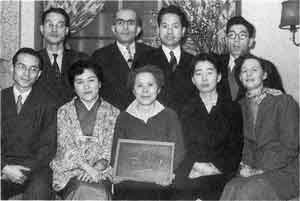
click here for larger image
This was the Tokyo Local Spiritual Assembly elected in 1954. It was the first incorporated assembly in Japan, as the incorporation was completed by April 1955. Tokyo directed the work of the Faith in all Japan until the first national spiritual assembly was elected. Seated are Mr. Hiroyasu Takano, Miss Fusae Ichige, Mrs. Yuriko Mochizuki Furukawa, Miss Kotoko Mochizuki and Mrs. Barbara Sims. Standing are Mr. Goro Horioka, Mr. Yadollah Rafaat, Mr. Tameo Hongo and Mr. Yuzo Yamaguchi.

click here for larger image
Seated are Mrs. Kaneko Sueki, Mrs. Toshiko Nakagawa, Mr. Hisateru Hattori and Miss Emiko Matsui. Standing are Mrs. Frouz Mohtadi, Mr. Chiyoyuki Sueki, Mr. Yoshiro Kato, Mr. Katsutaro Ito and Mr. Aziz Mohtadi.Mr. and Mrs. Mohtadi, pioneers from Iran, were able to stay in Japan for about two years. They went to Nagoya to establish the Faith there. After they left in November, 1956, it was the only community of all Japanese believers.
Mr. and Mrs. Sueki's son, Toshio, a second generation Nagoya Bahá'í, helped us with the identification.
The Local Spiritual Assembly of the Bahá'ís of Tokyo, 1956. This assembly, along with seven others which came into existence in 1956, sent delegates to the first national convention in 1957. From the left: Mrs. Virginia Hamilton, Miss Yoko Majima, Mr. Shozo Kadota, Miss Kotoko Mochizuki, Mrs. Barbara Sims, Miss Yukiko Inatsuka, Mr. Haruo Nekomoto, Mrs. Jean Eaton and Lt. Lawrence Hamilton.
click here for larger imageLt. and Mrs. Hamilton were caretakers of the Tokyo Bahá'í Center in 1955 and 1956. They left Japan shortly before the first convention. Lt. Hamilton did much remodeling and made improvements to the building to make it more effective as a center of activities.

click here for larger image
The first Local Spiritual Assembly of the Bahá'ís of Osaka, 1956. Seated are Mr. Eichu Kim, Mrs. Sedighe Naderi, Mrs. Chie Nakajima, Mrs. Afagh Naderi and Mr. Gekie Nakajima. Standing are Mr. Karim Naderi, Mr. Kayushi Utsumi, Mr. Hassan Naderi and Mr. Akira Okada.
The first Local Spiritual Assembly of the Bahá'ís of Kobe, 1956. Seated are Mrs. Tahereh Kazempour, Mr. Rihei Sako (the first Japanese Bahá'í of Kobe), Mr. Morio Nakamichi, and Mrs. Behjat Mumtazi. Standing are Mr. Noureddin Mumtazi, Mr. Eiichiro Yokoyama, Mr. Nario Sawada, Mr. Takeo Katayama and Mr. Abbas Kazempour.
click here for larger image
The first Local Spiritual Assembly of the Bahá'ís of Nishinomiya, 1956. Seated are Mrs. Pouran Mumtazi, Mrs. Rezvanieh Katirai, Mrs. Talat Mahboubi and Mr. Tawad Mahboubi. Standing are Mr. Rouhollah Mumtazi, Mr. Abbas Katirai, Mr. Naomi Hashimoto, Mr. Yoshimitsu Yamamoto and Mr. Philip Marangella.
The first Local Spiritual Assembly of the Bahá'ís of Kyoto, 1956. Seated are Mr. Jun Koyama, Mr. Masazo Odani, Miss Agnes Alexander, Mr. Tokujiro Torii and Mr. Seiichiro Tsunemi. In the back row are Mrs. Shizue Tsunemi, Mrs. Ito Torii, Miss Yoshiko Morita and Mr. Makoto Inaba.
click here for larger image
The first Local Spiritual Assembly of the Bahá'ís of Amagasaki, 1956. Seated are Mrs. Isao Zenimoto, Mrs. Mahin Moghbel, Mrs. Katsuko Ishii and Mrs. Kian Vahdat. Standing are Mr. Ataullah Moghbel, Mr. Takeshi Ishii, Mr. Heshmat Vahdat, Dr. David Earl and Mr. Michitoshi Zenimoto.
The first Local Spiritual Assembly of the Bahá'ís of Yokohama, 1956. In the front row are Mr. Roy MacDonald, Mrs. Louise MacDonald, and Miss Yuriko Mizuno. In the middle row are Mr. Koji Akizawa, Mr. Takao Mizuno and Mr. Takatoshi Tanaka. In the back row are Mr. Hitoshi Sakamoto, Dr. Ikuo Mizuno and Mr. John McHenry III.
click here for larger image

click here for larger image
The first Local Spiritual Assembly of the Bahá'ís of Hiroshima, 1957. Seated are Miss Sachiko Watanabe, Mrs. Bazaieh Assassi and Miss Kimi Masuda. Standing are Mr. Mohsen Assassi, Mr. Saishin Yasumoto, Mr. Toshio Arai, Mr. Michitaka Honkawa, Mr. Shuzo Nakai and Mr. Muhammad Labib.
The second Local Spiritual Assembly of the Bahá'ís of Hiroshima, 1958. Seven of the nine members had changed from the year before. Seated are Mrs. N. Sharifi, Miss Sachiko Watanabe, Mrs. Bazaieh Assassi, Miss Eiko Yuasa and Miss Noriko Matsuura. Standing are Mr. Tsuenori Nakamae, Mr. Hirokazu Arai, Mr. Yukio Hanada and Mr. Sharif Sharifi.
click here for larger image
Three members of the Arai family became Bahá'ís. Mr. Hirokazu Arai eventually died from the lingering effects of the devastating Hiroshima bombing.
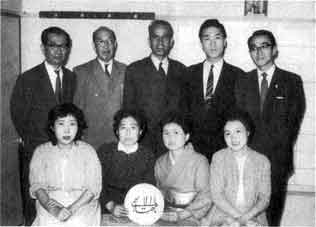
click here for larger image
The first Local Spiritual Assembly of the Bahá'ís of Itami, 1958. Seated are Mrs. Setsue Kimura, Mrs. Masako Fujishima, Mrs. Hide Takada and Mrs. Katsuko Ishii. Standing are Mr. Yasuo Kobayashi, Mr. Takeshi Ishii, Dr. Atauallah Mottahedin, Mr. Rohei Kobayashi and Mr. Keiji Takada.
The first Local Spiritual Assembly of the Bahá'ís of Akashi, 1958. Seated are Mrs. Fumiko Kojima, Mr. Tadasu Miyazawa and Mrs. Toshiko Kojima. Standing are Mr. Eitaro Kojima, Mr. Masami Morii, Mr. Sanjiro Moriyama, Mr. Kota Nakahama, Mr. Yoshimi Kojima and Mr. Akemitsu Kojima.
click here for larger image

click here for larger image
The first Local Spiritual Assembly of the Bahá'ís of Nagasaki, 1959. To celebrate the first Local Spiritual Assembly of Nagasaki, Mr. Labib had a small 8-page pamphlet printed in English, Japanese and Persian. This is one of the pages. In the middle are the local spiritual assembly members. Top: Mr. Kazuyuki Miyazaki, Mr. Kiyoshi Seto and Mr. Noboru Ueda. Middle: Mr. Tamotsu Furudono, Mr. Akio Seki and Mr. Hidero Seshita. Bottom: Mr. Yoshizo Fujisawa, Mr. Muhammad Labib and Mr. Shigeo Hario.
The first Local Spiritual Assembly of the Bahá'ís of Sapporo, 1959. Front row: Mrs. Kikue Kuzumaki, Miss Seiko Saida, Miss Hisako Takahashi, Mr. G. V. Tehrani and Mr. Yoshiro Sasaki. Back row: Miss Keiko Doi, Mr. Kinkichi Shimatani, Mr. Nobuo Takase and Mr. Kazuo Kuzumaki. Mr. Sasaki was the first person to become a Bahá'í in Hokkaido, and Mr. Shimatani the second. Mr. Tehrani, the first pioneer to settle in Hokkaido (1957) did many years of unforgettable service and was very much loved by all.

click here for larger image
Chapter 63
In the Guardian's message to the first National Convention of the Bahá'ís of North East Asia (1957), and again in a later message, he emphasized that the Faith must be taken to the other smaller islands of Japan. Hand of the Cause Mr. Khazeh, who met with the newly formed national spiritual assembly suggested that someone settle in Kyushu as well as other islands.
Actually there was a Bahá'í already living in Kyushu, in Miyazaki Prefecture, Mr. Takeo Hasegawa. He had become a Bahá'í while in the United States, where he had gone to study in the early 1950s. He tells this story: He and another Japanese student were at a university in Texas. One day while they were walking on campus, a friendly elderly woman approached them.

June 1957, Mr. Katirai, middle, and Dr. Mottahedin, right, are about to leave Mr. Labib in Nagasaki. They stayed three days to help him get settled, during which there was a typhoon.
Mr. Hasegawa returned to Japan and had attended the Nikko Conference in 1955, but Miyazaki Prefecture was far away and he was not seen again for many years.
Mr. Muhammad Labib was living with Mr. and Mrs.
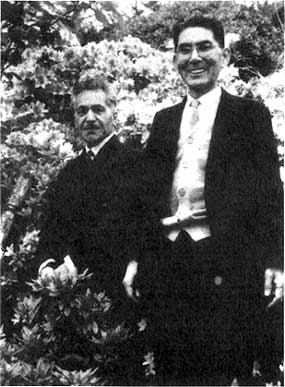
Mr. Muhammad Labib, the first pioneer to settle in Kyushu, with Mr. Shigeo Hario, who was the first to accept the Faith (1958) in Kyushu. This photograph was taken about 1959.
Many years later Mr. Katirai recalls the trip. "When we reached Nagasaki a typhoon was beginning. It had been a long trip and the three of us were quite dirty, because the train was coal-burning, no diesel trains there yet. At first, we couldn't find any place to go to clean up. To add to the problems Mr. Labib had an infection in his toe. His foot had swelled so much that he could not walk and he needed to have it attended to. I carried him on my back to a hospital we were directed to.
"When we entered the hospital, we saw the staff sitting at

click here for larger image
The first Bahá'í wedding in Kyushu was the marriage of Miss Akiko Enokida and Mr. Eugene Schreiber in Nagasaki in 1959. Mr. Labib is standing at the far right.
It was difficult for many pioneers in those days, both Americans and Persians, and especially for those with limited finances.
Mr. Labib was elderly, alone, knowing no Japanese, with barely enough funds. His situation was similar to that of Mr. Tehrani, the first to pioneer that same year to the northern island of Hokkaido.
Mr. Shigeo Hario, the first Japanese to become a Bahá'í in Kyushu, told the story of his friendship with Mr. Labib. It was late 1957 or early 1958. Mr. Hario was retired, but teaching part-time in a high school. He was also studying Japanese dance. One of the men in the dance class said a foreigner was renting a room at his house but he didn't know why. Perhaps the foreigner was a spy. Mr. Hario could speak fluent English so the man asked him to come and meet the foreigner.
Mr. Labib, vital and dedicated, had come to Nagasaki just a few months before. When the two men met it was the beginning of a close friendship. Together they did much service for the Faith. Mr. Hario said Mr. Labib came to his house almost every day, and they often went out meeting people, Mr. Labib talking and Mr. Hario translating. They sometimes went to schools where Mr. Labib would offer to speak on a variety of subjects, introducing the Faith, and making friends.
Mr. Hario was a Buddhist and came from a high-class samurai family. He read many Bahá'í books in both English and Japanese before he became a Bahá'í, but, he said, what originally attracted him to the Faith was Mr. Labib and his life.
Mr. Labib wanted to have a Bahá'í Center for Nagasaki so he could have more regular meetings. He and Mr. Hario searched for the land and had the Center built a couple of years later. A young American Bahá'í, Mr. Eugene Schreiber, an engineer who was working on an island nearby, generously contributed the money. Mr. Schreiber's marriage to Miss Akiko Enokida in 1959 was the first Bahá'í wedding in Kyushu.
Mr. and Mrs. Schreiber recall Mr. Labib and Mr. Hario with great affection. They said Mr. Labib made all the wedding arrangements and invited the people. Mr. Hario performed a traditional dance for the wedding guests.
Chapter 64
The following two photographs, taken about 1959, show meetings on Shodo Island and Shikoku. These meetings, and many others, were arranged in response to the goal of taking the Faith to other islands.

click here for larger image
This was outside a school on Shodo Island where Mr. and Mrs. Katirai, standing on the right, went for teaching. They were accompanied by Mr. Toshikazu Taniguchi, a fairly new Bahá'í from Takamatsu, standing to the left with his arm on Farzad Katirai. Next standing is Mr. Tatsuo Shiomoto and Mr. Masazo Odani. Mr. and Mrs. Shiomoto were the first Bahá'ís of Shodo Island, 1959.
This was taken at one of the early meetings in Takamatsu, Shikoku Island. Mr. and Mrs. Katirai are seated in front. In the back row, fourth from the left is Mr. Ando, the first Bahá'í of Shikoku. Mr. Odani is standing third from the right. Mr. Hisashi Taniguchi, father of Toshikazu, is standing between Mr. Odani and Mr. Shiomoto who had accompanied the Katirais. Mr. Shiomoto introduced the Katirais to the Taniguchi family. Four of them became Bahá'ís, active through the years.

Mr. Kota Nakahama
They then went to Takamatsu and Toyoshima to find people to talk to. Then on to Uno and Himeji, where Mr. Tetsukawa became the first person in Himeji to become a Bahá'í.
Mr. Nakahama noted that although they were visiting out-

click here for larger image
A discussion of the Faith among students of Shimane University in Matsue, May 1959. Mr. Moghbel, standing second from the left, accompanied Miss Alexander (next to Mr. Moghbel) and Mr. and Mrs. Torii, standing next to Miss Alexander. Miss Alexander and the Toriis had gone to Matsue for a conference for the blind.At the end of that year, the first believer Mr. Akira Yamamoto, standing far left, enrolled in the Faith.
After this trip Mr. Nakahama wrote that he felt there was a love and sincerity which transcended race and he could see that this could be a foundation for the oneness of mankind.
Mr. Nakahama made a chart in Japanese of Bahá'í history shown chronologically. It was printed and was a welcome addition for deepening.

click here for larger image
This photograph was taken at the home of Professor Mizoue in 1960. She is seated between Mr. Moghbel and Mr. Masazo Odani. Mr. Shimabara is standing, left. Miss Matsuura is in the middle and Mr. Yamamoto is standing to the right. It was the second trip for Miss Matsuura. She and Mr. Odani were among the first Japanese Bahá'ís to arise to actively teach the Faith in other cities. Professor Mizoue, and the student Mr. Shimabara, were friends of Bahá'ís but did not become Bahá'ís.
In 1959 Mr. William Smits, a pioneer in Korea, made a teaching trip to Japan. Among the places he visited was Matsue. In that city was a man Mr. Asano, who had heard of the Faith from Dr. Earl. Mr. Asano introduced Mr. Smits to many Shimane University students, among them was Mr. Yamamoto who was attracted to the Faith.
Miss Noriko Matsuura was a student at Hiroshima University in 1959, when she made her first teaching trip to Matsue alone. Mr. Yamamoto met her at the station and took her to meet his family and other students. Some of the students had previously met Miss Alexander and Mr. Ataullah Moghbel.
After a meeting during which the Faith was discussed in depth, the group went to see an exhibition of the work of the famous potter, Mr. Bernard Leach. Miss Matsuura happened to have a copy of Mr. Leach's pamphlet, "My Religious Faith" in which he describes how and why he became Bahá'í.

click here for larger image
Seeing Miss Alexander off at Hiroshima station in 1958. Miss Alexander, second from the left, often visited Hiroshima. From the left are Hiroshima residents, Mr. Sharif Sharifi, Miss Noriko Matsuura and Mrs. Bazaieh Assassi. It was the next year that Miss Matsuura went to Matsue alone. Miss Alexander wrote to her that she was an example for other Japanese women.
Chapter 65
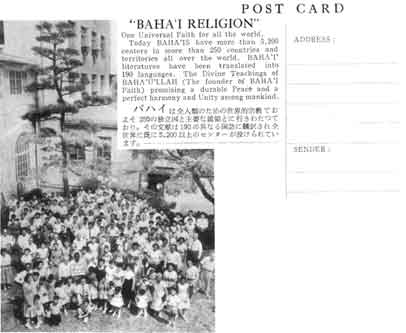
click here for larger image
Mr. Muhammad Labib took this interesting photograph of the third summer school in Japan in 1959, with a rather antique camera. He printed large copies for distribution, and also made it into a cover for note paper. Being one to seize every opportunity to proclaim the Faith, he also made it into a post card, shown here.At this summer school the average daily attendance was one hundred and forty-five.
Chapter 66
Miss Alexander often went around to the different communities to help with the teaching. Here she is with her typical smile, with Mr. Kiyoshi Nonoda and Mr. Yoshihiro Ogawa, two of the early believers in Osaka. Mrs. Nonoda is standing second from the left. The other women were friends of hers. The photograph was undated but was probably taken in the late 1950s or early 1960s.
Chapter 67
In December 1956 the Guardian wrote of some of the tasks the National Spiritual Assembly of North East Asia, soon to be formed, should undertake. One was to extend the teaching work to Hokkaido and if possible have someone settle there.
Several months later in his message to the first National Convention of North East Asia, April 1957, the beloved Guardian gave several specific goals to the new national spiritual assembly. Among them was to spread the Faith throughout the other islands of Japan.
It was in relation to this goal that Mr. Gekie Nakajima of Osaka and Mr. Rouhollah Mumtazi undertook an eleven-day teaching trip to the large northern island of Hokkaido. There were no Bahá'ís there, and none had gone since the memorable visit of Miss Alexander, who, in 1932, was invited to Hokkaido

click here for larger image
Mr. Gekie Nakajima (standing at the left) and Mr. Rouhollah Mumtazi with Ainu friends during their trip to Hokkaido, June 1957.
On June 8, 1957, Mr. Nakajima and Mr. Mumtazi left Osaka and made the two-day trip to Hokkaido by train and ferry. There they visited several cities: Sapporo, Hakodate, Otaru and the Ainu village of Shiraoi.
They contacted the various city offices to get names of people they might visit. They were written up in newspapers and appeared on a television program that was broadcast throughout Hokkaido. This was the first mention of the Faith on television in Japan.
Mr. Yoshiro Sasaki of Sapporo later recalled that he met Mr. Nakajima and Mr. Mumtazi on a train. He, with a friend, Mr. Kinkichi Shimatani, visited them in their hotel room in Sapporo almost every night they were there. Mr. Sasaki read "Bahá'u'lláh and the New Era" in four days, and then said he wanted to become a Bahá'í. A month later his friend accepted the Faith. They were the first to become Bahá'ís in Hokkaido.
During their trip, Mr. Nakajima and Mr. Mumtazi decided to visit members of the Ainu tribe — the aborigines of Japan. They were directed by the Shiraoi city office to the house of an educated gentleman, Mr. Moritake. He was respected as a head man in the village. He was also a poet of Ainu lore. He later said that many tourists had come to the village to see the Ainu, but that this was the first time a foreigner had come and brought them something new, the Bahá'í Teachings, with pamphlets and books.
The two travellers talked to several Ainu families; usually Mr. Mumtazi talking with Mr. Nakajima translating into Japanese.
One person who listened intently was Mr. Kazutomo Umegae, the son of Mr. Moritake. Mr. Umegae had taken his wife's name when he married, which was not unusual in Japan.
When the Guardian heard about the teaching among the Ainu, a letter written on his behalf to the national assembly said, "He (the Guardian) was greatly pleased to learn of the contacts which have been made by the friends with the original natives of Japan, namely the Ainu people. He hopes that some of them will be quickened in the Faith so that they may teach the call of God to the remainder of their people. There is no doubt that great results will be achieved if this can be done.
Mr. Umegae said that one reason he and others were attracted to the Faith was because of the lack of prejudice among the
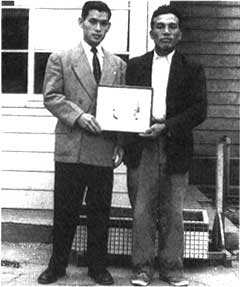
Mr. Yoshiro Sasaki and Mr. Kinkichi Shimatani, the first in Hokkaido to declare their belief in Bahá'u'lláh, 1957.

It took years of visits by various Bahá'ís before there were results. With encouragement from the Bahá'í teacher Mr. M. Labib, in December 1961 six Japanese of Ainu ancestry became Bahá'ís: Mr. Takeichi Moritake and his wife Sami, Mr. Heikichi Sumiyoshi and his wife Toki, Mr. Kazutomo Umegae and his wife Taeko. They were among the leaders of the community. One month later five more people became Bahá'ís, including one youth. The Faith was now firmly established among these interesting and loving people.
Mr. Umegae did as the Guardian predicted. He arose to teach his own people with the result that there are several villages of predominately Ainu population with large Bahá'í groups.
In talking of the early days, Mr. Umegae said that with the development of mass communication during the 1960s and 1970s, the intense prejudice that he once knew had all but died out. The colorful and interesting history and life style of the Ainu has been widely written up and shown on television. Reconstructed Ainu village houses, and demonstrations of Ainu dancing have become a tourist attraction.
Mr. Umegae was appointed as a member of the Auxiliary Board in January 1965 by the Hands of the Cause in Asia, and he functioned in that capacity for twenty-one years, longer that any other Auxiliary Board member in Japan.
To go back to 1957, in November of that year Mr. G.V. Tehrani settled in Sapporo. His going there was a direct result of the Guardian's instruction to take the Faith to Hokkaido.
Mr. Tehrani, a widower, was elderly and not in the best of health, but his great loving spirit affected those around him and with the help of the new Bahá'ís, Mr. Sasaki and Mr. Shimatani, he soon had a group interested in the Faith.
Mr. and Mrs. Assassi, pioneers to Hiroshima, purchased a house in Sapporo which they donated to the Faith. Mr. Tehrani

Hand of the Cause Miss Alexander with three of the first Ainu Bahá'ís, Mr. Umegae, his father Mr. Moritake and Mr. Sumiyoshi, December 1961.
January 1962 in Shiraoi. The middle row from the left, Mr. Umegae, Mr. Sumiyoshi, Mrs. Moritake, and Mr. Moritake who had become Bahá'ís just the month before. Miss Sandra Sims, standing holding the framed "Greatest Name" was a youth travel-teacher who stayed with the Moritake family for a few days. Mr. Muhammad Labib, standing at the right, was visiting Hokkaido. Mr. Kuriyama standing at the far left was the first Bahá'í of Shiraoi.
click here for larger image
In 1959, about a year and a half after Mr. Tehrani moved there, the first Local Spiritual Assembly of Sapporo was elected.
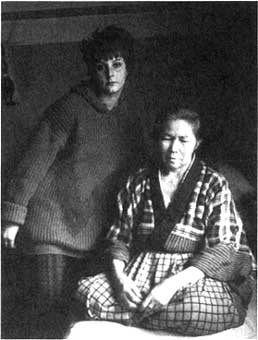
The First Youth to Travel-Teach for an Extended Period in Japan.Miss Sandra Sims (Fotos), as a child, pioneered to Japan with her parents who came during the first year of the Ten Year Crusade. As a teenager, she gave up one semester of her college education to spend three months travel-teaching in Hokkaido, 1962.
She was young, alone, and it was during the snowy winter so she attracted much attention. In those early days foreigners were rather rare, especially in the remote areas. She was written up in two newspapers and made an appearance on television. She went to thirteen cities and towns, and obtained introductions to visit city officials, schools, museums and libraries. She helped with the community in Sapporo and stayed with the new Bahá'ís in Shiraoi.
Miss Sims is shown here with Mrs. Haru Fujiyama, an Ainu woman who was originally from Sakhalin Island. The woman was in a hospital in Tokoro and had heard of Miss Sims and wanted to learn about her religion.
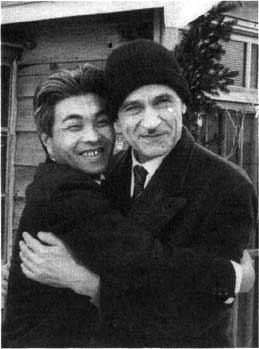
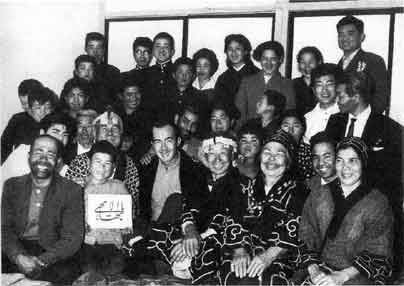
click here for larger image
Pioneer Jack Davis, sitting in front, during a meeting in the Ainu village of Nibutani, 1963. Mr. Umegae (in profile) is at the right. One of the women in front has the traditional tattoo around her mouth. Done when she was young it indicated that she was of marriagable age.

click here for larger image
Travel-Teaching in Hokkaido in 1963
Dr. Yasuyuki Hosoda, of Tokyo, (second from the right), with Mr. Umegae, (left), are teaching a family in Hokkaido. The man is looking at Dr. Hosoda's teaching album. Years later Dr. Hosoda was to become one of Japan's most eminent heart surgeons.
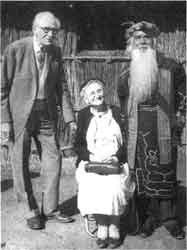
click here for larger image
Three extraordinary Bahá'ís. Mr. Leach, Miss Alexander and Chief Moritake.
190

Mr. Hideya Suzuki (left) watches as his brother Dr. Toshio Suzuki translates from English to Japanese for Hand of the Cause Miss Alexander. Dr. Suzuki went from his home in Nagasaki to help with this first conference in Hokkaido.

click here for larger image
Miss Alexander is sitting in the middle with Mr. Moritake and Mr. Umegae to the right of her. Mr. Leach is standing in the back row to the left. A total of about seventy people attended.
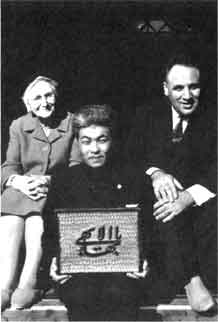
click here for larger image
Mr. Umegae is shown here with Hands of the Cause Miss Alexander and Dr. Muhajir shortly after his appointment to the Auxiliary Board in 1965. This photograph was taken at the Tokyo Bahá'í Center during a national assembly meeting the three attended. Mr. Umegae had worked very hard a few days before coming to Tokyo to finish carving the "Greatest Name" which he presented to the national spiritual assembly.Mr. Umegae's appointment fulfilled the Guardian's words about the Ainu arising to teach their own people. In the years following he travelled extensively throughout Japan, including Ogasawara Islands, teaching the Faith.

click here for larger image
A Wedding in Shiraoi
This was the wedding of Mr. and Mrs. Koichi Ishida in Shiraoi, Hokkaido,
1967.
This photograph was taken at the dedication of the Tomikawa Haziratu'l-Quds, 1969, in the town of Tomikawa which is along the remote southern coast of Hokkaido. About one hundred Bahá'ís attended the dedication, many coming from the main island of Honshu. It was the eighth Haziratu'l-Quds in Japan. Counsellor Mumtazi is sitting in the middle, to the left of the woman holding the frame containing the "Greatest Name."
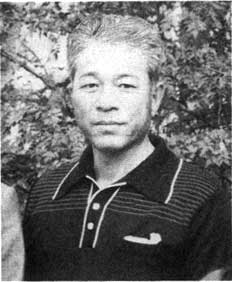
In 1974 the National Spiritual Assembly of Japan emerged from the National Spiritual Assembly of North East Asia. When the new national assembly was voted into existence, was it not fitting that a Japanese of Ainu ancestry be elected to it? Mr. Matsuo Chiba of Tomikawa, Hokkaido, served faithfully on that assembly for eight years until he was obliged to curtail his activities due to reasons of health.
This picture, taken in 1983 in Shiraoi, shows Mr. Umegae, now sixty, with granddaughters Emi, 7, and Maya, 3, during a demonstration of Ainu culture.
click here for larger image
Chapter 68

click here for larger image
This is an early children's class at the Tokyo Bahá'í Center, 1962. The teacher, Mrs. Muriel Snay (with glasses) and her helpers are in the rear.
Chapter 69
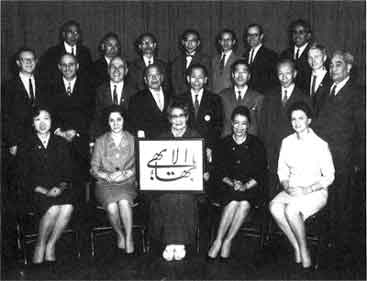
click here for larger image
Although this convention also had delegates from Hong Kong and Macau, those in the photograph are from Taiwan, Korea and Japan.First row: Miss Mayumi Taniguchi of Tokyo; Mrs. Rezvanieh Katirai of Nishinomiya; Mrs. Ayako Ogi; Mrs. Joy Earl and Mrs. Barbara Sims of Tokyo.
Middle row: Dr. David Earl, who, with his brilliant wife Joy, were among the very early American pioneers to Japan; Mr. Rouhollah Mumtazi, who six years later was to become the first counsellor in Japan; Mr. S.A. Suleimani, who, with his wife, were the first pioneers to Taiwan, 1954, Mr. Tadasu Miyazawa of Akashi, Mr. Masamichi Yamada and Mr. Kiyoshi Nonoda of Osaka; and Dr. Ikuo Mizuno, who served faithfully on the national spiritual assembly and was appointed to the Auxiliary Board in 1975. Next is John McHenry III, pioneer to Korea, who was the first counsellor appointed in Korea in 1969; and Mr. Hassan Naderi, early Persian pioneer to Japan who donated his house in Osaka to the national assembly in 1958 to be used as a Bahá'í Center. Back row: Mr. Mitsusaburo Kawata of Kobe; Mr. Kota Nakahama of Akashi; Mr. Yoshizo Fujisawa of Nagasaki; Mr. Masazo Odani of Kyoto, Mr. Hiroyasu Takano; Mr. William Smits of Korea and Mr. Abbas Katirai.
Mrs. Ogi and Mrs. Akiko Schreiber (mentioned elsewhere) were the first Japanese Bahá'ís to go to Korea. Mrs. Ogi visited in the mid-1960s. Mrs. Schreiber lived there with her husband Eugene in 1966/67.
Chapter 70

click here for larger image
Many Bahá'ís from North East Asia attended the Congress. Shown
here in Albert Hall, London, the site of the Congress, are Dr. Ikuo Mizuno; Mr. Kim Cha'ang-jin, early believer of Korea; Mr. Masazo Odani and Mr. Michitoshi Zenimoto. The three Japanese were members of the National Spiritual Assembly of North East Asia and just a few days earlier had participated in the first International Convention in the Holy Land.
Chapter 71
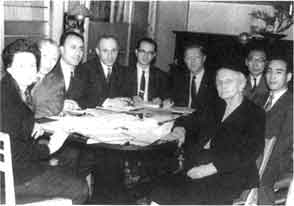
click here for larger image
The Sixth National Spiritual Assembly of the Bahá'ís of North East Asia, 1962/1963. It was the last assembly on which Hand of the Cause Miss Agnes Alexander served. The national convention in 1963 was held at the end of May instead of Ridvan, because of the International Convention in the Holy Land which took place during Ridvan. Miss Alexander was elected to the national spiritual assembly in 1963, but she immediately resigned, as the Hands of the Cause had decided in May 1963 to devote all their efforts to teaching and protection during that important period of the expansion of the Faith.From the right, counter clockwise: Hand of the Cause Miss Alexander, Mr. Michitoshi Zenimoto, Mr. Masazo Odani, Dr. David Earl, Mr. Hiroyasu Takano, Mr. Rouhollah Mumtazi, Mr. Ataullah Moghbel, Dr. Ikuo Mizuno and Mrs. Sims.
Chapter 72

click here for larger image
Miss Alexander was born July 21, 1875. On July 21, 1963, for her eighty-eighth birthday, the Local Spiritual Assembly of Tokyo had a party in her honor. There were refreshments, and speeches of appreciation, which she graciously answered. There was even music, played on the traditional Japanese instrument, the koto. It was a happy time.Seated. Mrs. Konno (a friend of one of the Bahá'ís); Mrs. Yasuko Mori Irwin, daughter of Miss Alexander's old friends Mr. and Mrs. Tsuto Mori; Mrs. Michiko Mizuno and Mrs. Bashir-Elahi. Mrs. Yuri Furukawa is sitting next to Miss Alexander (middle) and to the right is Mrs. Tadako Arakawa; Mrs. Suma Mori and Mrs. Ayako Ogi. Standing from the left are Mr. Philip Marangella, Mr. Masazo Odani; Mrs. Barbara Sims; Mr. Rouhollah Mumtazi; unidentified; Mr. Bashir-Elahi; Mrs. Michiko Takano; Mr. Irwin; Mr. Hiroyasu Takano; Mr. Shibukawa the koto player; Mr. Hideyasu Takashima; Dr. Yasuyuki Hosoda; Mr. Masaaki Ushibata; Miss Fumiko Hirayama; Mrs. Akiko Schreiber; Miss Reiko Masuto, Mrs. Chiyo Suzuki; Mr. Hiroshi Yamazaki; Mrs. Mitsuko Yamazaki; Miss Masako Inoue; Miss Yoko Ishihara and Dr. Mizuno.
Within a few days of the party in Tokyo, the Bahá'ís in Kansai celebrated Miss Alexander's eighty-eighth birthday at the Osaka Center. At least two people aside from Miss Alexander attended both parties. In Japanese 88 isand it makes an ideograph
which is the character for rice. Rice is the staple food and has all good connotations. Therefore when an individual reaches 88 it is time for a special celebration.
At the Osaka party, the first piece of birthday cake goes to Miss Alexander. Mr. Zenimoto is assisting her.
Chapter 73
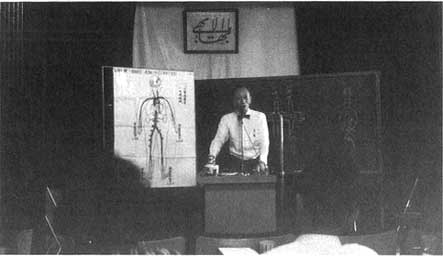
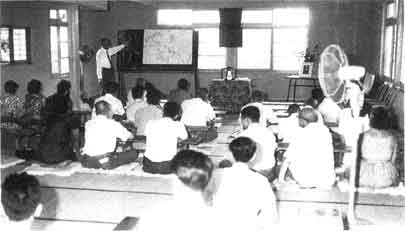
click here for larger image
Dr. Ikuo Mizuno, who lived in Yokohama, liked to use charts to accompany his talks. As he was a surgeon, he thought it fitting to explain Bahá'í administration in terms of the body (top photograph). This was
during a summer school in 1961.In the bottom photograph at another summer school at Takarazuka in 1963 he is explaining Bahá'u'lláh's journey from Iran to the Holy Land.
As Dr. Mizuno had a traditional education and knew the more classical style of Japanese, he undertook to translate the "Kitab-i-Iqan" into Japanese. It took him two years, working on it every night after coming home from his professional duties at the hospital. At that time he was living alone as his wife had died. After he retired, he went to Kyoto to live with his son, who was also a doctor.
Dr. Mizuno was a member of the national spiritual assembly for many years and was appointed as Auxiliary Board Member for Protection in 1976. He served in that capacity until his death at age ninety-one, in 1986.
Chapter 74
203
This was the engagement party, in 1963, of Miss Chiyo Sato and Dr. Toshio Suzuki, two active Bahá'ís in the Tokyo area. The happy couple are standing in the middle. The photograph was taken at the home of one of the Tokyo Bahá'ís. Dr. Suzuki was a fairly new Bahá'í at that time, but he was to become the secretary of the National Spiritual Assembly of the Bahá'ís of Japan several years later.
In 1964 Dr. and Mrs. Suzuki were living in the Bahá'í Center in Nagasaki where he was fulfilling his medical resident requirements at a nearby hospital. Mrs. Suzuki, standing at the left, conducted a Bahá'í class to which the neighborhood children were invited.
click here for larger image
A Naw-Rúz party at the Tokyo Bahá'í Center in 1964. Miss Alexander is sitting under the framed "Greatest Name" and Dr. Muhajir is to the right. To the right of Dr. Muhajir is Mrs. Furukawa.
The Eighth Summer School, held at Atami in 1964. Miss Alexander and Dr. Mizuno are holding the framed "Greatest Name." It was the last summer school Miss Alexander attended.
click here for larger image

click here for larger image
A happy occasion at the Tokyo Bahá'í Center, 1968, was the marriage of Miss Ruth Walbridge and Mr. Hideya Suzuki. Soon after, they went home-front pioneering to Hokkaido and have lived there since.Mr. Suzuki was to become the first Japanese appointed to the Continental Board of Counsellors.
The Local Spiritual Assembly of Kyoto had extension teaching goals and one was Fukuchiyama. This photograph was taken there during a
click here for larger image
Kyoto-sponsored public meeting, assisted by Persian pioneers, June 6, 1966. Mr. Tokujiro Torii was the speaker that day. Eighteen people in all attended the meeting including some visually handicapped. The following Bahá'ís participated: Seated: Mr. Chikara Toyoda, Mr. Gunji Fukuyama, Mr. Torii, Mrs. Koyuki Akai and Miss Fumiko Akai. Standing: Mr. Seiichiro Tsunemi, Mr. Shingo Akai, Miss Akiko Kajiwara, Mr. Saburo Deguchi, Mr. Parvis Victory, Mrs. Pouran Mumtazi, Mrs. Victory, Mrs. Rezvanieh Katirai, Mr. Toshikazu Taniguchi and Mr. Masaaki Ushibata.Fukuchiyama residents were the Akai family (mother, brother and sister), Mr. Fukuyama, Mr. Toyoda, Miss Kajiwara and Mr. Deguchi.
This was the first Youth Conference in Japan, May 1969, at Jogashima, an off-shore island, near Tokyo. Seated in the front row: Miss Kazuko Hayashi, Miss Elahe Vahdat, Auxiliary Board member Mr. Charles Duncan, Counsellor Mumtazi, Mrs. Sims and Dr. Suzuki representing the national spiritual assembly, and two young women friends of the Bahá'ís. In the middle row: Mr. Nobuyoshi Enomoto, Mrs. Judy Fox, Mr. Sheridan Sims, Miss Hiroko Nakajima, Miss Laily Mumtazi, Miss Noriko Yamamoto, Miss Fusako Watanabe, unidentified, Mr. Kuninori Kobayashi and Miss Vedad Mumtazi. In the back row: Mr. Farzad Katirai, the next two young men are unidentified, Mr. Foad Katirai, Mr. Zafar Moghbel, Mr. Mehraban Jam, Mr. Kenji Sato and Mr. David Higuera.
click here for larger image
Chapter 75
A day or so before the opening of the meeting, she fell in her room at International House and broke a bone in her hip. She was taken to the Jikei Idai Hospital for treatment. As it happened she stayed there for a little over two years.
The Bahá'ís were grateful that during that trying time Miss Alexander suffered no pain, although she could not walk.
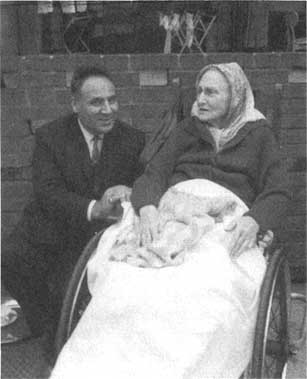
Hand of the Cause Dr. Muhajir and Miss Alexander, 1965, at the Jikei Idai Hospital where she was confined the last two years she was in Japan. Dr. Muhajir requested that this picture be taken. He had loved and admired Miss Alexander since, as a young man, he had read her name in 'Abdu'l-Bahá's "Tablets of the Divine Plan."
During the next two years Miss Alexander increasingly longed to return to Hawaii, and also her relatives wanted her to return where they could better watch her condition. In September 1967 she left Japan in a wheel chair, accompanied by Miss Walbridge.
In Honolulu, Hawaii, she lived her remaining years in an apartment, attended by a full-time nurse. She had numerous visitors through the years and seemed to be quite happy. On January 1,1971, Miss Alexander, Daughter of the Kingdom, quietly passed away. She was buried in the family plot in the Kawaiahao Cemetery in Honolulu.

click here for larger image
October 1965. Eight members of the National Spiritual Assembly of North East Asia visit Miss Alexander after a meeting. She always welcomed such visits as she liked to hear the latest news of the progress of the Faith.

Miss Alexander appreciates her cake on the occasion of her ninety-first birthday. Miss Walbridge is holding the cake.
Miss Alexander left Jikei Idai Hospital in early September 1967 to go to Kyoto to close up her apartment, as she was leaving Japan permanently shortly after. Of course, the friends offered to pack everything for her but she insisted on overseeing it herself. She still could not walk so she was accompanied by her practical nurse and Miss Walbridge. During the few days she spent at her apartment in Kyoto she had many visitors. The above photograph was taken September 6 in her apartment during a visit by several Bahá'ís of that area.
click here for larger image
In the front. unidentified, Mr. Tadashi Terashima, Mr. Tokujiro Torii, Mr. Masazo Odani and Miss Fumiko Akai. Standing: Mr. Toshikazu Taniguchi, Miss Walbridge, Mr. Masaaki Ushibata, Mrs. Torii, Miss Alexander's practical nurse Ms. Takahashi and Mr. Shingo Akai.
Chapter 76
Mr. Bunshiro Kajimoto and his funeral. He was the first Japanese to be buried in accordance with Bahá'í law in Japan.Mr. Anthony Seto, a Chinese-American Bahá'í had been buried according to Bahá'í law some years earlier in Yokohama.
This was accomplished in 1958 when a large plot of land six hundred twenty-three square meters was obtained within the Ashiya Cemetery.
As it was within the already existing Ashiya Cemetery, it could not be purchased outright. A permanent lease (or "right to use") was purchased and donated to the National Spiritual Assembly of North East Asia by Mr. Abbas Katirai.
The first person to be buried there was Mr. Bunshiro Kajimoto, in 1964. He had become a Bahá'í in November 1961. When he became terminally ill, he and his wife discussed the future and they both decided they wanted to be buried in the Ashiya burial ground in accordance with Bahá'í law. Mr. Kajimoto wrote this in his will.
It was certainly a radical departure from traditional Buddhist burial in which the body is cremated and the ashes put into
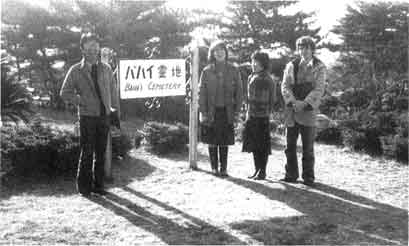
click here for larger image
This photo was taken during a visit to the Bahá'í Cemetery in Ashiiya, in February 1979. It shows Mr. David Mockon, Mrs. Sue Sloan, Miss Iwakura and Mr. James Manners. All were members of a one-year full-time travel-teaching team which was organized in Japan to actively pursue certain teaching and consolidation goals of the Five Year Plan (1974-1979.)
an urn which is usually buried.
It was not easy to go against a centuries-old practice in such a conservative country. It attests to Mr. Kajimoto's faith and conviction that he was the first of his Bahá'í countrymen to do so.
The second person to be buried in the Bahá'í Cemetery was Mrs. Sakineh Kazempour, in 1968. She was the mother of Mr. Abbas Kazempour and his sister Mrs. Moluke Kazempour. The elderly Mrs. Kazempour had come to Japan eight years earlier to be with her family who were pioneering.
Chapter 77
In 1967 several Bahá'ís from Japan attended the Intercontinental Conference of Asia in New Delhi, India. Dr. Toshio Suzuki representing Japan, along with a group of other Bahá'ís, was invited to meet the deputy Prime Minister of India, Mr. Morarji Desai. Dr. Suzuki wore the traditional Japanese "hakama" for the occasion. At the left showing his back is Hand of the Cause Mr. Ala'i. Hand of the Cause Mr. Varga is in the rear.
Mr. Ushibata had saved his money in order to attend the Palermo Conference in 1968, but he decided to go to Australia instead. He stayed there for several months.
At the time, teaching in New Guinea (now called Papua New Guinea) was a goal of Australia so on his way back to Japan he went travel-teaching there for two months.
In parts of New Guinea there were bitter memories of World War II, and of the Japanese. Accompanied by Australian pioneers, he travelled up into the highlands and was warmly greeted by Bahá'ís wherever he went. Most of them had never seen a Japanese before. It was a good demonstration of the oneness of mankind. Mr. Ushibata could speak to the Bahá'ís in English and some pidgin. It was the first extended travel-teaching trip out of Japan made by a Japanese Bahá'í.
Mr. Ushibata went on to become the first Japanese to fulfill a pioneer goal for Japan abroad, in 1975, to the Eastern Caroline

click here for larger image
Mr. Ushibata (with dark glasses) was warmly received by the Bahá'ís of Kue village in New Guinea, in 1968.

click here for larger image
Present at the First Intercontinental Conference in Sydney, Australia in 1958 were three Bahá'ís from Japan, Miss Agnes Alexander, Mrs. Tahereh Kazempour and Mr. Michitoshi Zenimoto. It was the first visit to Australia of a Japanese Bahá'í . Mr. Zenimoto recalls that the Bahá'ís in Australia arranged for him to speak on the Faith to hundreds of Japanese war brides in different localities.Shown here is a newspaper clipping of some of the attendants to the conference. From the left, Mr. Latu Tu 'Akihekolo from Tonga, Mr. Zenimoto, Hands of the Cause Mrs. Clara Dunn and Mr. Collis Featherstone.
Chapter 78
Until he died in 1979, Bernard Leach for over forty years was recognized as the greatest living Western potter. When asked who he thought was the greatest potter of all he answered "Shoji Hamada." But Hamada considered that Leach was. Both were leaders of the folk-craft movement in Japan.
The very name, Bernard Leach, assured a large and attentive audience, and he always devoted as much effort for the propagation of the Bahá'í Faith in Japan as his time would allow. He lived in England, St. Ives, Cornwall, where he had his pottery but he often visited Japan. In the later years when he was almost blind he still came to Japan to oversee exhibitions of his work.
For all his fame and prestige, he remained a humble man, speaking from the heart about the things he loved, the Bahá'í Faith, and art.
In the early days before he became a Bahá'í he was attracted to Buddhism, and was a close friend of the Zen master, Daisetz Suzuki, whose American wife was a Bahá'í.
Leach had first heard of the Faith in Japan from Miss Alexander
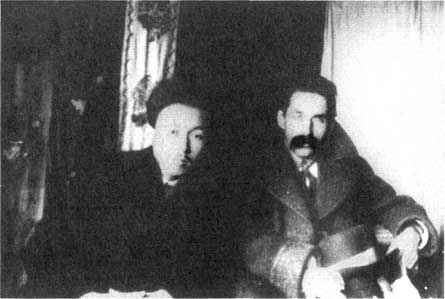
Dr. Yanagi and Mr. Leach in the 1920s.
216
Leach was the author of some renowned books, "A Potter in Japan," "Beyond East and West," "Drawings, Verse and Beliefs" and others. In many of his books, the Bahá'í Faith and its meaning to him was given prominence.
In 1953 when the Faith was still rather obscure, especially in Japan, Leach felt the urge to explain his deep religious conviction to his friends, and others who knew of him. He wrote a pamphlet, "My Religious Faith," which was printed in both English and Japanese on beautiful textured paper, in the folk-craft style. The binding of the pamphlet was attractively

click here for larger image
Mr. Shoji Hamada, world-famous potter (left); Dr. Soetsu Yanagi (standing) who led the Mingei (Folkcraft) movement in Japan, Mr. Kanjiro Kawai, another prominent Japanese potter (kneeling) and Mr. Leach (right), who was sketching a cat-fish in a wooden pail. This photograph was taken in 1934.Dr. Yanagi was also a friend of Miss Agnes Alexander during the very early days. At that time he was striving to bring unity through art between Japan and Korea. He gave her an introduction to a newspaper editor in Korea when she went there for the first time in 1921.

click here for larger image

click here for larger image
The famous British potter, Mr. Bernard Leach lecturing at a Bahá'í public meeting in Tokyo in the early 1960s. Dr. Hosoda, Dr. Mizuno and Dr. Earl are sitting on the stage.
Chapter 79
After the Guardian's passing there could be no more Hands of the Cause because, according to 'Abdu'l-Bahá's Will and Testament they could only be appointed by the Guardian. However, the Auxiliary Boards which were appointed by, and assisted the Hands of the Cause would continue to develop.
In 1968, the Universal House of Justice created a new institution, the Continental Boards of Counsellors, which would gradually take over some of the functions of the Hands of the Cause to leave the latter more free. The Auxiliary Board members were from that time on to report to the Boards of Counsellors

click here for larger image
In October 1969 the Continental Board of Counsellors for the area held their first conference in Tokyo with Hand of the Cause Mr. Furutan attending. He is sitting in the middle with Mr. Samaniego to the left and Mr. McHenry and Mr. Mumtazi to the right.
Mr. Rouhollah Mumtazi, who had lived in Japan since 1954, was appointed in 1968 in the first contingent of counsellors. At that time the two counsellors responsible for the North East Asia area were Mr. Mumtazi and Mr. Vicente Samaniego of the Philippines.
As the Faith has grown and the needs have changed, the areas of jurisdiction of the Continental Boards of Counsellors have also been changed and the number of counsellors increased.
The counsellors in Japan, Mr. Mumtazi and Mr. Hideya Suzuki who was the first Japanese counsellor, appointed from 1976 to 1985, had both been members of the Auxiliary Board in Japan and before that, members of the National Spiritual Assembly of the Bahá'ís of North East Asia.
Mr. Michitoshi Zenimoto, the second Japanese counsellor, was appointed in 1985 by the Universal House of Justice. He had also been one of the earliest Auxiliary Board Members and a member of the national spiritual assembly.
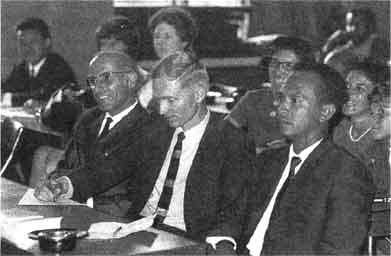
click here for larger image
The three members of the Continental Board of Counsellors in the area at that time (1969) are shown attending the first conference in Japan conducted by that institution. From the left, Mr. Rouhollah Mumtazi of Japan, Mr. John McHenry III of Korea and Mr. Vicente Samaniego of the Philippines.
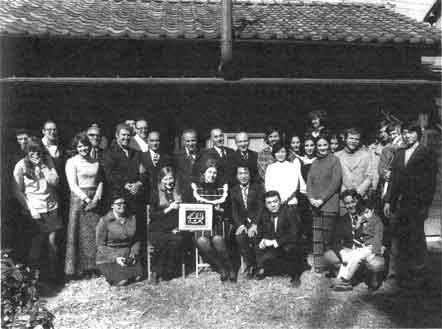
click here for larger image
February 1973 at the Tokyo Bahá'í Center. The Continental Board of Counsellors sponsored a two-day symposium for pioneers and they requested Mr. Jack McCants, who was then a pioneer to Guam, to attend and act as chairman. About thirty people came. They talked about the role of the pioneer, the bounty and the responsibilities of being a pioneer and some of the problems of pioneering in a different culture. Dr. Muhajir was able to attend for one day. He can be seen standing behind the frame containing the "Greatest Name." Counsellor Mumtazi is standing second to the right of Dr. Muhajir. Mr. McCants is standing third from the left, front row.

click here for larger image
This photo taken in Tokyo, 1977, shows the National Spiritual Assembly of Japan with the Continental Board of Counsellors under whose jurisdiction Japan was at the time.The four counsellors are Miss Elena Marsella from Hawaii (sitting second from the right), Mr. Hideya Suzuki (standing third from the right) and Judge Richard Benson from Guam, (standing far right), and Mr. Rouhollah Mumtazi (standing fourth from the right).
National spiritual assembly members are. (standing) Dr. Toshio Suzuki, Mr. Yuzo Yamaguchi, Mr. Abbas Katirai, Mr. Ataullah Moghbel and Mr. Matsuo Chiba standing between Mr. Suzuki and Judge Benson. Seated are Mrs. Barbara Sims, Miss Tomo Fushimi, Miss Nobuko Iwakura and Mr. Shigeyuki Hayashi.
Chapter 80
For several years after World War II, the Ryukyu Islands was under United States occupation. In 1972 the islands reverted to Japan. There were American Bahá'ís attached to the U.S. forces stationed on the islands from time to time before and after reversion. Their activities were, of necessity, largely with other Americans.
In the Nine Year Plan, 1964, opening the Ryukyu Islands was a goal given to the National Spiritual Assembly of North East Asia by the Universal House of Justice.
Dr. Toshio Suzuki and his wife were living in the Nagasaki Hazira at the time. Upon hearing of this goal, Dr. Suzuki made a week-long trip by himself to Okinawa for the purpose of teaching the Faith.
He went by boat from Kagoshima to Naha and then by bus and on foot to the villages in the north. In those days, Okinawa was a poor area but Dr. Suzuki found the people warm and friendly. He said he showed his teaching album and talked to

click here for larger image
April 1971. A party at a Chinese restaurant on the occasion of Mrs. Lee becoming a Bahá'í. She is sitting at the left. Next to her is Miss Hayashi and a friend, Mrs. Suzuki. Standing are Mrs. Lawrence and Mrs. Setsuko Barcus.
In 1967 Mrs. Caroline Lawrence settled in Naha, Okinawa; the first pioneer to the Ryukyu Islands. She could not stay there without work but luckily she was hired almost immediately by Mr. Isei Kohazame to teach at his English school. As Mrs. Lawrence worked on the local economy, she could make friends among the residents. She provided continuity. Most of the early Okinawan Bahá'ís were contacts of hers.
Mr. Kohazame had been to the United States in about 1952 and had seen the House of Worship in Wilmette, Illinois. Mrs. Lawrence recalled that although he didn't become a Bahá'í until several years later (1978), he was a great help in the work of spreading the Faith. She wrote, "He not only gave me a job, he also met all visiting Bahá'ís. He arranged meetings, parties and made arrangements for Hand of the Cause Mr. Featherstone to meet with the governor of Okinawa and the mayor of Naha." Mr. Kohazame's school facilities were used for the election of the first Local Spiritual Assembly of Naha in 1971.
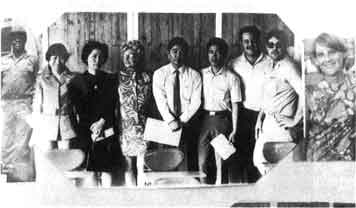
click here for larger image
The first Local Spiritual Assembly of the Bahá'ís of Naha, Okinawa, Japan, 1971. Left to right. Mr. Robert Ephriam, Mrs. Grace Lee, Mrs. Kazuko Natomi, Mrs. Caroline Lawrence, Mr. Akio Natomi, Mr. Hiroshi Yonamine, Mr. William Myers, Mr. William Clements and Mrs. Lynda Myers.
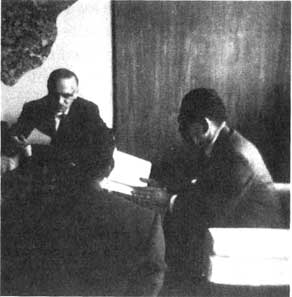
Hand of the Cause Mr. Featherstone giving Bahá'í literature to the mayor of Naha, 1972.
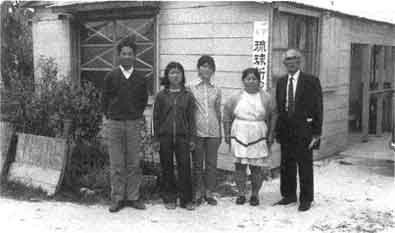
click here for larger image
In 1972 Mr. Koreo Yuasa (right) of Hiroshima went to Okinawa with Mr. Vahdat for teaching and deepening. Mr. and Mrs. Seikou Tamashiro, shown here with their daughters, had become the first Bahá'ís of Nishihara, Okinawa, the previous year. The first Local Spiritual Assembly of Nishihara was formed that year, 1972.
Several pioneers in Japan visited the Okinawa Bahá'í community in the 1970s to help with the work. Among them were Mr. Rouhollah Mumtazi in his capacity as counsellor, Counsellor Vicente Samaniego from the Philippines, Mr. Heshmat Vahdat, Mrs. Barbara Sims, Mr. Philip Marangella, Miss Toni Mantel, Mr. Jim Jamison and Mr. Charles Duncan, who later decided to move to Okinawa permanently.
In the 1970s Japanese also arose to teach in Okinawa; Mr. Masaaki Ushibata, he had been among the first Japanese to travel
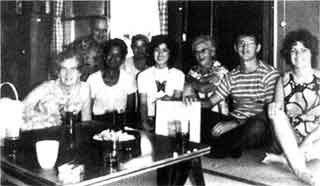
click here for larger image
Hand of the Cause Mr. Collis Featherstone and his wife Madge, both on the left side, visit the friends in Naha, Okinawa, 1974. It was Mrs. Featherstone's first visit, but Mr. Featherstone's second.
In 1970 when Universal House of Justice member Mr. Hugh Chance heard of the work being done in Okinawa, he was moved to write an encouraging letter to the group. He reminisced that exactly twenty-five years before, he, as a young naval officer, not yet a Bahá'í, was on a ship anchored at Naha harbor riding out a typhoon. His ship also visited Yokohama.
Mr. Collis Featherstone was the only Hand of the Cause to visit Okinawa. In May 1972 he presented the book, "The Proclamation of Bahá'u'lláh" to the mayor of Naha and he also met the governor of Okinawa. Mr. Featherstone came again in 1974 and 1988 with his wife Madge.
Chapter 81
At Ridvan 1969 the Universal House of Justice announced a series of eight Oceanic and Continental Conferences to be held between August 1970 and September 1971. One was designated for Japan. It was held in Sapporo, and took place less than fifteen years after the National Spiritual Assembly of North East Asia initiated active teaching on the large island of Hokkaido, resulting in it being opened to the Faith with resident Bahá'ís.
Hundreds of Bahá'ís flew to the northern island. Attendance at the conference totaled six hundred and twenty-five, a vast difference from the summer of 1932 when Miss Alexander went alone by boat and train to speak of the Faith at Esperanto meetings. She wrote that it was a privilege that God had granted her, to plant seeds of the Divine Cause in that remote area.
In their message to the conference, the Universal House of Justice paid tribute to Miss Alexander. She, the first Bahá'í in the Pacific, had passed away on January 1 of that same year in the land of her birth, Hawaii.
The Universal House of Justice message also called attention to the "teeming millions" in nearby lands who had not as yet heard of the Most Great Dispensation, reminiscent of a similar phrase used by the Guardian in 1952 at the time of the launching of the Ten Year Spiritual Crusade. But now the Faith was
North Pacific Oceanic Conference, Sapporo, Japan, 1971.
The Sapporo Conference offered an unprecedented opportunity for proclamation. A special poster was printed and thousands were distributed all over the city; write-ups and interviews were put in newspapers; three radio programs on the Faith were beamed afar; two television programs were broadcast, one with Bahá'ís in native costume.
There was a public meeting with Mr. Furutan sharing the program with Dr. Kuniyoshi Obara and Dr. Harusada Suginome. The three men, all educators, spoke to a large audience in the attractive hall. There were about one hundred and thirty declarations of Faith during the conference.
The House of Justice wrote in their message ". . . The sweet perfume of victory is in the air..."
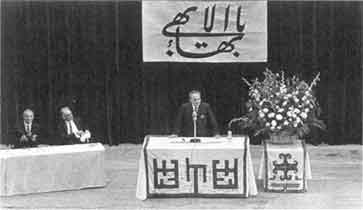
click here for larger image
The three Hands of the Cause attending the conference in Sapporo. Left, Mr. Featherstone, Mr. Furutan who was assigned to represent the Universal House of Justice at the conference and Dr. Muhajir who is speaking. The interesting rostrum covers were made by the Bahá'ís of Ainu heritage using traditional Ainu designs.
Chapter 82
In 1912 when 'Abdu'l-Bahá was in San Francisco, He was heard to say, "I wish I could go to Hawaii and Japan to see how much capacity the inhabitants of these islands possess for the Cause of God."
He was not able to go to Japan but He encouraged several Bahá'ís to do so to spread the Teachings of Bahá'u'lláh.
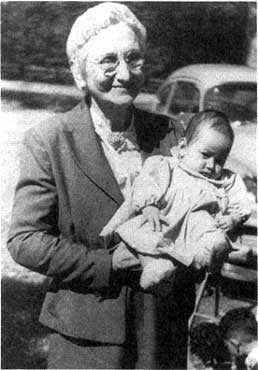
230
Dr. George Augur, who went to Japan at 'Abdu'l-Bahá's bidding in 1914 was designated by the Guardian as one of the Disciples of 'Abdu'l-Bahá. The deep spirituality of Dr. Augur influenced those who came into contact with him. He loved Japan and fit into its culture.

click here for larger image
Miss Alexander with Mr. and Mrs. Seiichiro Tsunemi and their children. Mrs. Tsunemi is Mrs. Torii's sister. Miss Alexander lived with this family for two years in the late 1950s, and was extremely fond of them. Mr. and Mrs. Tsunemi, along with Miss Alexander, were members of the first Local Spiritual Assembly of the Bahá'ís of Kyoto.
'Abdu'l-Bahá in His Will and Testament elucidated the obligations of the Hands of the Cause, however, He did not appoint Hands of the Cause in His Lifetime. The Guardian conferred posthumously the title of Hand of the Cause on some Bahá'ís, and after 1951 he appointed others. This institution, which had been created by Bahá'u'lláh, was expanded by Shoghi Effendi.
Of the seventeen Hands of the Cause (aside from Remey) who visited Japan through the years, two were appointed posthumously by Shoghi Effendi. One was Miss Martha Root, who made four visits. After her death in 1939, Miss Root's station became known. The Guardian, Shoghi Effendi, cabled "Posterity will establish her as foremost Hand which 'Abdu'l-Bahá's will has raised up first Bahá'í century."
Mrs. Keith Ransom-Kehler's high station was made known to the Bahá'í world after her passing in Persia in 1933, two years

Miss Alexander and Sheridan Sims sitting at the back entrance to the old Tokyo Bahá'í Center, 1960.
Miss Agnes Alexander, who spent so many years of her life among the Japanese, was appointed Hand of the Cause in March 1957, just one month before the election of the new regional spiritual assembly, the National Spiritual Assembly of North East Asia. Miss Alexander was elected to this new administrative body and served on it until 1963, when the Hands of the Cause decided to devote all their efforts to their work of propagation and protection and refrain from administrative work.
Miss Alexander was the first Bahá'í in the Pacific area, one of the first to come to Japan, and the first to take the Message of Bahá'u'lláh to Korea. The Guardian called her an "exemplary pioneer."
In 1949, while she was still in the United States, where she had spent the years during World War II, she wrote to a friend, "In all I spent fourteen years there (in Japan) four different times, but not of my own volition, for the Master sent me the first two
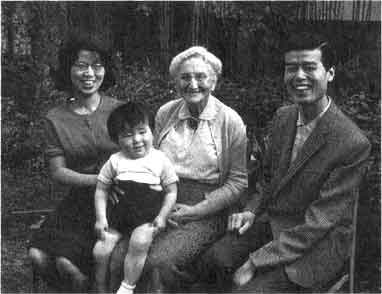
click here for larger image
Miss Alexander with the Hiroshi Yamazaki family at the Tokyo Bahá'í Center, 1965.
In 1949, the Guardian again urged her to return to Japan. She came the next
year, 1950, and left in 1967 in a wheel chair, to spend her remaining years in
her beloved Hawaii, the place of her birth.
|
Arrival in Japan: November 1, 1914 August 9, 1919 January 19, 1928 May 19, 1935 May 1950 |
Departure
from Japan: July 27, 1917 to Honolulu, Hawaii October 12, 1923 to Korea, China, and Honolulu May 30, 1933 to Honolulu, Hawaii March 20, 1937 to Haifa, Europe and the U.S. September 1, 1967 to Honolulu, Hawaii |
It should be said that during her last stay of 17 years, Miss Alexander made many trips of relatively short duration out of Japan, to the United States, to Hawaii, the Holy Land, and countries in Asia, but her base was in Japan, in Kyoto.
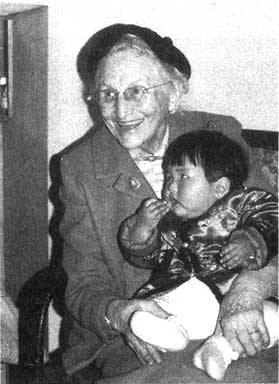
He wrote an account of his extended trip and in the section about Japan (Star of the West, Vol. 19) included three pictures shown here with the original captions.
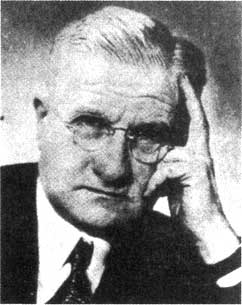
Hand of the Cause Siegfried Schopflocher

click here for larger image
The Bahá'í teacher is Mrs. Kanae Takeshita who was described by Miss Alexander as "a lovely Japanese lady who heard of the Cause from Mrs. Finch." Her students are wearing the Esperanto star.

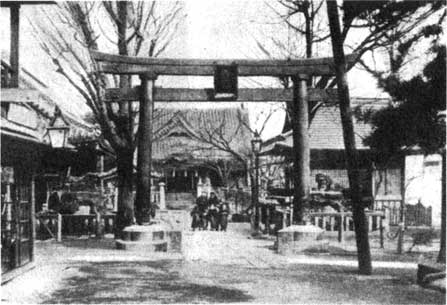
A street scene in Tokyo
236
Mr. Khadem stayed about ten days and met with the Tokyo Local Spiritual Assembly, which had assumed the functions of directing the affairs of the Faith in Japan. The strongest recommendation Mr. Khadem made was to increase the literature of the Faith in Japanese. Immediate efforts were expended and from then on available literature slowly began to increase.
During those ten days, Mr. Khadem tried to meet every Bahá'í in Japan personally. At that time there were about forty-two or forty-three.
The Guardian approved Mr. Khadem's attendance at the Asian Regional Teaching Conference in Nikko, Japan in 1955. He came with his wife this time, and they greatly inspired all Bahá'ís at the conference.
On October 9, after the Nikko conference, Mr. Khadem, accompanied by Miss Alexander and Mr. Noureddin Mumtazi,
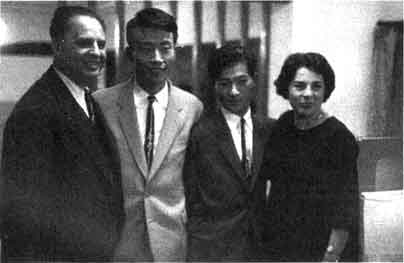
click here for larger image
Mr. and Mrs. Khadem with Mr. Honkawa and Mr. Shoji, the first two to become Bahá'ís in Hiroshima.
The group met several young men at the Hiroshima YMCA where Mr. Khadem spoke. One of the young men, Mr. Michitaka Honkawa, took a pamphlet, read it overnight, and came to the group the next morning saying he wanted become a Bahá'í. Shortly after, one of his friends, Mr. Shoji, also declared himself to be a believer in Bahá'u'lláh.
Mr. Khadem cabled the Guardian the good news of the first believers in Hiroshima. The Guardian cabled back that he was "delighted" and to assure Honkawa and Shoji of his loving prayers. Only three years before, the Guardian had written to the Spiritual Assembly of Tokyo (through his secretary), that "...He was particularly glad to hear teaching will be done in Hiroshima, where the people suffered so mercilessly during the war; they have a special right — the people of that city — to hear of Bahá'u'lláh's Message of peace and brotherhood."
Mr. Khadem returned to Hiroshima a few days after his first visit, this time accompanied by his wife and twenty-three Bahá'ís, mostly Persian pioneers.
About this time Mr. Masazo Odani saw a notice in a Kyoto newspaper of a talk by Mr. Khadem. He attended the lecture and became attracted. He studied the Faith for several months, became a Bahá'í and served faithfully for many years on the Kyoto Local Spiritual Assembly and also on the National Spiritual Assembly of North East Asia.
Teaching continued regularly in Hiroshima, and in 1957, Mr. and Mrs. Assassi and Mr. M. Labib settled there as pioneers. Mr. Labib was soon to move on to open the island of Kyushu to the Faith.
Hand of the Cause Mr. Jalal Khazeh visited Japan twice. The first time was in 1957, when he was the Guardian's representative at the first National Convention of the Bahá'ís of North East Asia. He met with the new national assembly shortly after it was elected, advising and helping it get organized.
The Guardian had given him some small flacons of attar of roses to anoint the friends attending the convention. After using some of the attar of roses, Mr. Khazeh gave the flacons to Bahá'ís in Japan. The compiler still has the one he gave her.
Mr. Khazeh visited Hiroshima in 1957. Miss Noriko Matsuura (Fujii) was a student at Hiroshima University, when she attended Mr. Khazeh's lecture. Now, over thirty years later she can still recall the strong impression it made on her. Soon after, she became a Bahá'í and her life changed.
Mr. Khazeh's second visit in 1973 was memorable. He met with the national spiritual assembly to obtain information and give suggestions. He was concerned about deepening in the concept of God and His Manifestations in a country where Buddhist belief prevails. He had practical suggestions as to how to handle the problems of deepening.
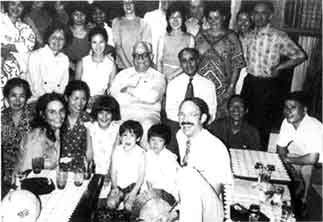
click here for larger image
A meeting with Mr. Khazeh in Ashiya, 1973. At this meeting the Hand of the Cause told the friends moving stories of the transitional period between the passing of the Guardian, 1957, and the election of the Universal House of Justice, 1963, when the affairs of the Faith were managed by the Hands of the Cause.

click here for larger image
Mr. Khazeh visited a Kobe Bahá'í, Miss Yoshiko Kimura (right) who was hospitalized after an operation on her ear. She was thrilled to have a Hand of the Cause visit her hospital room. To the left is a Bahá'í from the Philippines, Ms. Nimfa Dimapilis Connolly.
Mr. Shu'a'u'llah Ala'i was appointed Hand of the Cause in 1952. He visited Japan once, in December 1959. He met with the national spiritual assembly and visited several communities. It is recorded that there was a meeting of thirty in Osaka. He spoke of the fundamental Teachings of Bahá'u'lláh, which would bring about peace.
The Local Spiritual Assembly of Akashi welcomed him at a gathering which thirty people attended.
There was a meeting at the International Hotel in Kobe with over seventy people in attendance. A Kobe newspaper reporter interviewed him.
Mr. Ala'i also spoke at meetings in Hiroshima, Takasago and Ashiya, where the mayor of the city visited him. There were also two meetings in Tokyo. Before his departure for Iran, he met the Persian Bahá'ís stressing the need for unity and teaching.

click here for larger image
Mr. Ala'i (center) meets with the Persian friends in Kansai. At the time there were about twenty-seven adult Persian Bahá'ís in Japan.
Of the many who visited Japan, perhaps the person who had the greatest impact on the development and expansion of the Faith in Japan, aside from dear Miss Alexander, was Hand of the Cause Dr. Ramat'u'llah Muhajir.
Dr. Muhajir was in the final contingent of Hands of the Cause appointed by the Guardian in 1957. He had a great love for Miss Alexander, whom he first met at the Singapore Conference in 1958. His first visit to Japan was in 1961 and he came nineteen or twenty times in all.
Whenever he came, he met with the national spiritual assembly, with one or two exceptions, and he often had a completely different theme from the time before — highly imaginative, but very practical, carefully worked out in his agile, far-seeing, brilliant mind. With him, everything was teaching or some aspect of it, such as proclamation. Our successful and colorful "Expo `70" pamphlet was designed by Dr. Muhajir, but he referred to it as ours, never taking any credit. The pamphlet was also produced in Korean and Chinese.
Through the years, mass conversion was started by Dr. Muhajir personally or under his direction in several countries, resulting in ever-increasing numbers of Bahá'ís.
His sudden and untimely passing in December 1979 left us bewildered. Our dear friend, who had helped guide our footsteps along His Path, was gone.
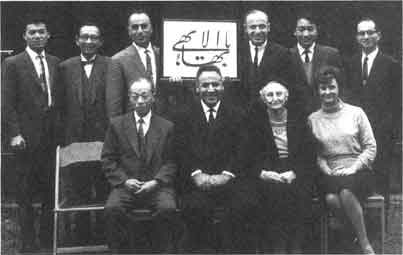
click here for larger image
During his visit in 1964, Dr. Muhajir and Miss Alexander met with the National Spiritual Assembly of the Bahá'ís of North East Asia.Seated are Dr. Mizuno, Dr. Muhajir, Miss Alexander and Mrs. Sims. Standing are Dr. Suzuki (who was not yet a member of the national assembly), Mr. Odani, Mr. Moghbel, Mr. Mumtazi, Dr. Hosoda and Mr. Takano.
National assembly members missing are Dr. Earl, and Mr. Schreiber, who took the photograph.
The first visit of Dr. Muhajir to Japan at the Tokyo Bahá'í Center, March 1961.

244
Dr. Muhajir at the home of the Enomoto family in Iwamizawa, Hokkaido, 1969. Mrs. Orpha Daugherty, second from left, and Mr. and Mrs. Hideya Suzuki, third and fourth from the left, accompanied him.

In a happy moment Dr. Muhajir speaks to the National Convention, Tokyo, 1976.
245

In 1976 Dr. Muhajir visited Mr. Shigeo Hario in his hospital room in Nagasaki, Kyushu. Mr. Hario was the first to become a Bahá'í in Kyushu.
Dr. Muhajir never had time for any kind of sight-seeing during his busy visits to Japan. But he did agree to go with three or four of the Bahá'ís to see the international exposition, Expo `70, in Osaka. The national assembly was distributing half a million of the successful "Expo" pamphlets at the site during the Expo period.
The friends were happy to see Dr. Muhajir enjoying the exposition, but suddenly he disappeared. They looked everywhere for him, then became worried. When he failed to appear after an hour, they began to say prayers for his protection, and looked up to see him strolling by. He was very surprised and said, "Just think! You were saying prayers for me!" He had seen a barber shop, and not one to waste time, had taken the opportunity to have his hair trimmed.In the picture above Dr. Muhajir is admiring an African wood carving at Expo `70.
Mr. A.Q. Faizi was appointed Hand of the Cause in 1957. He made three visits to Japan, the first in 1963. The Bahá'ís of Tokyo gave a big party to welcome him.
Mr. Faizi's second visit was November 1967. He stayed about two weeks. On this occasion Dr. Muhajir had cabled to the national spiritual assembly that Mr. Faizi was coming and suggested arranging press conferences. Two press interviews were arranged for him. The one in Tokyo was also attended by Mr. Bernard Leach, who introduced Mr. Faizi to the reporters.
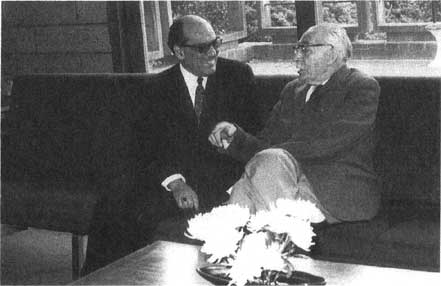
Mr. Faizi chats with Mr. Bernard Leach before a press interview at International House, Tokyo, 1967.
During his second visit, Mr. Faizi went to Sapporo, Hokkaido, where a public meeting had been arranged at the Daiichi Hotel. There was also a meeting at the Hazira just for Bahá'ís. Then he went to Shiraoi, and spoke in the new Hazira there to an audience of sixty people largely of Ainu background. The principal of the high school invited him to speak to the students. Mr. Faizi's visit was reported in several newspapers.
The last visit of Mr. Faizi was in 1970. Most of his time was spent in the Kansai area. The Bahá'ís flocked around him and literally sat at his feet as he gave his unique deepenings.
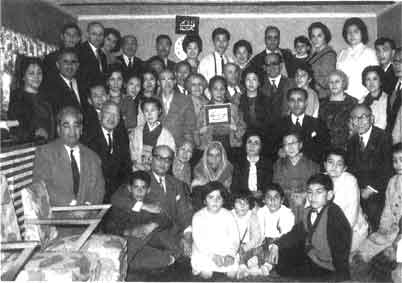
click here for larger image
Mr. Faizi, with dark glasses, standing in the second row from the rear, was speaker at a meeting in Kansai, 1963. All the Persians and many Japanese Bahá'ís attended.
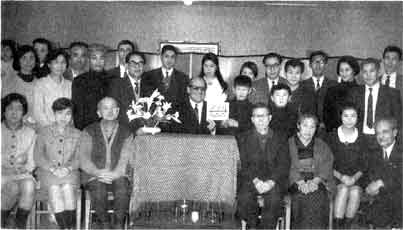
click here for larger image
249
Mr. Featherstone gave many ideas to follow, and helped us make our first proclamation "kits" to give to newspapers and prominent people.
He told us that when he and his wife made their pilgrimage in 1953, the Guardian had spoken about the spiritual axis between Japan and Australia. Mr. Featherstone, being Australian, said he always felt a special connection with the Bahá'ís of Japan.

click here for larger image
The Ninth Annual Convention of the Bahá'ís of North East Asia, 1965. It was the first visit to Japan of Hand of the Cause Mr. Featherstone. It was the last convention Miss Alexander was able to attend. They are sitting in the front, middle, holding a photograph of 'Abdu'l-Bahá.
Mr. Featherstone and Counsellor Mumtazi met with the National Spiritual Assembly of the Bahá'ís of North East Asia in 1968, and then went out to the garden of the Bahá'í Center to have this photograph taken.From the left. Mr. Abbas Katirai, Mr. Masazo Odani, Dr. Ikuo Mizuno, Mrs. Barbara Sims, Mr. Featherstone, Mr. Philip Marangella, Mr. Rouhollah Mumtazi, Dr. Toshio Suzuki, Mr. Hideya Suzuki and Mr. Eugene Schreiber. One member of the national spiritual assembly was not present.
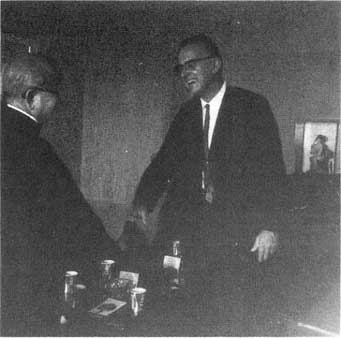
251
He spent time in the Kansai area, went to Hiroshima, and visited Takamatsu on the island of Shikoku. He appeared to be frail, but could call upon a store of spiritual energy that astounded us.
He visited Miss Alexander who was in a Tokyo hospital where she had been for a year with a broken hip. They were joking about which one of them was older. He was by one year, but he told her he would give her the honor!
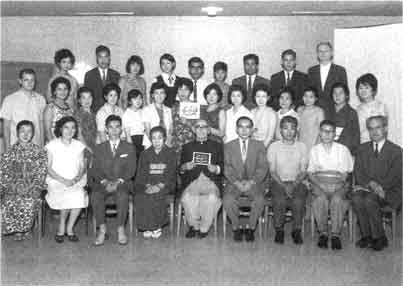
click here for larger image
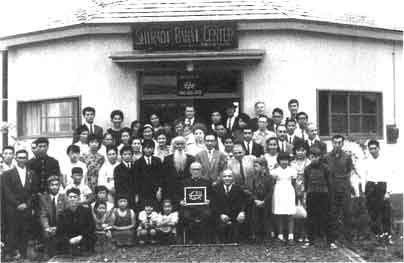
click here for larger image

click here for larger image

click here for larger image
Mr. Samandari spoke at the "Lighthouse" in Kyoto, October 1966. Many Bahá'í meetings had been held on the Kyoto Blind Association premises. Mr. Torii, who is sitting next to Mr. Samandari, was president of the Blind Association.
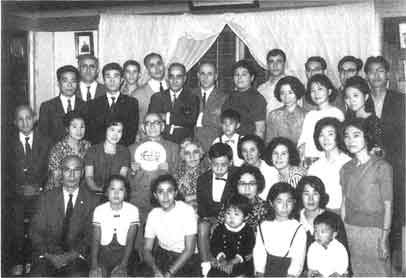
click here for larger image
Mr. Samandari (seen holding the plate) in Hiroshima.

Mr. Samandari visited Mr. Michitoshi Zenimoto in the Hiroshima Municipal Hospital where he was undergoing prolonged medical treatment. Years later Mr. Zenimoto told of this visit, "Mr. Samandari read a healing prayer, and told me that there was no power stronger than prayer. If we trusted in Him, He would answer, and we would know it was true. Now I know that."Mr. Heshmat Vahdat, who accompanied Mr. Samandari that day, is on the left.
Hand of the Cause Mr. Samandari with the National Spiritual Assembly of North East Asia, 1966. Seated are Mrs. Sims, Dr. Mizuno, Mr. Samandari and Mr. Marangella. Standing are Mr. R. Mumtazi, Mr. Yamazaki, Mr. Katirai, Mr. Moghbel, Mr. Odani and Mr. H. Suzuki.
click here for larger image

click here for larger image
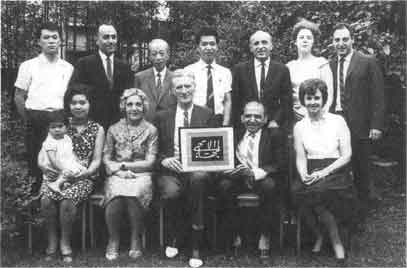
click here for larger image
Hand of the Cause Paul Haney in Tokyo. Seated are Mrs. Chiyo Suzuki holding Rieko, Mrs. Kazempour, Mr. Haney, Mr. Marangella and Mrs. Sims. Standing are Dr. T. Suzuki, Mr. Moghbel, Dr. Mizuno, Mr. H. Suzuki, Mr. Mumtazi, Miss Ruth Walbridge (Suzuki) and Mr. Schreiber.
Mr. Robarts, with the counsellors, met with the National Spiritual Assembly of North East Asia to discuss the goals of the Nine Year Plan. There were meetings in the Tokyo area, including one public meeting. The Bahá'ís rejoiced at his presence at the Summer School.
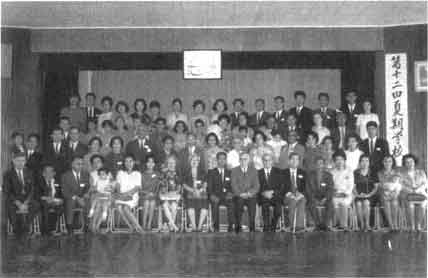
click here for larger image
The Twelfth Summer School, Awaji Island. Hand of the Cause Mr. Robarts is in the middle, sitting. On the left and right of him are newly-appointed counsellors Mr. Samaniego and Mr. Mumtazi.
When he first came to Japan, in 1969, he said he loved the country and would return. He came three more times — in 1971 when he represented the Universal House of Justice at the Oceanic Conference in Sapporo, and again in 1976 and 1977. During those visits he travelled extensively attending press conferences, public meetings, a teaching conference, a deepening conference sponsored by the Continental Board of Counsellors, an autumn school and many smaller meetings. During his visits he met almost all the Bahá'ís in Japan and his depth, wit, and humor surely touched all.
During his visit in 1976, Mr. Furutan, with his son-in-law Dr. Muhajir, met with the National Spiritual Assembly of the Bahá'ís of Japan. The following photographs were taken during his 1969 visit.
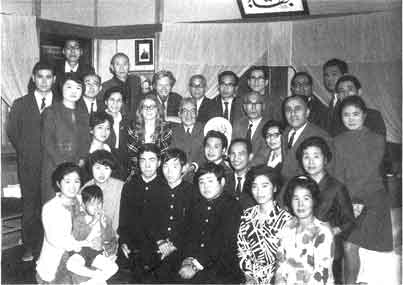
click here for larger image
Mr. Furutan, with a typical big smile, sitting in the middle, at a meeting in the Hiroshima Bahá'í Center.
Mr. Furutan, sitting second from the left, is shown here with eight members of the national spiritual assembly and Counsellor Mumtazi, sitting to the left, in the garden of the old Tokyo Bahá'í Center.
Mr. Enoch Olinga was appointed Hand of the Cause in 1957. Japan had the honor of his visit in December 1970. His first evening was spent at the Tokyo Hazira where a party had been arranged for him to meet all the Bahá'ís in the area.
He also met with the national spiritual assembly while he was in Tokyo. Accompanied by Counsellor Mumtazi, he went to Hokkaido, and was guest of honor in three different communities, Shizunai, Shiraoi and the Urakawa area. He was the only Hand of the Cause to visit the latter area. All the Bahá'ís in the community, twenty-one, and some of their friends, gathered at the local spiritual assembly chairwoman's house to hear him. There was such a spirit of unity that one person declared her belief in Bahá'u'lláh.
In Sapporo there was a good press interview printed in the largest Hokkaido newspaper.
From Hokkaido in the north, Mr. Olinga then went south to Kobe, where he spoke at the university, on Africa and economics, bringing in the Bahá'í viewpoint. He then went to Ashiya, and later Nagoya for meetings.
The effect of the Hand of the Cause coming from far-away Africa was a unique experience for Japanese and pioneers alike.

Hand of the Cause Mr. Enoch Olinga at the Tokyo Bahá'í Center.

Mr. Olinga (with the light over his head), in the predominately Ainu town of Anecha, Hokkaido. The woman sitting on the left has the traditional tattoo around her mouth. That custom is not followed these days.
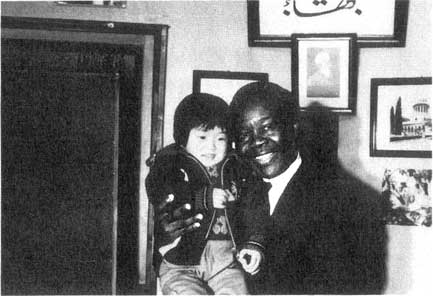
261
It was actually the eighteenth annual convention in Tokyo, but the first for the National Spiritual Assembly of Japan.
We were most eagerly looking forward to Mr. Sears' presence, but we were a little worried that the Japanese friends, or even the translators, would not be able to catch his rapid-fire, highly eloquent style of English. He didn't change his style, but somehow everyone understood him.
He met with the new national spiritual assembly and had other meetings in Tokyo, the Osaka area, Hiroshima and Ube. He visited the homes of several Japanese Bahá'ís: Dr. Suzuki, Mr. Kobayashi (Ube) and Mrs. Noriko Fujii, to mention some.
He and his wife, Marguerite, captivated the Bahá'ís of Japan completely.
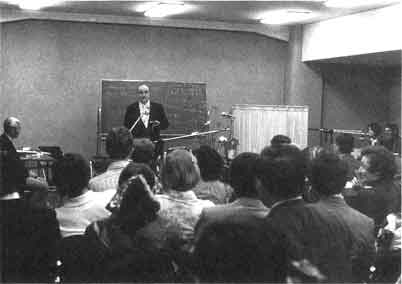
click here for larger image
Hand of the Cause Mr. William Sears addressing the assembled delegates and friends at the first National Convention of the Bahá'ís of Japan, 1974.
Hand of the Cause Mr. William Sears and his wife (center), attend the first National Convention of the Bahá'ís of Japan, 1974.
Amatu'l-Bahá Ruhiyyih Khanum was appointed Hand of the Cause in 1952, after the passing of her father, Hand of the Cause Sutherland Maxwell. She made two visits to Japan. The first was in 1977. She became ill and stayed only one week during which time she was able to attend only two or three activities. However, she said she would return. She did, the following year, with great energy. She stayed nine weeks and visited thirty-six cities and towns on the four major islands of Japan. Many meetings were arranged in various localities so that every Bahá'í in Japan would be within easy traveling distance to see her. She met with numerous mayors, governors and other prominent people and had several press interviews — one of the best was with the Asahi Shimbun which has a circulation of 7.5 million all over Japan.
During her visit, a pioneer conference was held in Ashiya. Every pioneer and spouse was invited to attend. Accommodations were provided by the ever-gracious Mumtazi family. About seventy people came even from remote areas such as Hokkaido
Mrs. Violette Nakhjavani was traveling with Ruhiyyih Khanum and she attended all meetings, including the one with the national spiritual assembly. She also spoke at fireside meetings.
A high point of Ruhiyyih Khanum's trip to Japan was a visit with Prince Mikasa, brother of the Emperor, and his wife Princess Mikasa.
Ruhiyyih Khanum said later that Prince Mikasa was especially interested in her accounts of meeting with Bahá'ís of the minority groups (Ainu and Buraku) in Japan.
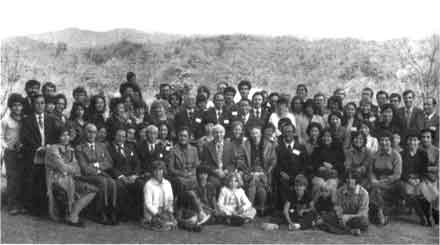
click here for larger image
The National Teaching Conference in Onoda, Japan, 1978. Ninety-five Bahá'ís attended in all. Ruhiyyih Khanum is sitting near the middle, wearing a coat and veil. Counsellor Samaniego is to the right. Counsellor Mumtazi is sitting to the left and Mrs. Nakhjavani is next to him.
Ruhiyyih Khanum meets Dr. Kimiyo Michi, president of Japan Women's University, the oldest university for women in Japan. It was in the founder's notebook that 'Abdu'l-Bahá wrote a prayer for Japan, 1912.From the left are two teachers, then Ruhiyyih Khanum, Dr. Michi, Mrs. Nakhjavani, Miss Iwakura and another teacher.
Ruhiyyih Khanum has tea at the lovely farm home of Mr. Takumi Fujiwara, (shown here), the first Bahá'í of Kaita, Hiroshima Prefecture.
click here for larger image
All the pioneers in Japan were invited to a conference in Ashiya to meet and hear Ruhiyyih Khanum. She is sitting in the middle.
Ruhiyyih Khanum speaks at a United Nations Day meeting in Sagamihara. To the left is the chairman, Mr. Hiroshi Yamazaki. Seated are Ruhiyyih Khanum and Mrs. Kimiko Schwerin, Auxiliary Board Member, who was translating. This photograph was taken in 1977 at one of the few events Ruhiyyih Khanum was able to attend during the week she was in Japan for the first time.

This photograph shows the first Japanese woman to become a Bahá'í , Mrs. Yuriko Furukawa with Ruhiyyih Khanum. They had first met over fifty years earlier, when Mrs. Furukawa, known then as Yuri Mochizuki, went to France to study.
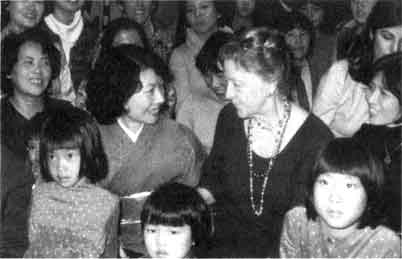
click here for larger image
267
At that time we couldn't have known that the next time some of us would see him, we would meet in the Holy Land and he would be a member of the Universal House of Justice. He was elected to the Universal House of Justice in 1982 in a by-election after the passing of Mr. Amos Gibson.
Mr. Hushmand Fatheazam, member of the Universal House of Justice since its election in 1963, came to Japan in 1977 as a representative of that Divine Institution. Although we were working hard to spread the Faith, it was not going as well as could be expected for such a dynamic country as Japan.
Mr. Fatheazam had many things to say to us. One thing we especially remember was that although the Faith in Japan was established by pioneers, it should grow according to the cultural and indigenous exigencies — that Bahá' i meetings should not
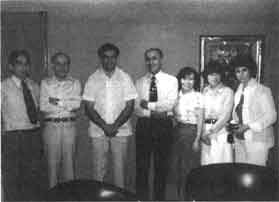
click here for larger image
A meeting in Tokyo 1977 with Universal House of Justice member Mr. Hushmand Fatheazam, third from the left. Counsellor Mumtazi is second from the left. Others are national spiritual assembly members: left, Mr. Yamaguchi. Next to Mr. Fatheazam is Mr. Moghbel, then Miss Iwakura, Miss Fushimi and Mrs. Sims.
Chapter 83
During the lifetime of 'Abdu'l-Bahá, only Japan and the Hawaiian Islands were opened to the Faith in the North Pacific area. That is, only those two areas had resident Bahá'ís. In the South John Henry Hyde-Dunn and his wife Clara Davis Dunn had settled in Australia in response to 'Abdu'l-Bahá's desire for Bahá'ís to arise to spread the Faith throughout many different areas and countries.
'Abdu'l-Bahá wished to do this Himself, but he could not. When the Dunns read of 'Abdu'l-Bahá's wish they wrote to Him of their desire to go to Australia. He cabled back "Highly advisable". The Dunns established themselves in Australia in 1920. The first local spiritual assembly was formed there in 1923, and the National Spiritual Assembly of the Bahá'ís of Australia and New Zealand was elected in 1934.
According to accounts we can find, it was in the Guardian's message to the Asian Intercontinental Teaching Conference in New Delhi, India, 1953, that the first indication was given that Japan and Australia were perhaps linked. The Guardian wrote (in part), "These opening stages in the evolution of His Faith in the Asiatic continent were followed, while the first and Apostolic Age of His Dispensation was drawing to a close, by the opening of the Islands situated in the Pacific Ocean, Japan in the north and the Australian continent in the south."
This was the first Intercontinental Teaching Conference in Asia or the Pacific area, and it dealt with teaching and goals to be accomplished on the Asiatic mainland, the Australian continent and the islands of the Pacific.
Close to five hundred Bahá'ís attended the conference in New Delhi, coming from thirty-one countries. There were many Australians, but no Japanese, to hear this message. At the Guardian's
After the launching of the Ten Year Crusade several Bahá'ís returning from pilgrimage in the Holy Land reported in their notes that the Guardian said Japan and Australia must associate and that the two countries formed north and south magnetic poles in the Pacific. Mr. Collis Featherstone and his wife were among those who reported such comments by the Guardian. In other discussions during 1953 and 1954 the Guardian referred to Japan and Australia as the bastions of the Pacific.
At the time there were no national spiritual assemblies in the Pacific north of Australia and very few local spiritual assemblies. As for Japan, there was one local spiritual assembly and only a handful of believers. What the Guardian was referring to seemed to be far in the future.
Japan and Australia were, and still are, separated by vast physical distance, and culturally, by perhaps an even greater distance. One country small geographically with a huge population; the other large in area but with one-fifth the population. One oriental and the other occidental; a country with a long history going back thousands of years and the other less than two hundred years old; one with traditional religious values and the other with no tradition.
In his last letter to the National Spiritual Assembly of Australia, 1957, the Guardian wrote, "The emergence of a new Regional Spiritual Assembly in the North Pacific Area (National Spiritual Assembly of North East Asia), with its seat fixed in the capital city (Tokyo) of a country which by reason of its innate capacity and the spiritual receptivity it has acquired, in consequence of the severe and prolonged ordeal its entire population has providentially experienced, is destined to have a preponderating share in awakening the peoples and races inhabiting the entire Pacific area, to the Message of Bahá'u'lláh, and to act as the Vanguard of His hosts in their future spiritual conquest of the main body of the yellow race on the Chinese mainland — the emergence of such an assembly may be said to have, at long last, established a spiritual axis, extending from the Antipodes to the northern islands of the Pacific Ocean — an axis whose northern and southern poles will act as powerful magnets, endowed with exceptional spiritual potency, and towards which other younger and less experienced communities will tend
"A responsibility, at once weighty and inescapable, must rest on the communities which occupy so privileged a position in so vast and turbulent an area of the globe. However great the distance that separates them; however much they differ in race, language, custom and religion; however active the political forces which tend to keep them apart and foster racial and political antagonisms, the close and continued association of these communities in their common, their peculiar and paramount task of raising up and of consolidating the embryonic World Order of Bahá'u'lláh in those regions of the globe, is a matter of vital and urgent importance, which should receive on the part of the elected representatives of their communities, a most earnest and prayerful consideration."
We saw the concept of an axis become a reality when the Guardian assigned several countries to be under the National Spiritual Assembly of North East Asia. The Guardian wrote to the first National Spiritual Assembly of North East Asia, ". . . The rise and expansion of the Administrative Order of the Faith in the northern regions of the vast Pacific Ocean fills a great gap, and constitutes a notable parallel to the rise of similar institutions in the Antipodes, establishing thereby a spiritual equilibrium destined to affect, to a marked degree, the destinies of the Faith throughout the islands of the Pacific Ocean, in the years immediately ahead. It should be hailed, moreover, as a momentous development paving the way for the eventual introduction of the Faith into the far-flung Chinese mainland and, beyond it, to the extensive territories of Soviet Russia."
Clearly the axis was established.
The Universal House of Justice has referred to the spiritual axis between Japan and Australia, quoting the words of the Guardian. In 1981 during the second phase of the Seven Year Plan the Universal House of Justice when referring of the accomplishments in the Pacific area called upon the Japanese community to witness the potency of the power released through the establishment of that spiritual axis.
To the Asian/Australian Bahá'í International Conference in Canberra, Australia, 1982, the Universal House of Justice again reminded the Bahá'í world of the spiritual axis, stating that the words of the Guardian were as valid a quarter of a century later as they were when they were written.
A high point was a joint meeting of the National Spiritual Assemblies of Japan and Australia.
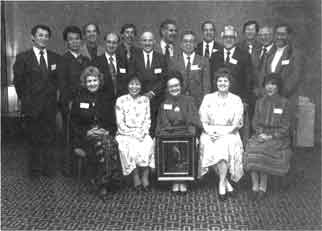
click here for larger image
A joint meeting of the National Spiritual Assembly of Japan and the National Spiritual Assembly of Australia, and the counsellors in the area, Canberra, 1982.Seated from the left: Mrs. Barbara Sims, Miss Nobuko Iwakura, Mrs. Janet Khan, Mrs. Beverley Stafford and Miss Tomo Fushimi. Standing: Dr. Toshio Suzuki, Counsellor Hideya Suzuki, Mr. Stanley Bolton, Mr. Hiroyasu Takano, Dr. David Chittleborough, Counsellor Rouhollah Mumtazi, Mr. Aflatoon Payman, Mr. Yuzo Yamaguchi, Counsellor Peter Khan, Mr. Abbas Katirai, Dr. John Davidson, Mr. Pieter De Vogel, and Dr. Ray Meyer. The photograph Mrs. Khan is holding is of the first Bahá'í in the Pacific, Miss Alexander.
Afterword
Miss Agnes Alexander left a large quantity of papers, letters, and photographs regarding the Faith in Japan to the National Archives in Tokyo. She also left the manuscript of a book, "History of the Bahá'í Faith in Japan 1914-1938", which was printed by the Bahá'í Publishing Trust, Japan, in 1977. Many of the photographs and much of the information regarding the very early days have come from Miss Alexander's effects. We are indeed indebted to her for her sense of history and for so carefully preserving the precious records.
Also much of the material, both photographs and accounts, has come from other sources, collected and researched over a period of several years. For example, Mrs. Ito Torii, widow of Mr. Tokujiro Torii, gave all her husband's Bahá'í papers to the National Archives. We also drew upon her memory for some accounts. Mrs. Yuri (Yuriko) Mochizuki Furukawa, born in 1900, the first Japanese woman to become a Bahá'í, searched her memory to help us identify some of the people in old photographs and to give added information. Another person who contributed to the material written in the section on the early days was Mrs. Fukuko Aibara, widow of Miss Alexander's friend Mr. Susumu Aibara. Miss Elahe Katirai quite accidentally met her in an art class in Kobe. Mrs. Aibara was delighted to meet the Bahá'ís again after some forty-five years, and she reaffirmed her Faith.
Regarding Mr. Torikai, the third Japanese to become a Bahá'í, the information and photograph are the result of an extensive search, as originally we had little information and no photographs of him. We were just very curious as to who he was and what happened to him. After searching through the records of emigrants to the United States in the early 1900s, we eventually located his relatives in Japan, who were very helpful in filling in information.
The material on Beatrice Lane Suzuki, wife of the famous Zen Buddhist writer and scholar, Daisetz Suzuki, was found by accident. (The unusual spelling of his first name was his preference.) We happened to read in a very early Bahá'í News that Miss Beatrice Lane married Daisetz Suzuki. Suzuki is one of the most popular names in Japan and we couldn't be sure who he was. Scanning through Daisetz Suzuki's many books in English
As for the later years, we were very fortunate in having somewhat complete records, that is, local and national spiritual assembly records, letters and minutes, some going back to 1950, which are stored at the Tokyo Haziratu'l-Quds. Much of the material written for the later days came from these records. But they were not always complete. Often events were not recorded or preserved, so unavoidably there will be omissions. Sometimes we found discrepancies between the facts as recalled years later, and the facts as written at the time.
Writing even an abbreviated history is a rather subjective undertaking, however the compiler has tried to list events and information as they were researched. But the compiler herself was part of the process, from December 1953 to the present, and she has made use of her own memories, records and photographs.
We had to choose how much detail to put in the book and to what depth. We decided not to try this time to write a longer history, but more or less to continue with our original idea to make a book to preserve the photographs, along with explanations, primarily for future generations of Japanese Bahá'ís.
Many of the details seemed to put themselves in, especially when we heard someone's moving story, or read an interesting account. But for every written sketch there are many left unwritten; we didn't have the account or didn't hear the story. For these we are truly sorry as they are also part of the history.
We have tried to mention, if only once, the names of the very early Bahá'ís, both Japanese and foreign pioneers. But many names will be unintentionally omitted. Through the years there have been well over two hundred foreign Bahá'ís in Japan at various times and close to three thousand Japanese.
The ninth and eleventh paragraph of the talk given by 'Abdu'l-Bahá to the Japanese Independent Church, October 7, 1912, in Oakland, California (Ch. 1), is a more accurate translation of the original talk which was given in Persian. Therefore it differs a little from the translation in the compilation "The Promulgation of Universal Peace", Vol. II. The revised translation was
We did not try to use the official transliterations of the Persian names but have mainly kept the spelling used by the individuals involved. This is also true for the transliteration of the Japanese names. For example, Mr. Kikutaro Fukuta spelled his last name with a "t", although the usual spelling these days is with a "d". As for the first names of women, in the post-war period it became popular to add the feminine ending "ko" to the name. Thus in the early days Mrs. Furukawa was called "Yuri" but in records in the later years it had become "Yuriko".
It was suggested to take the contents up to the time of the Bahá'í International Conference in Canberra, Australia, 1982, during which time the spiritual axis between Japan and Australia was given prominence. Other than that, we have mentioned the 1980s only occasionally, and not written much about 1970s. The results of the pioneer efforts in the late 1940s, 50s and 60s were what laid the foundation for the Faith as we see it now in Japan. We will leave the later history to another writer.
In the 1970s and 1980s, as the world economy improved and travel became usual, pioneers came to Japan at an ever-increasing rate, and the Faith continued its growth. Those years saw more Japanese Bahá'ís come to the forefront to mention the Name of Bahá'u'lláh in their country. Those years also saw the Japanese Bahá'ís play the main role in the strengthening of the administration with the pioneers becoming their assistants.
As we look back at the history, it seems that Miss Alexander's era as she prayerfully labored to establish the Faith was extremely difficult, although she never perceived it as such. It can also be noted that many of the unique opportunities available to her in the very early days have not been available to the foreign Bahá'ís who later came to Japan to help reestablish the Faith.
The compiler interviewed many people, borrowing from their memories and their photographs. In addition to the people mentioned earlier, we owe appreciation for contributions of information or photographs to Mr. Shinji Yamamoto, Mr. Kinkichi Shimatani, Mrs. Kotoko Mochizuki Honma, Mr. Hiroyasu Takano, Mr. Yuzo Yamaguchi, Mr. Kazutomo Umegae, Mr. Abbas Katirai and family, Mr. Ataullah Moghbel and family, Mrs. Sandra Sims Fotos, Mrs. Noriko Matsuura Fujii, Mr. Yoshio Tanaka, Ms. Ichi Kamichika, Mrs. Haruko Mori Shibaya, Mr. and Mrs. Haruo Nekomoto, Mrs. Yukiko Inatsuka
We made use of the International House Library and the Tokyo City Library. Japan Women's University permitted us to copy the prayer of 'Abdu'l-Bahá which is being kept in the archives of their founder, Mr. Naruse. In addition to the National Archives in Tokyo, some material came from the Hiroshima Bahá'í Center Archives, and the Sapporo Bahá'í Center Archives, and material kept by the Local Spiritual Assembly of Kyoto. We were permitted copies of photographs from the International Archives at the Bahá'í World Centre in Haifa, Israel. We are indebted to Mr. Roger Dahl of the United States National Bahá'í Archives for so willingly copying some photographs.
Bibliography
Letters of Shoghi Effendi
Unpublished papers, letters, notes, minutes, photographs from the National Bahá'í Archives in Tokyo
"Japan Will Turn Ablaze!" Bahá'í Publishing Trust, Japan
"History of the Bahá'í Faith in Japan 1914-1938" by Miss Agnes B. Alexander
Bahá'í News of India, November 1923
Various issues of the Bahá'í News of the National Spiritual Assembly of the United States
Bahá'í News of Japan, various issues
Star of the West volumes
The Bahá'í World volumes
| start page |
|
|


